VANESSA SHIPPY
 MORGAN HOFFMANN LORYN GOODWIN GALLAGHER-IBA MIKE HOLDER ORANGE POWER STUDIOS
MORGAN HOFFMANN LORYN GOODWIN GALLAGHER-IBA MIKE HOLDER ORANGE POWER STUDIOS

Where smiles from strangers abound, hometown spirit is a way of life,

and cowboys really do ride off into the sunset.

Experience America’s Friendliest College Town!





IF YOU BUILD IT ...
BY KEVIN KLINTWORTH SENIOR ASSOCIATE ATHLETIC DIRECTOR
That response was more than an answer to the media. It might as well have been the mantra for OSU Athletics for more than a decade. For example — which home to an OSU varsity team will become the oldest when Cowboy Baseball program moves across the street in 2020?
How about the home of the golf programs? Karsten Creek opened in 1994.
By 2020 every other OSU Athletics facility will have been completely rebuilt (soccer, baseball, softball, track, tennis), will have undergone or be in the process of undergoing massive overhauls (Boone Pickens Stadium, GallagherIba Arena, equestrian, cross country) since 1994. Karsten Creek, by the way, is constantly undergoing enhancements as well.
Holder’s quote was more about attitude than bricks and mortar. Consider the challenges that faced OSU Football as it entered its first season in the Big 12 Conference in 1996. The Cowboys won a total of six Big Eight Conference games their last six years in the Big Eight (6-31-3) as facilities fell behind and the effects of probation lingered. And they were suddenly facing the reality of adding four Texas schools to the league rotation. It looked like a doomsday scenario for a program that was under .500 all-time. In fact, doomsday was what most experts were predicting.
But at some point Oklahoma State decided to be competitive in football and as Holder said, it was inevitable that it happened. OSU Football is virtually unrecognizable from its final years in the Big Eight, due to the financial investments of Boone Pickens, the vision of Mike Holder, the coaching of Mike Gundy and the contributions of many others along the way.

It wasn’t easy. Challenges are still constantly faced. Growing pains remain, even today.
But results similar to football have taken place within the men’s and women’s tennis programs, which also faced uphill battles in regard to tougher competition and facilities. The Greenwood Tennis Center has helped catapult both of those programs into the top ten (if not higher) nationally.
Facilities are not always the answer. They are just part of the equation and guarantee nothing. Making the decision is the important part.
THE PLAYBOOK
At the news conference unveiling Oklahoma State’s plans for a new baseball stadium, athletic director Mike Holder fielded a question about future building projects.
SPRING 2018 4
“WE HAVE DECIDED TO DO IT, SO IT’S INEVITABLE IT WILL HAPPEN.”
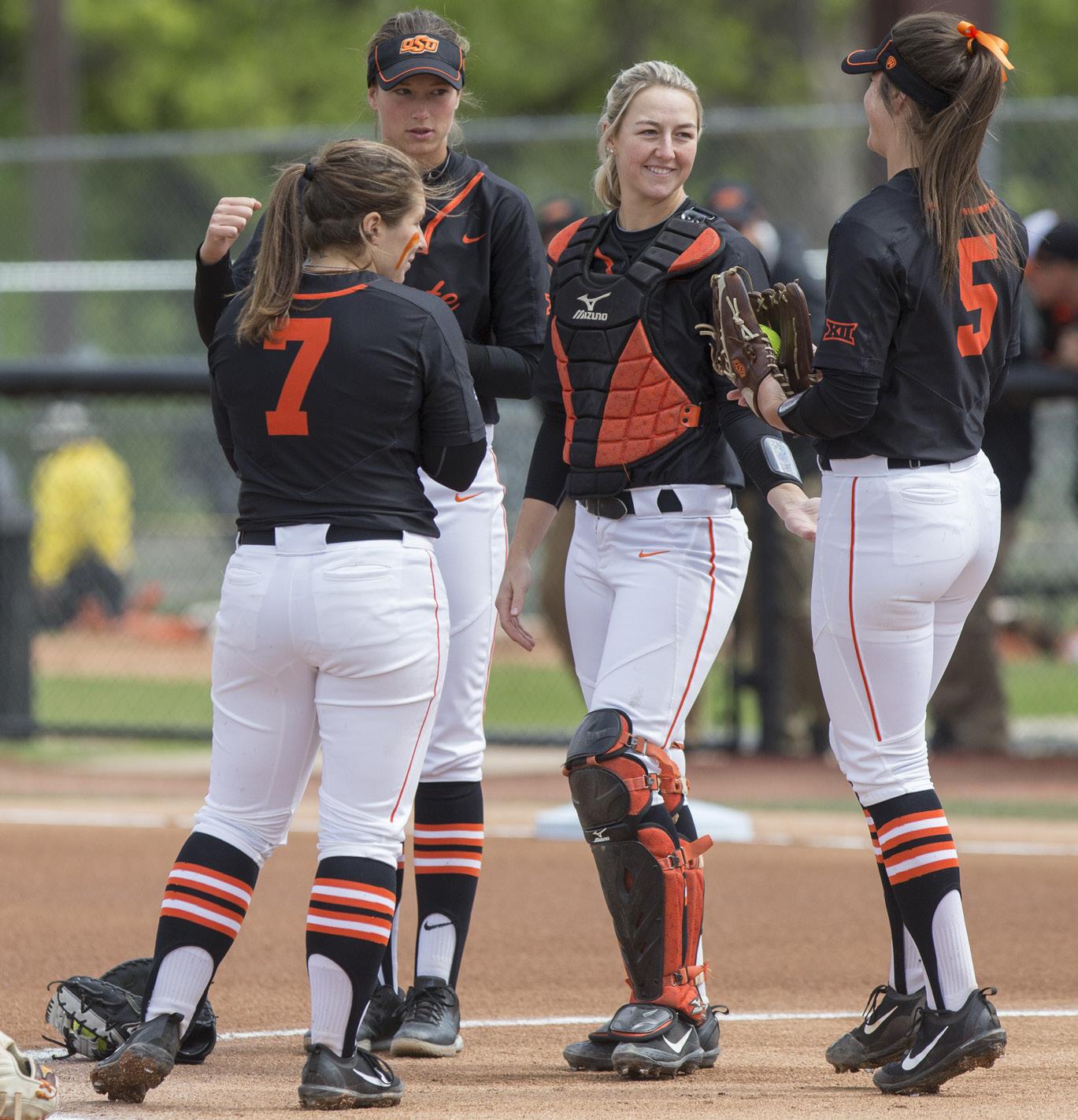
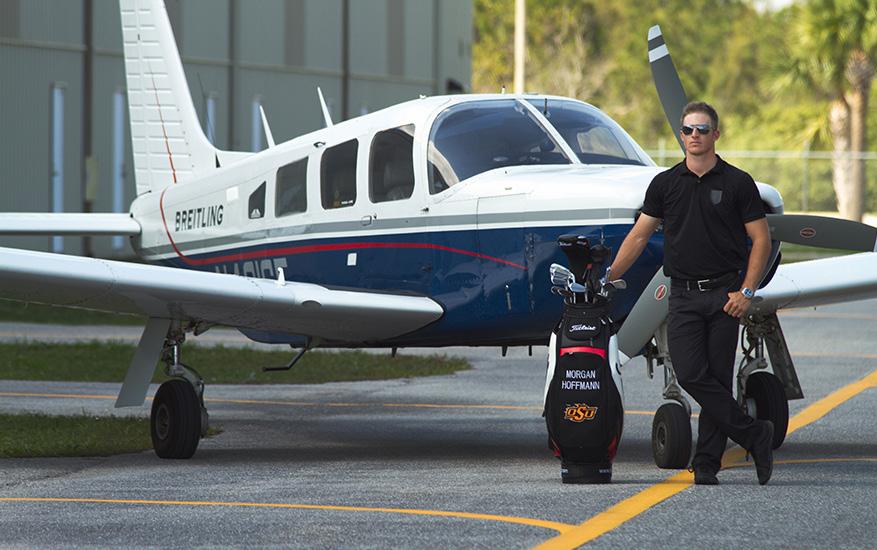
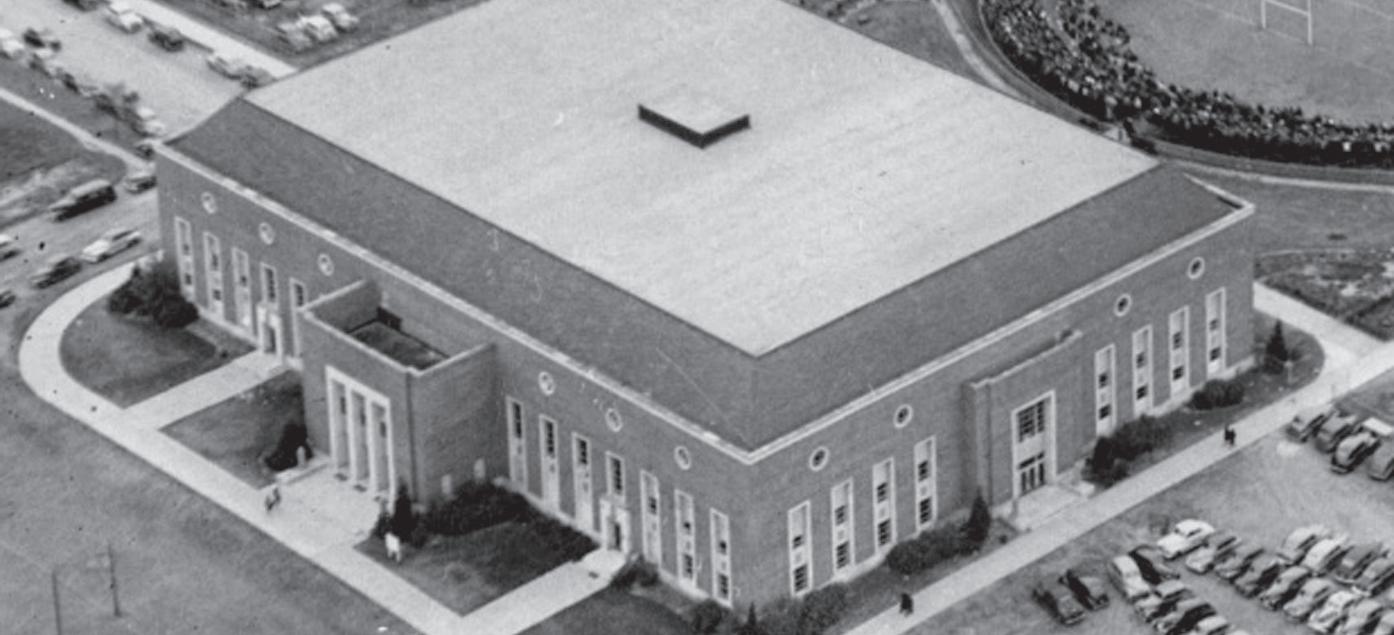
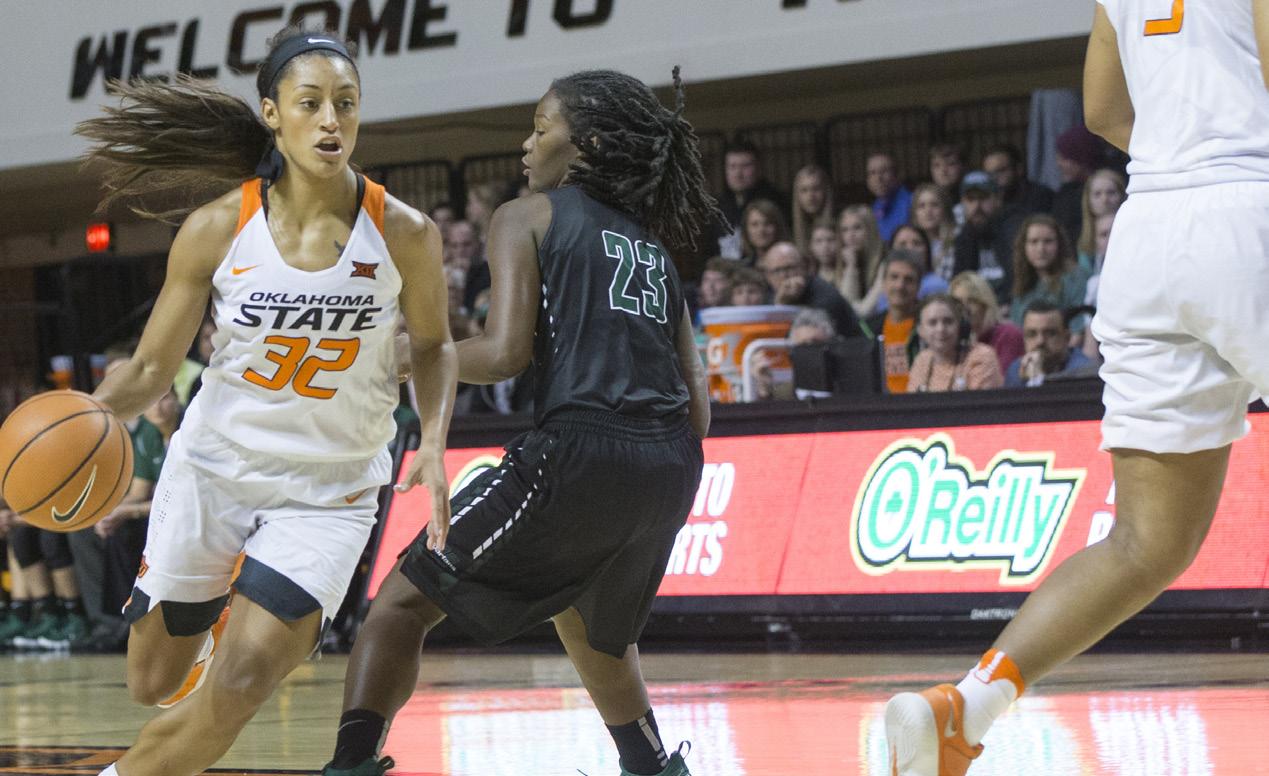
The 150 20 The Honor Roll 68 WRAVINGS Baseball Lessons 78 DEPARTMENTS MORGAN HOFFMANN Beyond the Golf MIKE HOLDER In the Words of Mike Holder GALLAGHER-IBA ARENA On the Corner of Duck and Hall of Fame ... LORYN GOODWIN The Long and Winding Road VANESSA SHIPPY MVP (Most Valuable Person) ORANGE POWER STUDIOS Through Orange-Colored Glasses 14 52 38 32 24 70 FEATURES
5
COVER PHOTO BY BRUCE WATERFIELD
Cowgirl track and field senior STEPHANIE FERRANTE and football graduate BRITTON ABBOTT were named the Oklahoma State Female and Male Scholar-Athletes of the Year at the annual Academic Awards Banquet.

Ferrante, a biochemistry and microbiology/cell and molecular biology double major, is set to earn her diploma in May with a 4.0 GPA. The sprinter has been named first team Academic All-Big 12 in addition to capturing two indoor conference titles in the Distance Medley Relay.

Abbott, a Cowboy Back on the gridiron, graduated Summa Cum Laude in December (3.9-4.0 GPA) and was the recipient of the football program’s Dr. L.L. Boger Award for academic achievement.
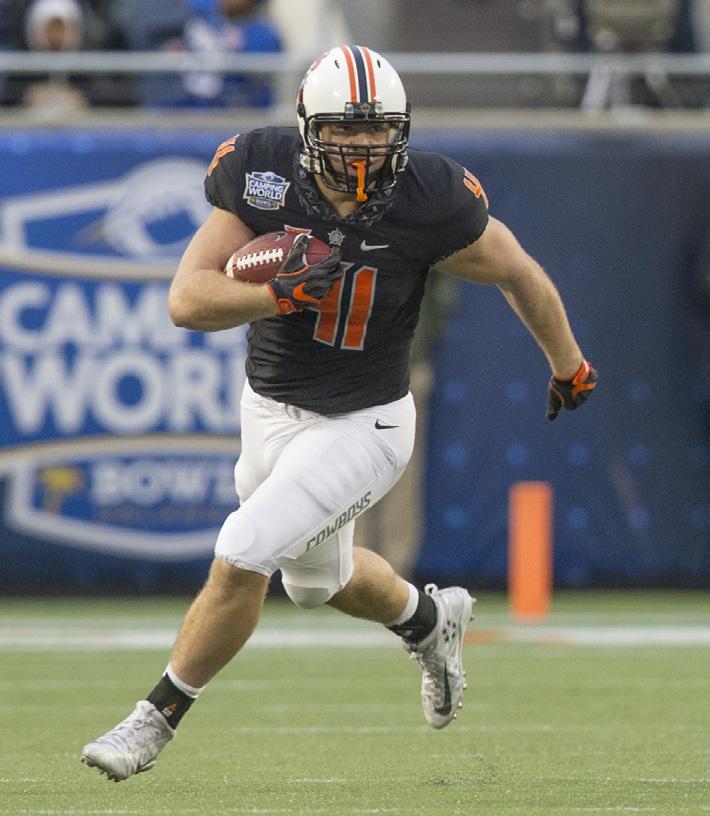
POSSE Magazine Staff
VICE PRESIDENT OF ENROLLMENT MANAGEMENT / MARKETING KYLE WRAY
EDITOR-IN-CHIEF / SENIOR ASSOCIATE ATHLETIC DIRECTOR KEVIN KLINTWORTH
SENIOR ASSOCIATE ATHLETIC DIRECTOR / EXTERNAL AFFAIRS JESSE MARTIN
ART DIRECTOR / DESIGNER DAVE MALEC
PHOTOGRAPHER / PRODUCTION ASSISTANT BRUCE WATERFIELD
ASSISTANT EDITOR CLAY BILLMAN
CONTRIBUTING PHOTOGRAPHERS GARY LAWSON, MELISSA MORALES, PHIL SHOCKLEY
CONTRIBUTING WRITERS CLAY BILLMAN, RYAN CAMERON TOM DIRATO, JOHN HELSLEY KEVIN KLINTWORTH, KYLE WRAY
Athletics Annual Giving (POSSE) Development Staff
ASSISTANT ATHLETIC DIRECTOR / POSSE DIRECTOR ELLEN AYRES
PUBLICATIONS COORDINATOR CLAY BILLMAN
ASSISTANT DIRECTOR, ANNUAL GIVING RYAN SEVERSON
COORDINATOR, ANNUAL GIVING STEPHANIE DAVIS
Athletics Major Gift Development Staff
SENIOR ASSOCIATE ATHLETIC DIRECTOR / DEVELOPMENT LARRY REECE
ASSISTANT ATHLETIC DIRECTOR, DEVELOPMENT MATT GRANTHAM
DIRECTOR OF DEVELOPMENT / OCLUB KEEGAN DAVIS
ASSISTANT ATHLETIC DIRECTOR, DEVELOPMENT SHAWN TAYLOR
OSU POSSE 102 ATHLETICS CENTER STILLWATER, OK 74078-5070 405.744.7301 P 405.744.9084 F OKSTATEPOSSE.COM @OSUFANEX POSSE@OKSTATE.EDU
ADVERTISING 405.744.7301 EDITORIAL 405.744.1706
At Oklahoma State University, compliance with NCAA, Big 12 and institutional rules is of the utmost importance. As a supporter of OSU, please remember that maintaining the integrity of the University and the Athletic Department is your first responsibility. As a donor, and therefore booster of OSU, NCAA rules apply to you. If you have any questions, feel free to call the OSU Office of Athletic Compliance at 405-744-7862 . Additional information can also be found by clicking on the Compliance tab of the Athletic Department web-site at www.okstate.com
Remember to always “Ask Before You Act.”
Respectfully,
BEN DYSON ASSISTANT ATHLETIC DIRECTOR FOR COMPLIANCE
Donations received may be transferred to Cowboy Athletics, Inc. in accordance with the Joint Resolution among Oklahoma State University, the Oklahoma State University Foundation, and Cowboy Athletics, Inc.
POSSE magazine is published four times a year by Oklahoma State University Athletic Department and the POSSE, and is mailed to current members of the POSSE. Magazine subscriptions available by membership in the POSSE only. Membership is $150 annually. Postage paid at Stillwater, OK, and additional mailing offices. Oklahoma State University, in compliance with Title VI and VII of the Civil Rights Act of 1964, Executive Order 11246 as amended, and Title IX of the Education Amendments of 1972 (Higher Education Act), the Americans with Disabilities Act of 1990, and other federal and state laws and regulations, does not discriminate on the basis of race, color, national origin, sex, age, sexual orientation, gender identity, religion, disability, or status as a veteran, in any of its policies, practices or procedures. This provision includes, but is not limited to admissions, employment, financial aid, and educational services. The following have been designated to handle inquiries regarding non-discrimination policies: Director of Equal Opportunity, 408 Whitehurst, OSU, Stillwater, OK 74078-1035; Phone 405-744-9154; email: eeo@okstate.edu. This publication, issued by Oklahoma State University as authorized by the Senior Associate Athletic Director, POSSE, was printed by Royle Printing Company at a cost of $1.136 per issue. 9.5M/Aprilr 2018/#7112.

POSSE magazine is published four times a year by Oklahoma State University, 307 Whitehurst
OK
The magazine is produced by OSU Athletics and University Marketing, and is mailed to current members of the POSSE Association. Membership starts at $150/year and includes benefits such as the POSSE Magazine and member auto decals. POSSE annual funds contribute to student-athlete scholarships and operating expenses, which are critical to helping our teams stay competitive. Gifts of all sizes impact all areas of athletics. Postage
at
and additional mailing offices.
Stillwater,
74078.
paid
Stillwater, OK,
POSSE MAGAZINE 2018 VOL.12 SPRING
SPRING 2018 6
LOOK
forthe LABEL
HELP OSU BY BUYING ONLY LICENSED PRODUCTS.

When you purchase licensed products, a portion of your purchase price goes to support scholarships and other university programs.
Oklahoma State University: Live Orange
@OSUGear
@OSUGear
Get information on new retailers, merchandise and promotions.

JOSH HOLLIDAY:
“Our vision was to build a facility that would allow us to develop players at the highest level, teach leadership concepts and principles, embrace the team concept and provide a first-class experience for our loyal fans and alumni … The end result was exactly what we wanted. We accomplished our goal, and it is beyond anything I could have envisioned.”

SPRING 2018 8


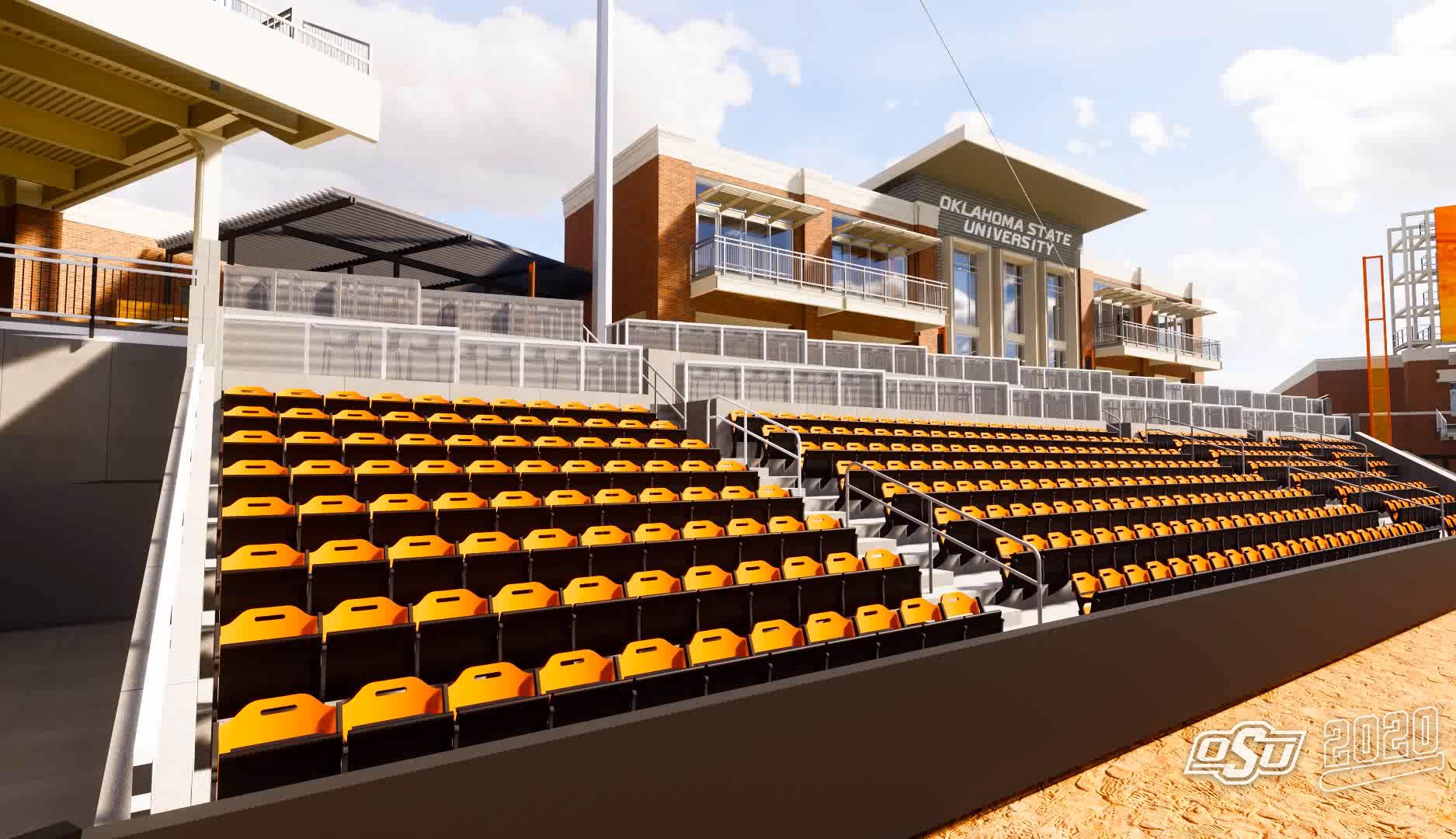
DIGITAL
THE
RENDERINGS: JIM HASENBECK/JOSHUA HILL, STUDIO ARCHITECTURE 03/29/18
NEW HOME OF COWBOY BASEBALL
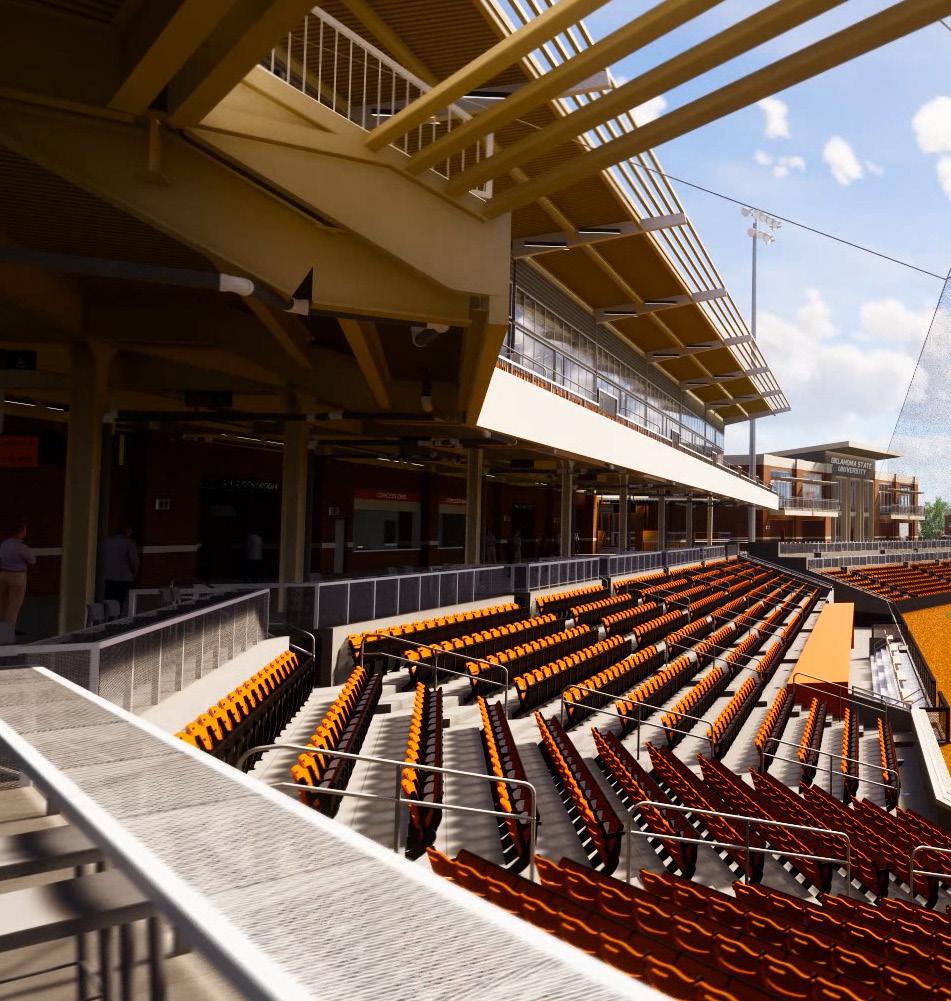
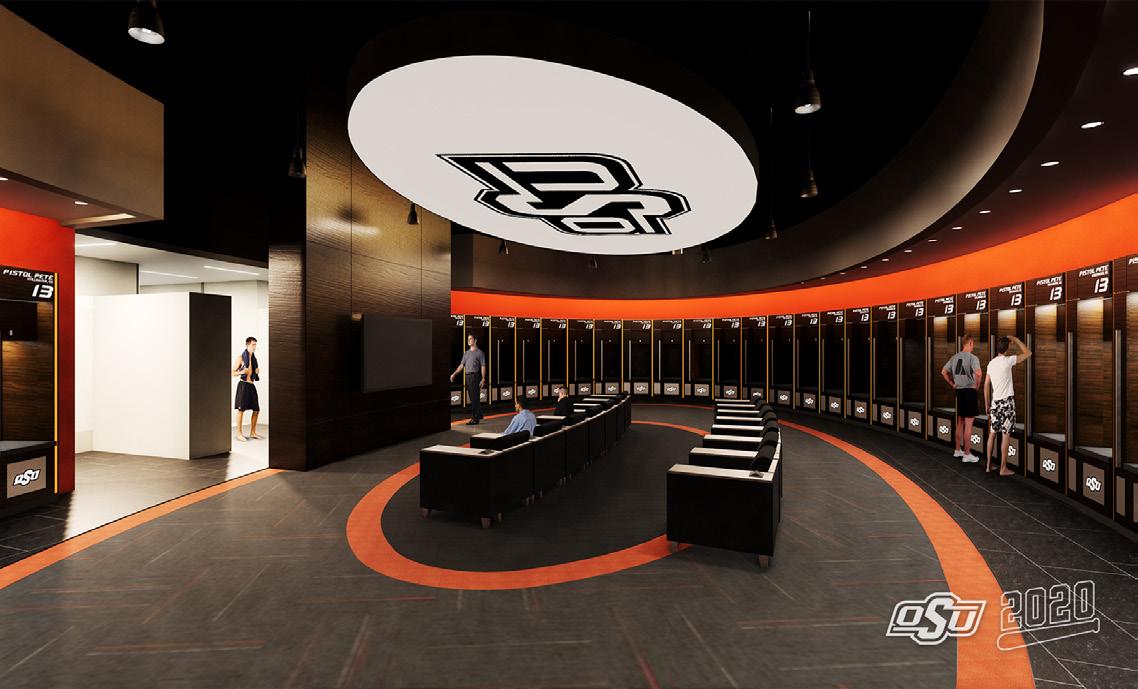

SPRING 2018 10
One of the most tradition-rich programs in college baseball is getting a state-of-the-art home at the corner of Washington Street and McElroy. Scheduled to open for the 2020 season, the Cowboys’ new stadium will include first-class amenities catering to fans and players alike:
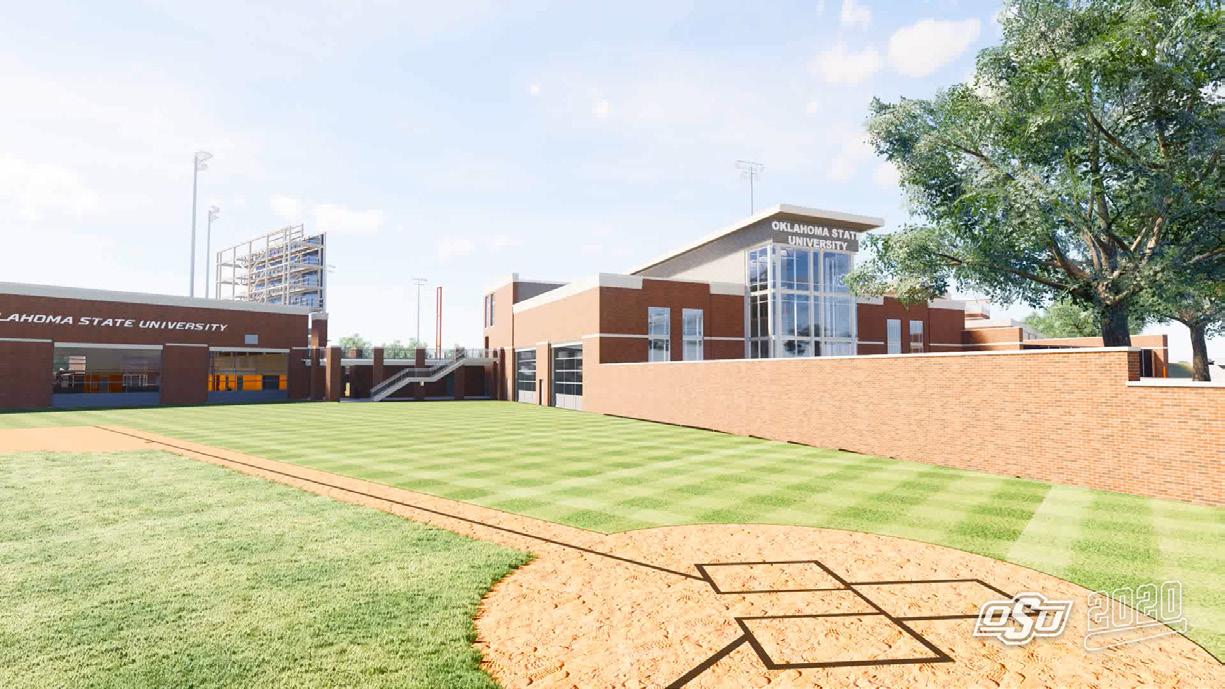
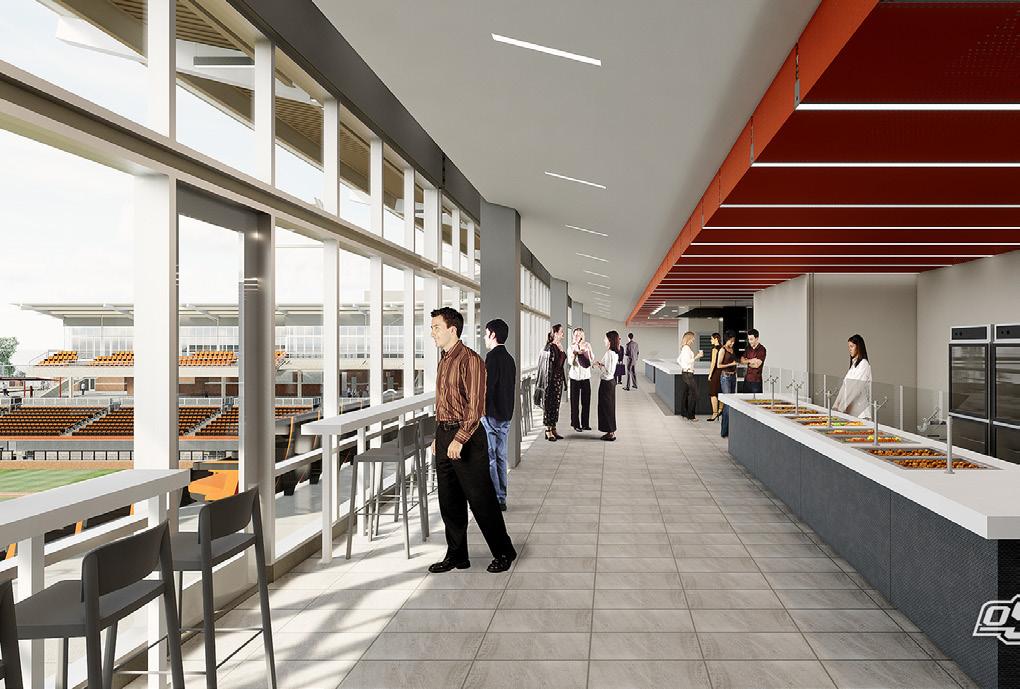

• 3,500 permanent seats
• Expandable to 8,000 capacity
• Premium seating areas (club/suite)
• State-of-the-art video board
• Dedicated student section
• Locker rooms and player lounge
• Team training facilities
• Outfield plaza
• Family areas and playground
• Natural grass field
A Nike Tri-Blend Scoop Elevated Essentials XS-XXL | $35 B Nike Tight XS-XXL | $65
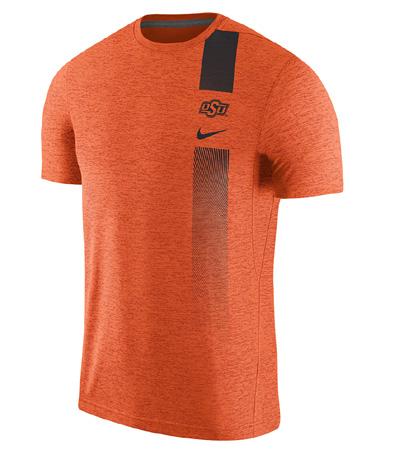
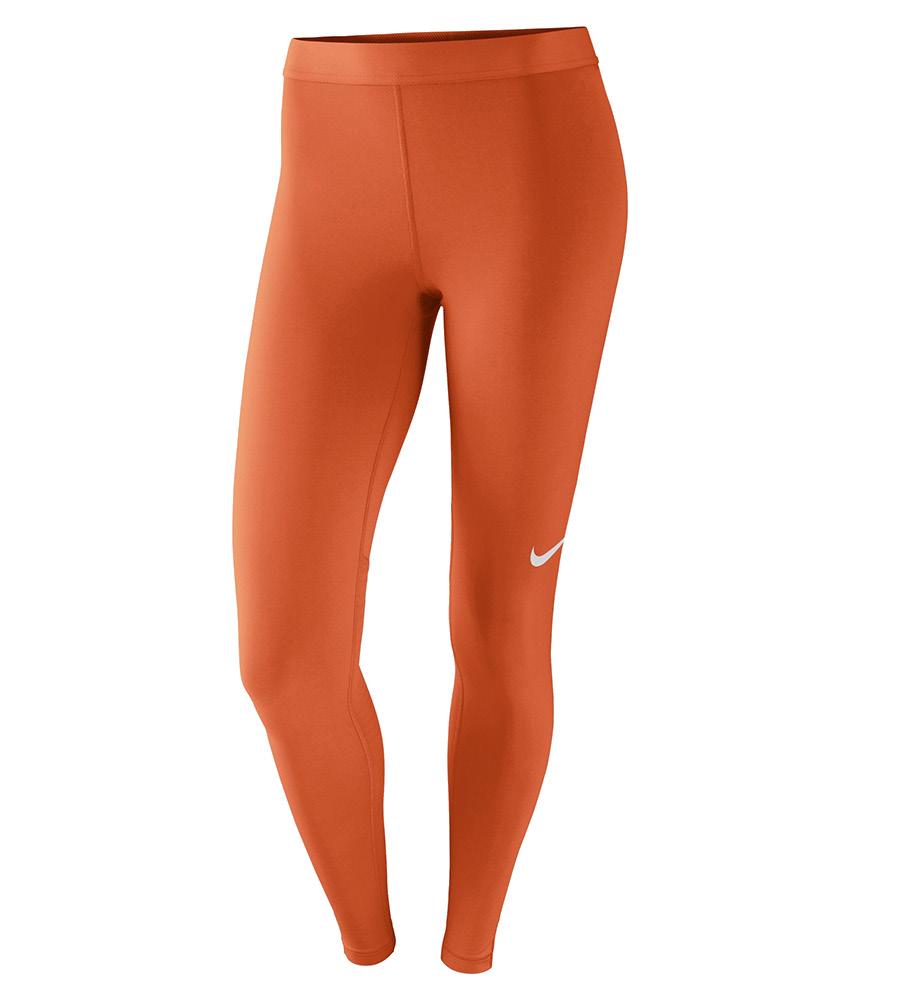
C Nike Gear Up Badge Short XS-XL | $39.99 D Nike Women’s Pete Tee XS-XXL | $35

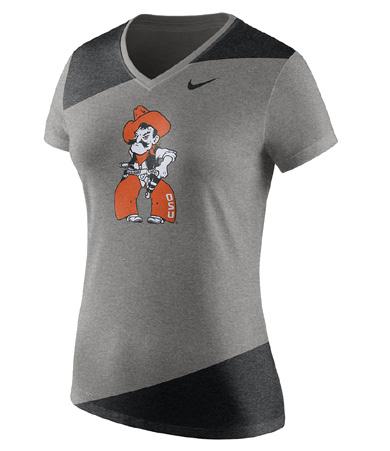
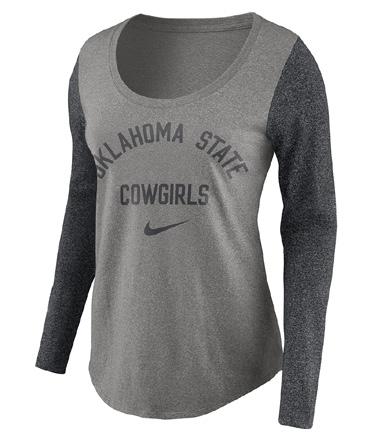

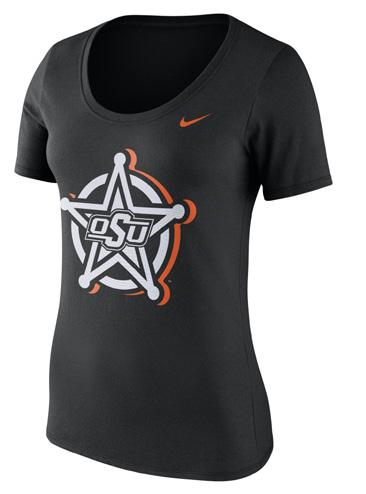
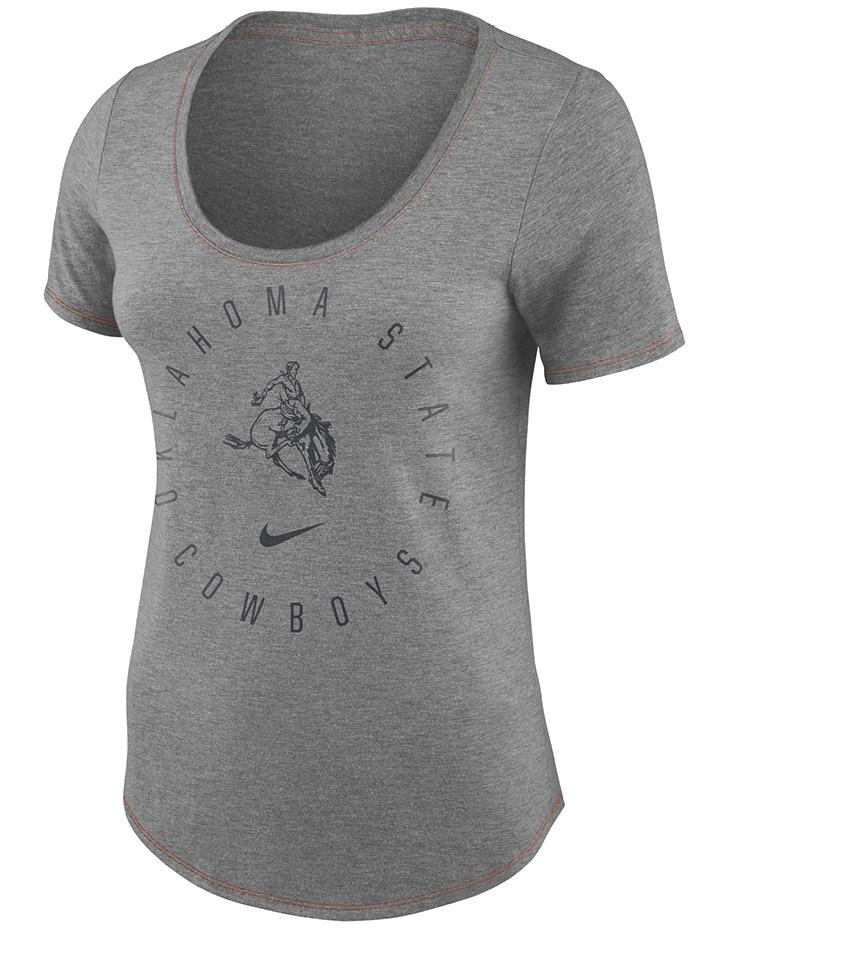
E Nike Dri-Fit Touch Tee S-3XL | $45 F Nike Tri-Blend Long Sleeve Scoop Elevated Essentials Tee XS-XXL | $40
G Nike SWFLX Local Word Cap $28 H Nike Dry Short Sleeve Legend Team Issue Baseball Tee S-3XL | $35
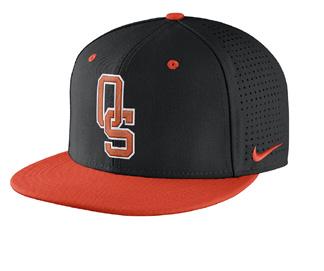
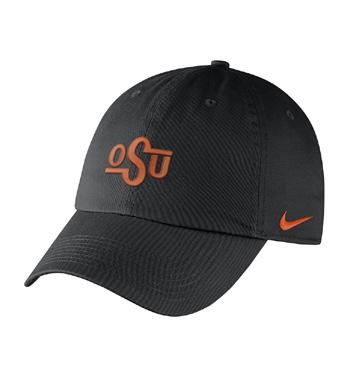
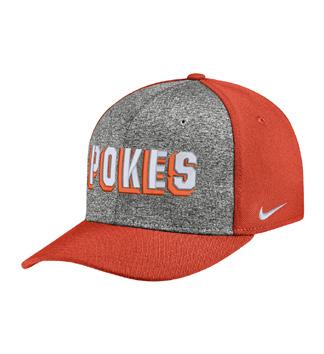
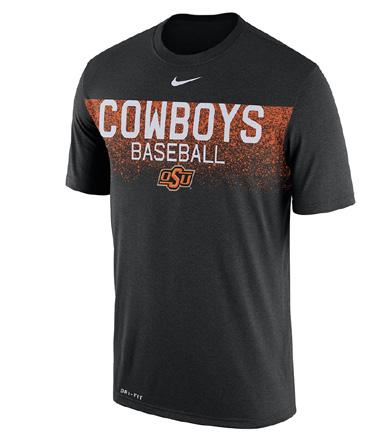

I Nike Therma Hoodie S-3XL | $75 J Nike Scoop Short Sleeve Modern Sport Tee XS-2XL | $26

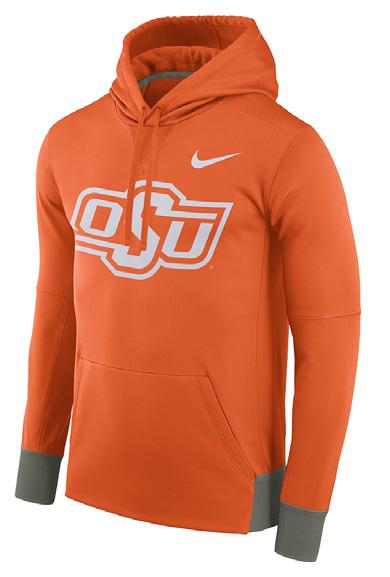
K Nike Dri-Blend Long Sleeve Franchise Tee S-3XL | $40 L Nike Dry H86 Authentic Cap $24
M Nike 3/4 Tri-Blend Logo Raglan Baseball S-3XL | $40 N Nike Arobill True Fitted Baseball 6 7/8 - 8 |$35
O Nike Replica Baseball Jersey S-3XL | $80 P Nike Packable Woven Jacket S-XXL | $85
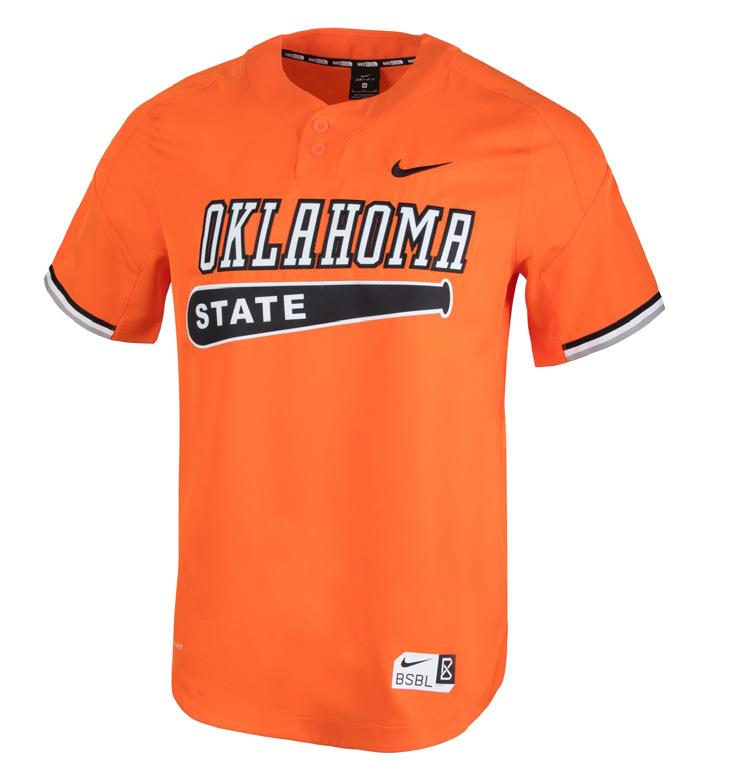

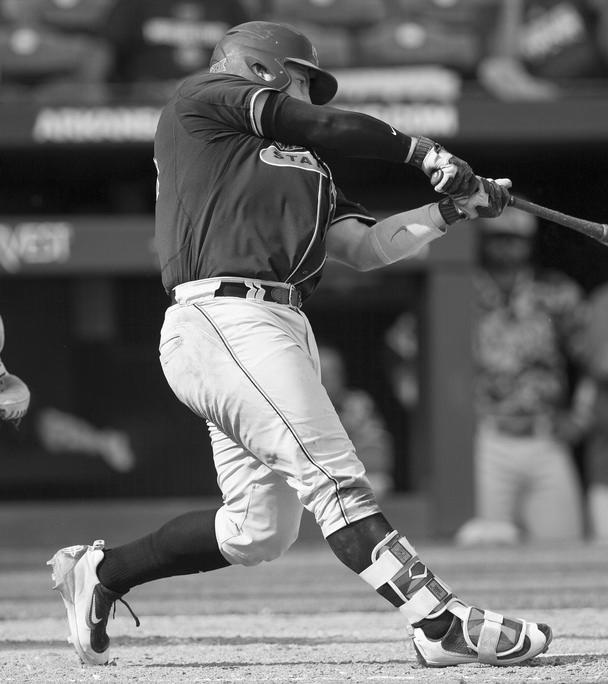


BEYOND THE GOLF
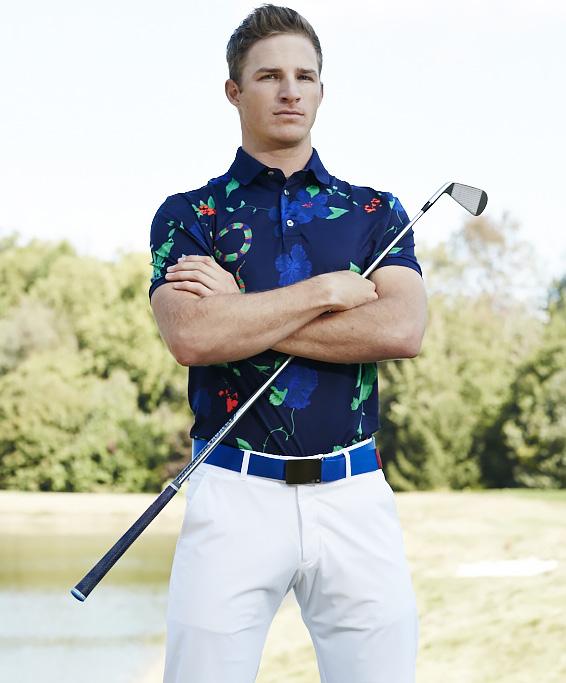 STORY BY RYAN CAMERON
STORY BY RYAN CAMERON
SPRING 2018 14
TO CALL MORGAN HOFFMANN A PROFESSIONAL GOLFER WOULD BE A MISNOMER.
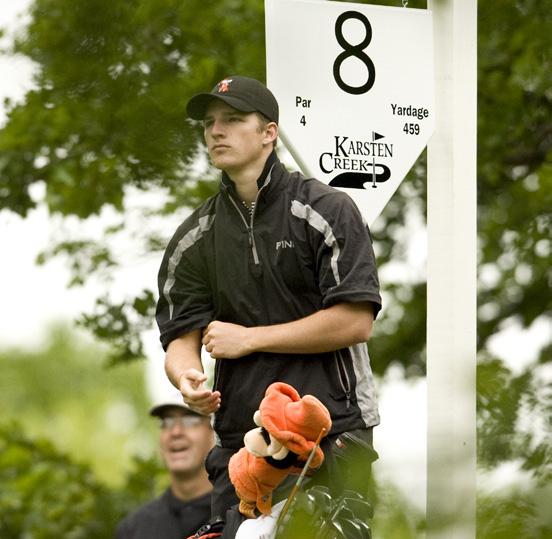
While he does play golf for a living, the former Cowboy All-American is so much more.
A man of many interests and a self-described adrenaline junkie, the sport is just one part of the equation for the man who is equal parts adventurous and charitable.
If anybody can attest to the type of character Hoffmann possesses, it is his former coach and caddy, OSU assistant golf coach Donnie Darr
He walked with Hoffmann during his first tournament as a Cowboy, and the relationship blossomed from there. After Darr left to become the head coach at Ohio State, the two remained in contact with Hoffmann even taking up residence with the Darr family for the PGA Tour’s annual stop at The Memorial.
Eventually, they teamed up during the summer of 2015 with Darr on the bag for Hoffmann, including the summer’s three major championships, before he made his return to Stillwater to assume his current position.

“He is a way better person than he is a golfer and anybody that knows Morgan Hoffmann knows that,” Darr said. “We have always been proud of how he handles himself, how he represents himself and everything he stands for.”
Whether it be his countless charitable acts, his role in launching a rapidly growing clothing line, obtaining his pilot’s license, chasing hockey pucks on the ice or free diving near his home in Jupiter, Fla., Hoffmann has already accomplished and experienced more than most will in a lifetime and has done so before the age of 30.
THE HUMANITARIAN
With the numerous demands that accompany life as a student-athlete, a premium is placed on spare time. While at OSU, Hoffmann’s time away from school and sport served as a precursor of things to come once he began life as a touring pro.

During his sophomore year, Hoffmann teamed with fellow Cowboy Sean Einhaus, whose mother is Nepalese, to form the Nepal Golf Fund in an effort to raise money for povertystricken children in her homeland.
The duo took pledges for holes played. After completing 108 holes in one day, they raised enough money to send computers to a school the Einhaus family had built.
PHOTO / GARY LAWSON
PHOTO / PHIL SHOCKLEY
15
PHOTO / GARY LAWSON
Hoffmann’s passion for helping children comes naturally as he remains young at heart.
“If you watch him around other adults or around children, he is a giant kid at heart and very much a family guy and very much a close, personal friend type of guy,” Darr said.
Not surprisingly, Hoffmann’s list of charitable endeavors currently includes The First Tee, various YMCA functions in his native New Jersey and a return to Stillwater a year ago to help raise money for OSU’s Coaches vs. Cancer program.

“I really love The First Tee program and how they teach kids to grow up, respect others and how to carry themselves and look you in the eye with a firm handshake. Their moral guidance is awesome,” Hoffmann said.
Additionally, Hoffmann’s work has benefitted those who serve in the armed forces, with philanthropic efforts for wounded warriors and military families through organizations such as Birdies for the Brave and Folds of Honor.
“We can't do our job, which is playing golf every day in perfect weather, if it were not for the military and what they do for us. They serve for our freedom. Everybody in this country should give back and give as much thanks to them as we possibly can,” Hoffmann said.
Private by nature, Hoffmann decided to go public with a Dec. 4 article posted on the ThePlayersTribune.com . In a piece Hoffmann penned titled “So Damn Lucky,” he dropped a bombshell with the revelation he had been diagnosed with muscular dystrophy in November of 2016.
Hoffmann considers the written word a good outlet to express his thoughts. After exploring multiple options to tell his story, he eventually settled on The Players Tribune. The makeup of the outlet offered the perfect avenue for Hoffmann to tailor his message to his liking.
“I wanted to release it with something that has been established. The Players Tribune hit home for me more because it is professional athletes who have told their story no matter what it was,” Hoffmann said. “This wasn’t just about golf and that is what I am about. I always trained to be an athlete and not just a golfer. I thought it would reach a larger scale if I did that.”
The month of May, which happens to fall in the heart of the PGA Tour calendar, was originally slated as a target date for his announcement, but Hoffmann held off until the narrative was crafted exactly the way he desired.
“I just couldn’t get the article where I wanted it to be. The time just wasn’t right. Originally, I thought I wanted to do it between events. I didn’t want to get distracted by what might come from releasing it and I am pretty happy that I released it when I did in December after everything was over,” Hoffmann said.
Once his condition was made public, Hoffmann was flooded by an overwhelming amount of support from those in the golf community and beyond.
“The support has been incredible, and it took a lot of time to respond to people. I have gotten responses from actors, performers and all kinds of people from different walks of life,” Hoffmann said.
Among the public displays of support was a tweet from one of OSU’s most famous alumnus, T. Boone Pickens
“Some great men and women pass through #okstate to inspire others. Touched by @ Morgan_Hoffmann for his strength, courage and grit. A good and must-read.”
Not surprisingly, Hoffmann’s former Cowboys teammates, including fellow PGA Tour members Kevin Tway and Peter Uihlein , have been there every step of the way and were among the select few to learn of Hoffmann’s condition prior to his public unveiling.
“Kevin and Peter have always been there for me, and I am there for them. It is a brotherhood with the Oklahoma State crew, and it has been really amazing that we can all keep that. Peter and Kevin and all those guys have told me they would be there for me from day one. It is really special to have that relationship.”

SPRING 2018 16
Roger Demaree of KICKER shares a laugh with Pistol Pete and Morgan Hoffmann at the annual Coaches vs. Cancer golf event.
Like Hoffmann, Tway and Uihlein have taken up residence in Florida since leaving Stillwater and have remained part of their former teammate’s support system on and off the course.
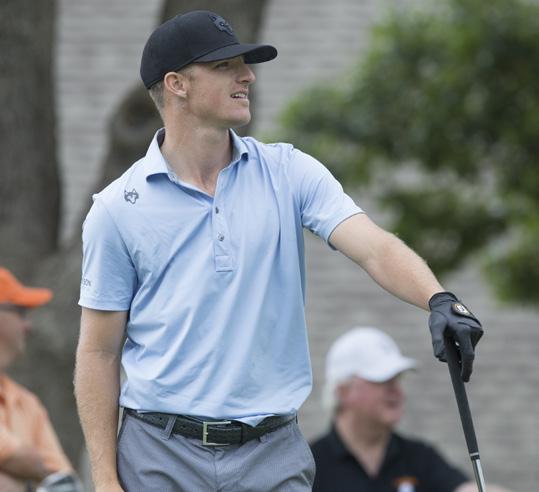
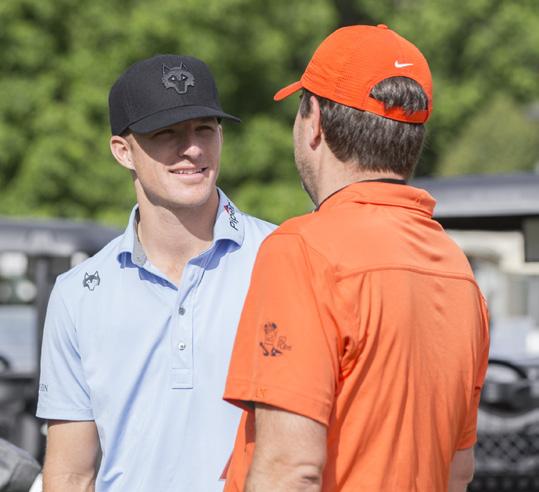
“We played with him the day that the article came out. Hoff had told us a while ago, so I remember at the time looking it up and not really thinking too much about it until the article came out. Then it really hit home for both of us,” Uihlein said.
“He was in good spirits (on the day of the announcement), and I think it was a nice weight off his shoulders. It seemed like he was relieved and relaxed. All of the support he has been getting from all over has been incredible and has been good for him.”
Dealing with a disease that provides a lot of unknowns has proven frustrating at times for Hoffmann. What he does know about his specific type—facioscapulohumeral muscular dystrophy—is it causes atrophy to the chest, back, neck arms and, in some cases, the legs.
“I have done a lot of research, and people don’t know that much about it in the form of where it is going to go and how fast or how slow. That is the most frustrating part,” Hoffmann said.
In an attempt to slow and potentially halt his symptoms, Hoffmann has implemented an all-organic diet, meditation, infrared sauna treatments to remove the toxins from his body and hyperbaric chamber sessions before bed to his daily routine. However, nothing may be more effective than his attitude.
“It is always hard to get this kind of news for anyone, but I have always been told it is the way you handle it. It is the way you get up from your fall. It is kind of something that I have taken to heart,” Hoffmann said.
Hoffmann first discovered deterioration in his right pectoral muscle shortly after leaving OSU for the professional ranks in 2011. Seeking the opinion of specialists numbering more than 25 across the U.S. and Canada, it was not until the end of 2016 he was given a proper diagnosis via a blood test.
“It was tough. I had a lot going on last year, and I think this year my mind is more free. I have so much support that it’s overwhelming. I am in a much better place this year, so I am pretty excited about the year going forward. It is going to be good to have that weight off my shoulders,” Hoffmann said.
With his right pectoral muscle having vanished, his left is not far behind, and the incurable disease has recently crept into his lower extremities. Nonetheless, Hoffmann has adapted and thrived earning more than $1.3 million and a runner-up finish at The Honda Classic on Tour a year ago.
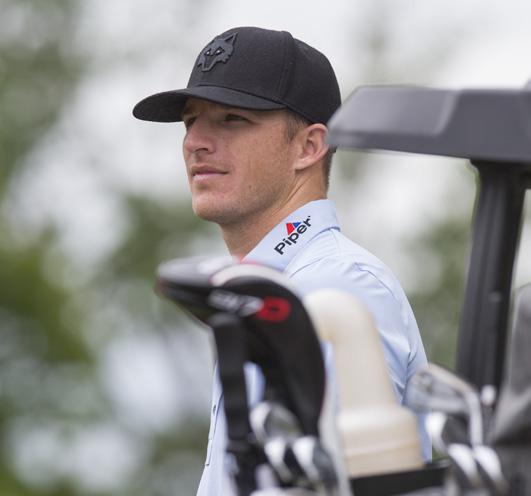
“That is really impressive, but what is more impressive is it had been hanging over him for more than a year and people probably don’t realize that,” Darr said. “For him to be able to put the worries behind him and still play great golf is really impressive and speaks to his mental toughness and his perseverance and the type of person he is.”
With that weight lifted, Hoffmann has now embarked on another charitable endeavor, proving it is not what happens to you in life, it truly is how you respond.
“I realize that with the platform I have I can reach a lot of people and hopefully change their lives in a good way. It is not just about me and my pity. If I had that mindset that would be pretty pathetic so I am excited to really make a difference,” Hoffmann said.
In August, he will host a golf outing at Arcola Country Club in his native New Jersey, and the overflowing support Hoffmann has received is evident. The 44-team event sold out within weeks of his announcement and has already raised more than $400,000. The goal now is to push that total into seven figures, in hopes of creating a center for health and wellness.
A website for those wanting to support the cause is in the works.
“My main goal is to have it open to people who want to become healthy and learn more about their body. We are going to have physicians, physical therapists, trainers, nutritionists and meditation guidance. It is going to be a one-stop shop to becoming your best self,” Hoffmann said.
“For him to be able to put the worries behind him and still play great golf is really impressive and speaks to his mental toughness and his perseverance and the type of person he is.”
17
— DONNIE DARR
THE AVIATOR
Born into a family whose livelihood has been rooted in aviation, it is easy to see why Hoffmann is as comfortable in the air as he is on the tee box.
“My mom is a flight attendant, my dad had his pilot’s license, my uncle flew C-130s in the Navy, my other uncle flew C-5s and my cousin designed landing gears for Boeing,” Hoffmann said.
Hoffmann is not the first PGA Tour standout to share a love of golf and flying. A man by the name of Arnold Palmer also had a passion for birdies and metal-winged birds. While in college, Hoffmann had the opportunity to meet Palmer and absorb knowledge from one of the game’s giants.
“I met Mr. Palmer at the 2009 Palmer Cup, and he really inspired me. I wanted to be like him,” Hoffmann said. “He told me about the different planes he had and how he worked up from a Cessna 152 to a G5. Anybody can do it, just stay on the books and keep studying, just like golf. You have to stay on it. It can be the most beneficial and fun thing you could ever do.”
And stay on it he has, graduating from a Piper Lance to a Piper Mirage with the end goal being to work his way into the cockpit of a jet. Following his diagnosis, Hoffmann’s persistence was tested with the Federal Aviation Administration requiring a recertification to prove he was fit to continue flying. He was approved in late January.
Hoffmann first obtained his pilot’s license in October of 2014 with a large part of his work being done during his time as a student at OSU.
“I have been flying since college, so I took ground school at Oklahoma State and then took lessons during my off time,” Hoffmann said.
Hoffmann’s love of flying has proven beneficial on multiple fronts, serving not only to fulfill one of his passions, but provides a costeffective way to navigate a busy Tour schedule.
“It is definitely a release, but I am not just in it for the adrenaline or the freedom to get away. It is very cost efficient and smart. It is way cheaper than flying commercially, I don’t have to check bags or go through security. I just roll right up, throw a bunch of stuff in and go,” Hoffmann explained.
“Getting my time in the air and being alone up there or having some great friends in the air with me is the coolest experience,” Hoffmann, who counts PGA Tour players Derek Fathauer and Daniel Berger among those who have hitched rides.
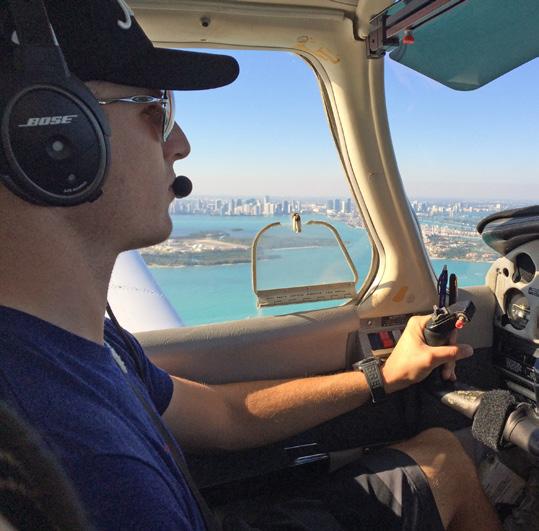
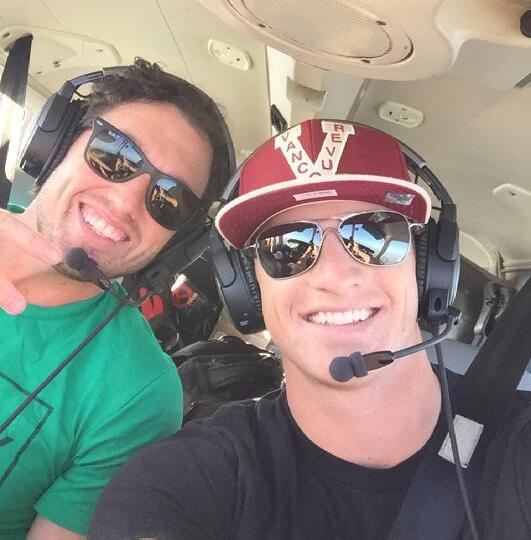
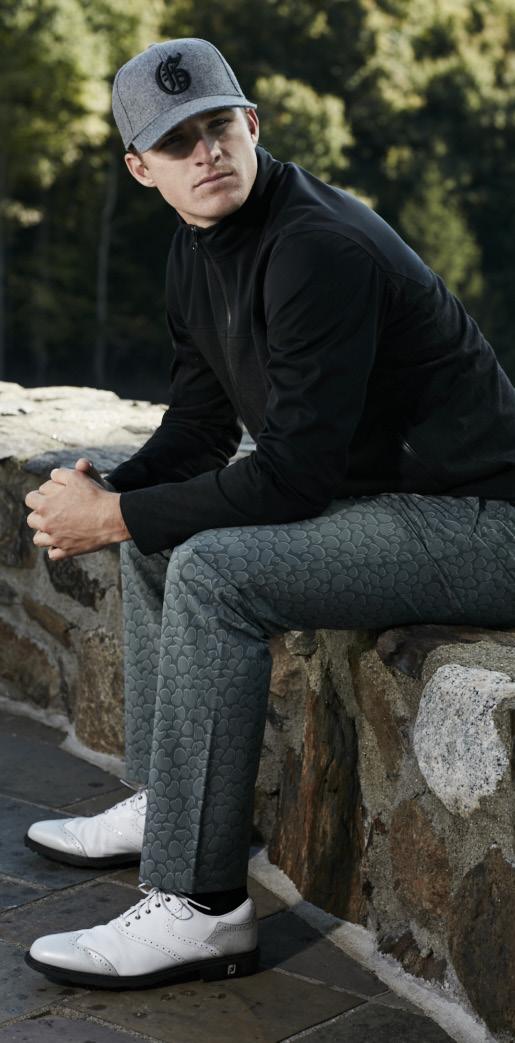

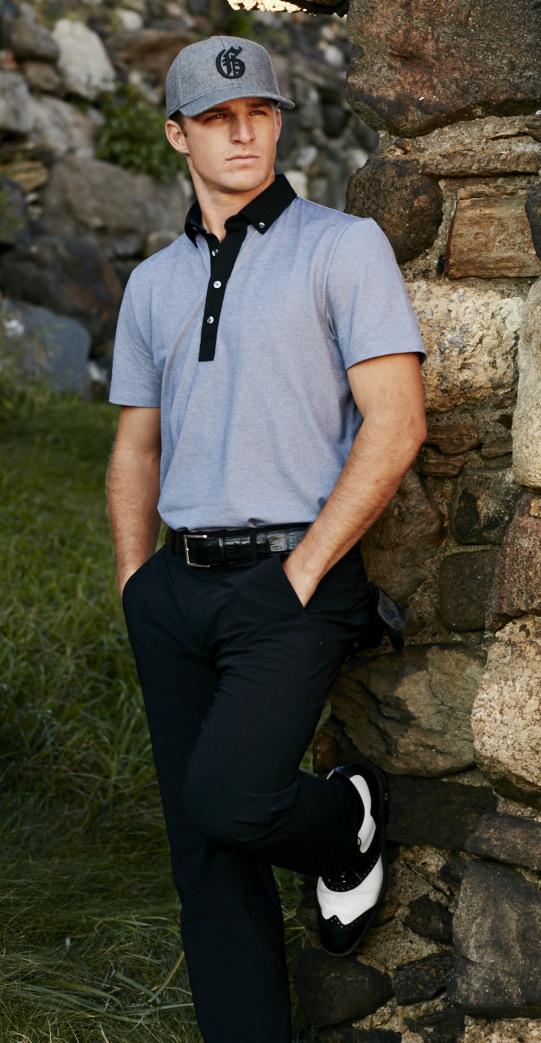
Hoffmann has been able to draw numerous parallels between his time on the links and his time in the air. Something that has proven beneficial in polishing his game.
“With flying, you can have a little fun, but know your limitations. Know what you can do and how you can perform and how your plane can perform. I am thankful I got a great education. I am about safety, and it has played over into my golf now. I am a lot more prepared and having a plan for my schedule and my season and workouts,” Hoffmann said.
SPRING 2018 18
THE CLOTHIER
Tracing back to his days as a junior golfer, it would be difficult to find a better-dressed player on the golf course than Morgan Hoffmann and his classic and clean looks.

Around age 15, Hoffmann began to wear Ralph Lauren apparel on the links. In the process, he struck up a friendship with a prominent player in the industry by the name of Charlie Schaefer, who worked as the senior vice president of design for Ralph Lauren.
The duo quickly developed a friendship and shared the same vision of starting a small business venture of their own.
After 13 years with Ralph Lauren, Schaefer approached Hoffmann about making their dream a reality. The decision was an easy one.
“I was like, ‘Absolutely we have to go for it.’ We were cautious, but very determined, and I remember it like it was yesterday. We were sitting there sketching ideas for a logo and trying to figure out a name. His daughter’s name was perfect for it, and he named it after his first daughter,” Hoffmann said.
With that, Greyson was born.
In 2015, Hoffmann debuted the brand on the pristine fairways of Augusta National at The Masters for all to see. Being the catalyst for the company’s popularity is considered a point of pride for the trendsetting Tour star.
“I always love doing my own thing, from the way I dress to the people I know or what hobbies I have. I like to be different, and Greyson is awesome and different. It takes the right character to be part of the brand. It really is special for me to be the first guy sponsored on Tour,” Hoffmann said.

While Hoffmann is invested with one of the larger stakes in the company, his role remains largely in providing feedback on design and product performance.
“I have equity in it, but it is not like I am making the business decisions. I am about the fit, the material feel.”
By Hoffmann’s account, Schaefer remains the mastermind behind the inner workings of the company.
“He is obviously the one doing the sketches for the shirts and everything. He would pick designs, and I would add my input. When the shirts come out and we make a couple of prototypes, I will tell him about the fit, if the collar is a little weird or whatever. He is doing all of the designing and it is incredible what he comes up with,” Hoffmann said.
When made available for purchase in March the year following its Augusta debut, the goal was to be in 100 clubs by year’s end. By September, Greyson could already be found in three times the number originally desired. Prestigious venues such as Medinah, Merion, Oakmont, Pebble Beach, Shinnecock, Winged Foot and, of course, Karsten Creek are counted among those carrying the wolfbranded apparel.
“The growth is really humbling. We always hoped and dreamed that it would be great, but we had no idea how fast it could grow. It happened in the blink of an eye,” Hoffmann said.
From the humble beginnings of two friends sitting on a couch in the back room of Schaefer’s house sketching potential logos, the company now boasts the world’s former No. 1-ranked player, Luke Donald , among its playing ambassadors.
“It is hard to believe we have grown enough where other players are with us now. We are still a small business in the grand scheme of things, but we have the right people with the right attitude growing it,” Hoffmann said.
It’s that same right attitude and style with which Hoffmann attacks pins, philanthropies, business ventures, and most of all life. Because of that, those associated with OSU should consider themselves lucky to call Hoffmann one of their own.
So Damn Lucky.
19

2 Malone & Amy Mitchell 3 William S. Smith 4 Patterson Family 5 Dennis & Cindy Reilley 6 John Clerico 7 W & W Steel, LLC 8 Michael & Anne Greenwood 9 Robert A. Funk 10 Ross & Billie McKnight 11 Karsten Manufacturing 12 A.J. & Susan Jacques 13 James & Mary Barnes 14 Anonymous #18 15 Helmerich Family 16 Bob Howard 17 Chesapeake Energy, Inc. 18 Harold & Joyce Courson 19 Joe & Connie Mitchell 20 Bank SNB 21 Ken & Jimi Davidson 22 ONEOK Inc 23 Jack & Carol Corgan 24 Mike & Robbie Holder 25 Kent & Margo Dunbar 26 Watson Family Foundation 27 David & Tracy Kyle 28 Chad Clay 29 OSU President's Office 30 Les & Cindy Dunavant 31 Greg & Rhonda Casillas 32 Richard & Barbara Bogert 33 Vickie & Tucker Link Foundation 34 Gary & Jerri Sparks 35 Waits Family 36 OSU Foundation 37 OG&E 38 The Cobb Family 39 Lew & Suzanne Meibergen 40 Anonymous #1 41 RCB Bank 42 Russ Harrison & Natalie Shirley 43 Calvin & Linda Anthony 44 Brad & Margie Schultz 45 Bryant & Carla Coffman 46 Darton & Jamie Zink 47 Joullian & Co 48 Mike Bode & Preston Carrier 49 Jana Drummond 50 Flintco, Inc. 51 Lambert Construction 52 Jerry & Rae Winchester 53 Anonymous #2 54 G. Edward Evans 55 Mark & Lisa Snell 56 David & Julie Ronck 57 American Fidelity 58 Wiese Family 59 Barry & Roxanne Pollard 60 Sparks Financial 61 E. Turner & Cynthia Davis 62 Steve & Diane Tuttle 63 Anonymous #3 64 Jay & Connie Wiese 65 KNABCO Corp 66 Pam J. Russell 67 Jameson Family, LLC 68 Jim & Vicki Click Jr. 69 OSU Center for Health Sciences 70 Chip & Cindy Beaver 71 Baab Legacy, LLC 72 Atlas Asphault Products 73 Steve & Vicki Farris 74 Ed & Kathy Raschen 75 Andy Johnson 76 Phil & Ruth Terry 77 Z-Equipment, LLC 78 Ike & Mary Beth Glass 79 Richard & Joan Welborn 80 Bank of Oklahoma 81 David LeNorman 82 Larry Albin 83 Mark & Beth Brewer 84 Philip & Shannon Smith 85 Seventy Seven Energy 86 David Bradshaw 87 BancFirst 88 MidFirst Bank 89 Steve & Jennifer Grigsby 90 JS Charter Investments, LLC 91 Harvey & Donna Yost 92 The Bank of America 93 Henry Wells AS OF MARCH 30, 2018 1 Boone Pickens – 6,111,966
TOP
DONORS (BASED ON PRIORITY POINTS) SPRING 2018 20
THE 150
150
OSU ATHLETICS POSSE POINT SYSTEM
The Priority Point System provides a fair, consistent and transparent method of providing benefits to donors in exchange for their financial investments in OSU athletics.
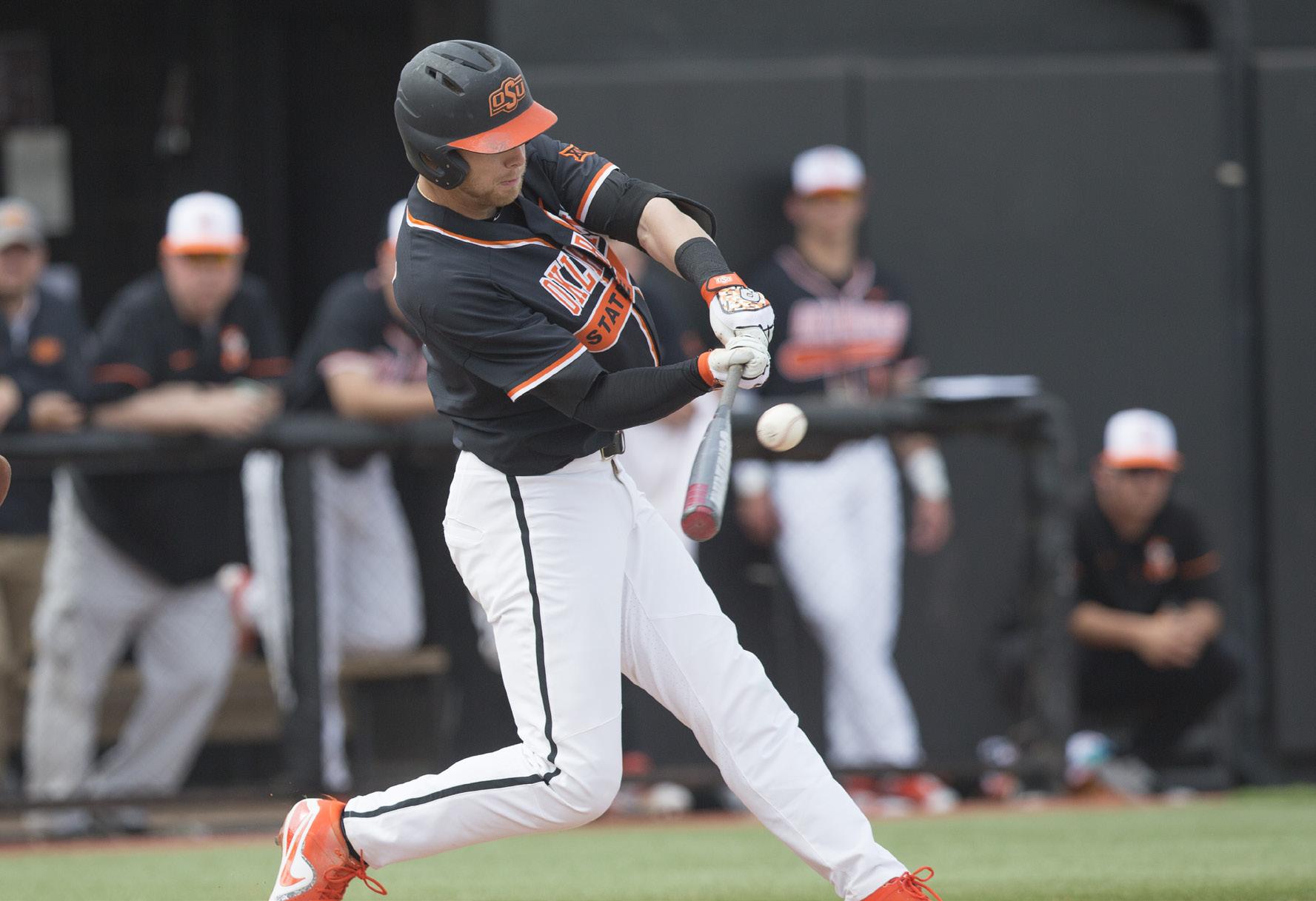
Donors gain points three ways:
Contributions
All current and lifetime contributions (cash or stock) are worth 3 points per $100 donation. Planned (deferred) gifts in the new Leave a Legacy Endowment Campaign will receive 1 point per $100.
Commitment
Donors will earn one point each year for purchasing season tickets (one point per sport annually), as well as one point for each year of POSSE donations.
Connection with the University Donors (or their spouses) who are OSU Alumni receive a one-time 10 point bonus, as do OSU faculty/staff and letterwinners.
Points never diminish and will carry over to subsequent years. Donors retain all previously earned Priority Points in their giving history. For questions about the POSSE Priority Point System, email posse@ okstate.edu or call us at 405-744-7301.
94 Steve Tatum 95 Thomas & Barbara Naugle 96 Griff & Mindi Jones 97 OSU Alumni Association 98 Doug & Nickie Burns 99 Jerry Marshall 100 Emrick's Van & Storage 101 Ron & Marilynn McAfee 102 Southwest Filter Co. 103 Anonymous #4 104 Fechner Pump & Supply 105 Sandra M. Lee 106 OSU Business Office 107 Vionette & John Dunn 108 Fred & Janice Gibson 109 Robert & Sharon Keating 110 Brad & Leah Gungoll 111 John Hull 112 K.D. & Leitner Greiner 113 Bob & Mary Haiges 114 Mike & Glynda Pollard 115 Austin & Betsy Kenyon 116 Randy & Pati Thurman 117 Jerry & Lynda Baker 118 Brent & Mary Jane Wooten 119 Prosperity Bank 120 Chris & Julie Bridges 121 Johnsons of Kingfisher 122 AEI Corporation - Oklahoma 123 Bryan Close
Points 6,111,966 240,406 62,695 39,250 30,557 24,560 17,265 11,436 4,694 2,219 711 179 56 Rank 1 5 25 50 75 100 150 250 500 1000 2500 5000 7500
POINTS RANK? as of MARCH 30, 2018 124 Malzahn Family 125 Stan & Shannon Clark 126 James H. Williams 127 Bill & Claudean Harrison 128 The Oklahoman 129 Barber-Dyson Ford Lincoln-Mercury 130 A-Cross Ranch 131 Chandler USA, Inc 132 Terry & Martha Barker 133 Scott & Kim Verplank 134 Russ & Julie Teubner 135 Drummond Investments 136 Dillingham Insurance 137 Crossland Construction 138 Larry Bump 139 Ameristar 140 Shaw's Gulf 141 Baloo & Maribeth Subramanian 142 Ron & Jan King 143 Jack Bowker Ford-Lincoln 144 Mike & Judy Johnson 145 Gary & Mary Ellen Bridwell 146 Bill & Marsha Barnes 147 John & Gail Shaw 148 Mustang Fuel 149 Bill & Karen Anderson 150 Fred & Kellie Harlan 21
HOW DO MY


Pete says,

THE WORLD NEEDS MORE COWBOYS.
Encourage the rising high school senior you know to apply beginning July 1 to be one of the first considered for admission and scholarship opportunities. ADMISSIONS.OKSTATE.EDU
 STORY BY CLAY BILLMAN
PHOTOGRAPHY BY BRUCE WATERFIELD
STORY BY CLAY BILLMAN
PHOTOGRAPHY BY BRUCE WATERFIELD
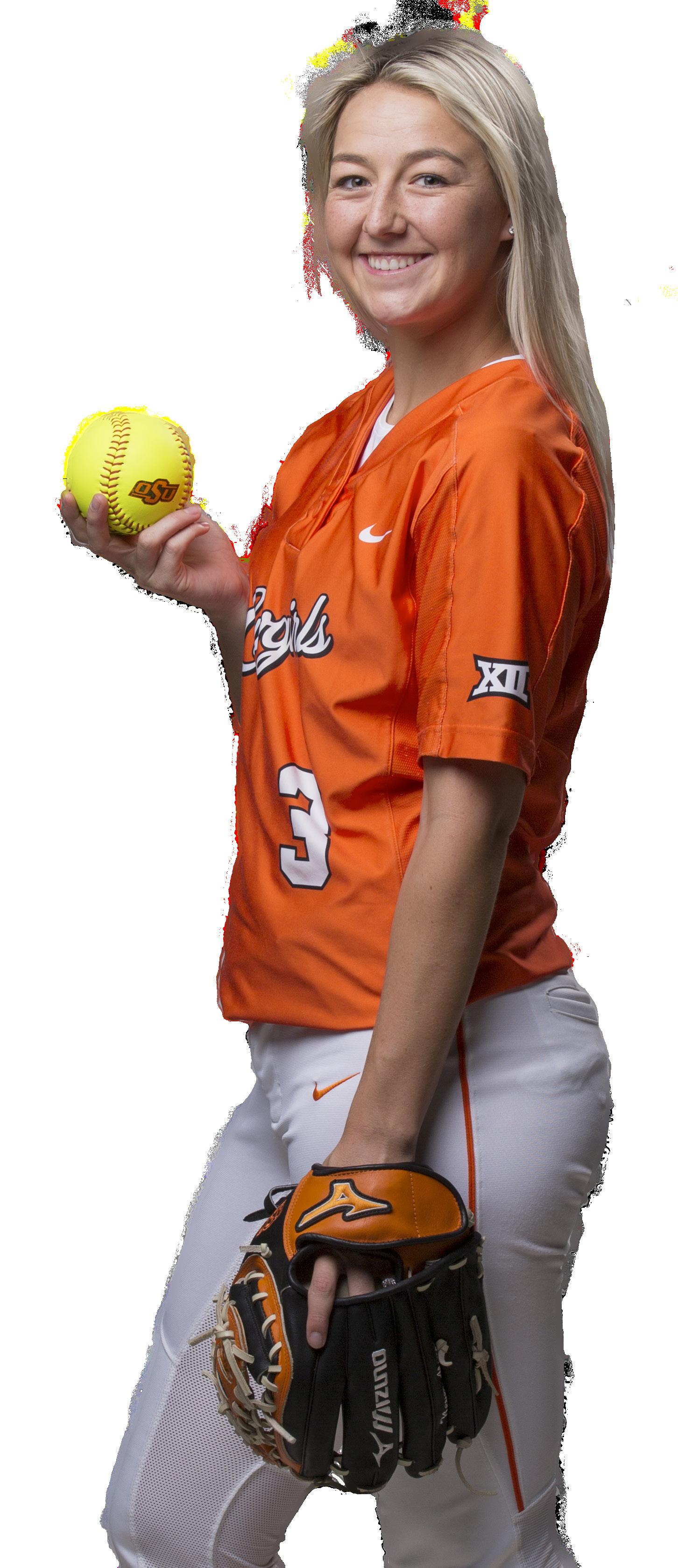
SPRING 2018 24
Two-thirds of the way through the 2016 softball season, sophomore Vanessa Shippy had something on her mind.
Should I …
The native of Coeur d’Alene, Idaho, was a rapidly rising star on the diamond. On her way to Co-Big 12 Player of the Year honors, Shippy led the league in batting average (.425), on-base percentage (.543), runs (58) and walks (43). Third-team AllAmerica accolades would follow.
But as a team, the Cowgirls were sitting just above .500 and facing a difficult conference slate down the stretch. If OSU — a longshot to make an NCAA regional — wanted a chance at postseason play, they would need to be hitting on all cylinders. They weren’t.
What if …
Rookie head coach Kenny Gajewski’s roster had taken a hit after his starting catcher quit midseason. The Cowgirls were painfully thin at the position with only a true freshman behind the plate. Shippy began to think.
Maybe …
The long-time second baseman had recently been shifted to center field to get more talent in the Oklahoma State lineup. To no one’s surprise, she made a seamless transition to the outfield.
(MOST VALUABLE PERSON)
25
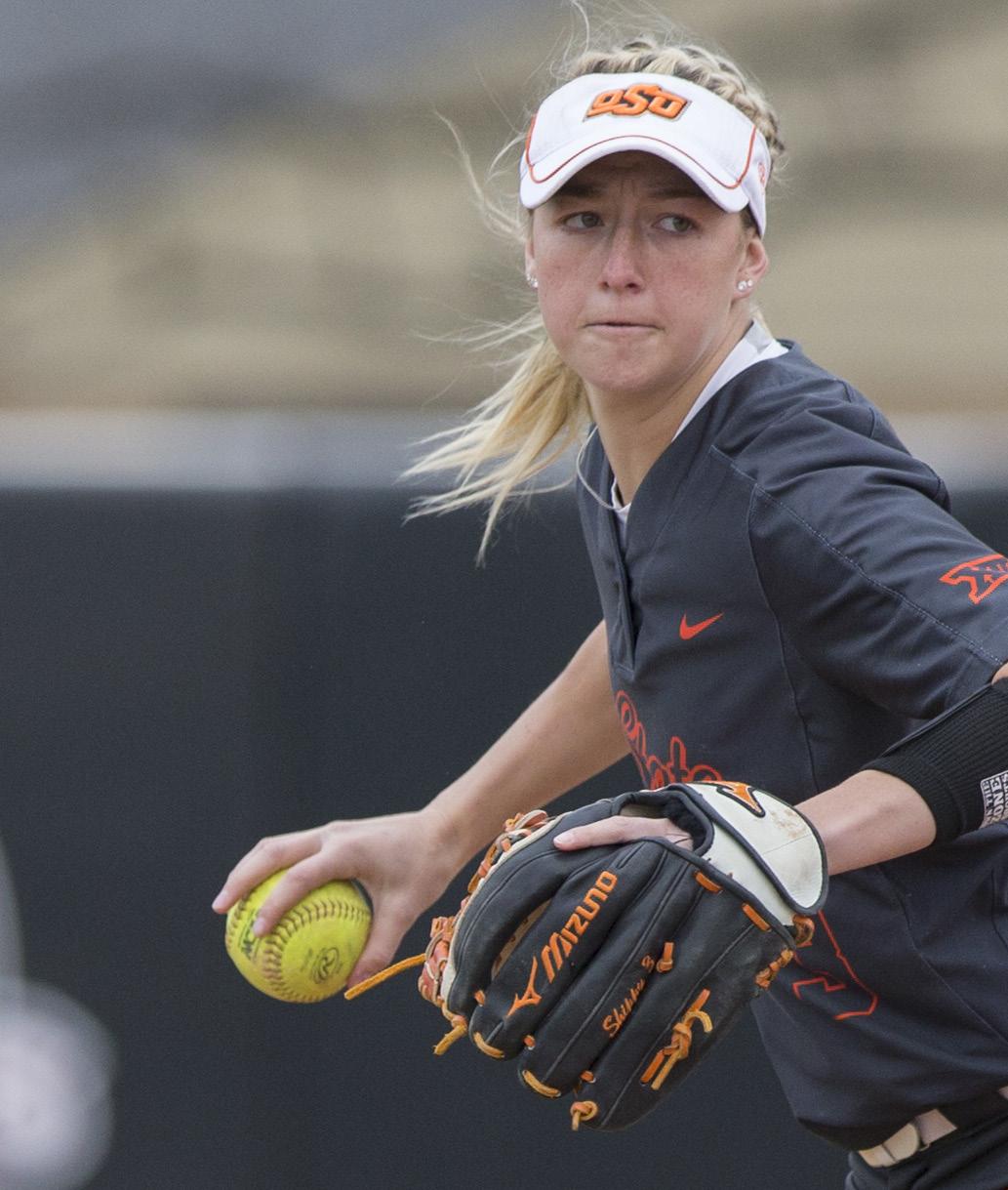

"SHE’S A COMPLETE PLAYER. ANYTHING SHE MAY LACK PHYSICALLY, SHE MAKES UP FOR WITH I.Q. AND JUST TRUE GRIT. GUTS. SHE’S FEARLESS."
SPRING 2018 26
—KENNY GAJEWSKI
On a Monday following a road trip, the normally confident kid apprehensively approached her coach with a wild idea.
“Vanessa came into my office and said, ‘Hey, can I talk to you?’ I said, ‘Yeah. I’d love to talk.’
“She goes, ‘I can catch.’ I said, ‘Come on! You’re not a catcher.’”
“He laughed at me,” Shippy recalls. “I said, ‘No, seriously. Give me some gear. We’ll go outside right now.’
“We just didn’t have that catching component that he was looking for,” Shippy adds. “I didn’t know if I was the answer, but if I could help in any way, I wanted to try. I wanted to see what I could do.”
Shippy admits it took a few days to get up the nerve to talk to her coach.
“I didn’t know if I should do it or not. A) I don’t know if I’m good enough, and B) I don’t know if he’s going to say, ‘Great, you can go catch bullpens.’
“I finally said, you know what, at this point obviously God was moving me to go do that, and if I end up being the bullpen catcher, I guess that’s what He wanted.”
“Shippy told me she had caught some in high school and travel ball,” Gajewski says. “She said, ‘I can catch. And I think I can help this team win.’ And I said, all right.
“We walked her outside, got her gear and she caught about five balls from me.”
That’s all it took.
“She can catch.”
Gajewski didn’t tell the rest of the team (or even his starting pitcher), but Shippy would start the next game, a midweek matchup with Central Arkansas.
“I saw a lot of weird looks when I posted the lineup,” Gajewski recalls.
Shippy was surprised, as well.
“Until my name was actually on the roster I didn’t believe it was going to happen.”
The Cowgirls rolled to a 17-0 victory, with Shippy catching all five shutout innings.
“I’ll be very honest,” Gajewski says, “after about the second batter of the game, I forgot
she was back there. Shippy played unbelievable. She was able to lead, which is something she really wants to do, and I just saw a different kid. Confident. A little chip on her shoulder. I just thought, ‘Whoa! This could change us. I hope this can last.’ And it just got better every single day.”
Two days later, Shippy and Co. would face a nationally-ranked Baylor team in Stillwater.
“We were big underdogs that year so I was already nervous,” Shippy says. “I hadn’t caught in four years, and now I was catching Baylor. But it was awesome. We won that game.”
Shippy had solidified the position.
.502
ON-BASE PERCENTAGE
.381 BATTING AVERAGE
.562 SLUGGING PERCENTAGE
“I don’t know if I’m necessarily the best skilled catcher for the job by any means. I’m small and my arm isn’t like a crazy cannon, but I’ve loved the position back there — just because it’s a leadership role, and I really got to show how much I knew the game. It was fun for me, working with our pitchers and creating that relationship with them. I loved that I got to step into that role, and I’m really glad it all worked out and we had a good season from there.”
Gajewski’s first season at the helm culminated in a 29-24 regular-season record, enough to earn the Cowgirls a trip to the NCAA regional at Georgia.
It was in Athens where Shippy showed the toughness and competitive fire that made her a starter since day one in Stillwater. (Her consecutive-game streak stood at 173 at the start of the 2018 season, with a chance to surpass Chelsea Garcia’s all-time mark of 231.)
“She’s not coming out,” Gajewski says. “She’s going to have to be told that she can’t play. Nobody knows this, but in Georgia she was one pitch from being pulled in our regional there. She was beat up. Could barely move. Could barely run. And nobody would have known it. You couldn’t have pried her off the field.
27
“I just looked at her the first day and asked, ‘Can you go?’ She said yes. I said, ‘I’m not going to ask you again. I trust you …’ And I never heard another word. Ship played the whole regional hurt. She was the best player in the regional, period.”
“Honestly, I think I haven’t missed a game because I just haven’t let myself,” Shippy explains. “There have been games where I haven’t felt great. My body’s hurt or whatever. But this is what I came here to do, and this is what I love to do, and unless I physically can’t get on the field because my legs are broken, I don’t think there’s anything that’s going to keep me from doing it.
“It was actually my hip flexor, which is just a weird kind of pain. It’s kind of the main thing that makes your legs go, so it was different. It was the only time I’ve ever had to miss practice. I was there but not fully participating. I’ve never missed a workout. I’ve never missed a practice. I’ve never missed a meeting. I’ve never missed anything. That was weird for me, especially before such a big game. It was our first regional since I’d been here. I knew I was gonna play.”
Shippy credits assistant athletic trainer Claire Williams for helping keep her healthy and in the lineup, not just for one game, but a rigorous 60-game season.
“Claire worked with me and did everything she could to get me back on the field. She really keeps me in check.”
As a senior, Shippy looks back on her first year in a Cowgirl uniform. The advice from the upperclassmen proved true.
“Our freshman year we would talk to the seniors, and they we would be like, ‘Oh, my legs man!’ and we were like, ‘Come on … what are you talking about?’ Now we’re seniors, and we’re like, ‘Our legs, man!’ I think it’s definitely wearing on me.”
After that sophomore season, Gajewski vowed to get Shippy back to the infield … eventually.
“I told Ship I’d do everything I could to get us a catcher in here so we could get her back on the dirt,” he says. “It’s not that easy and when she’s so good, it’s hard to take her out of there. I didn’t have any kind of long-term plan, but her comment to me was, ‘Coach, as long as we’re going to win, I don’t care. If that’s what it takes for us to win, I’ll catch.’”
Utility. It’s a term that doesn’t always garner the respect it deserves.
Second base. Center field. Catcher. Shippy was the epitome of utility in 2016. And the softball world took notice. She was named a third-team All-American as a utility player.
“I joke about that a lot,” Shippy says. “I’m that player they don’t know where to put … But to me, utility can be someone who works hard and can play every position. We have so many utility players here, and I mean that in an amazingly positive way. Taylor Lynch can play just about anywhere. But where do you put eight infielders? We’ve only got four spots so you’ve got to be able to play other positions or we don’t have those bats in the lineup. Sydney Pennington is the same way. Madi Sue (Montgomery) is the same way. There are so many girls on our team who are selfless enough to play those other positions. So to me utility is something pretty special.”
In 2017, after a full season at catcher, Shippy was again tabbed as a third-team AllAmerican by numerous outlets. Heading into this spring, she was on preseason first-team All-America lists.
This season, Gajewski has more depth behind the dish and has Shippy back on the infield, although this time at third base.
“I’m gonna go wherever Coach G. wants,” she says. “If that’s where I’m going to help the team, that’s where I’m going to be.”
Gajewski thinks third might be her natural position.
“I really think she’s going to shine at third,” he says. “She can cover every bunt. She’s so reactive when she plays that she’s able to just eat up ground balls at third, she can make the throw from all angles and do everything you need to do. She’s just so talented.”
“She’s one of the quickest people I’ve ever seen on bunts,” says OSU senior first baseman Jessi Haffner. “You should watch her in practice. It’s something like you’ve never seen before.”

Haffner and Shippy were part of the same freshman class at OSU. They’ve been roommates since their sophomore year.
“I remember our freshman year, almost every single night she would go up to the indoor and hit,” Haffner recalls. “That just showed me she’s here to play. She’s here to stand out. I knew she was going to be something really special when she got here.”
Haffner is glad to see Shippy back on the infield.
“I actually like having her at third base because I can see her more,” Haffner says. “She can still be a leader out there. She’s somebody I can look to on the field if we’re in a tight situation and be like, ‘We’re going to be fine.’
“I love the mentality at third and being able to talk,” Shippy explains. “I loved catching, but I feel like I get tunnel vision, zeroedin on the pitcher and getting calls from the dugout. Whereas, when I’m playing infield, I can talk to everyone on the field and really know everything that’s going on.”
Shippy says her experience as a utility player has given her a message for young softball players.
SPRING 2018 28
2018 COWGIRL SENIORS
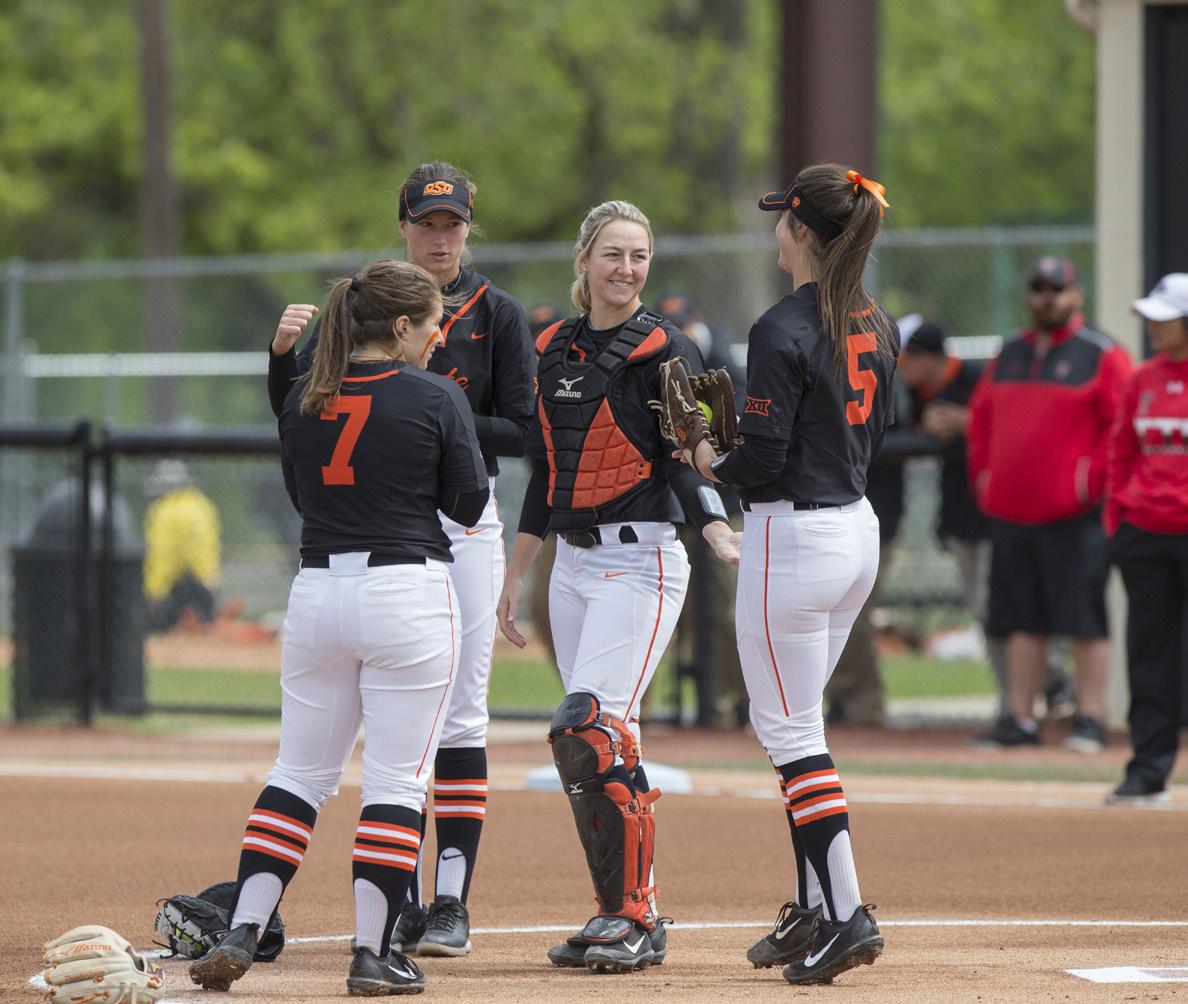
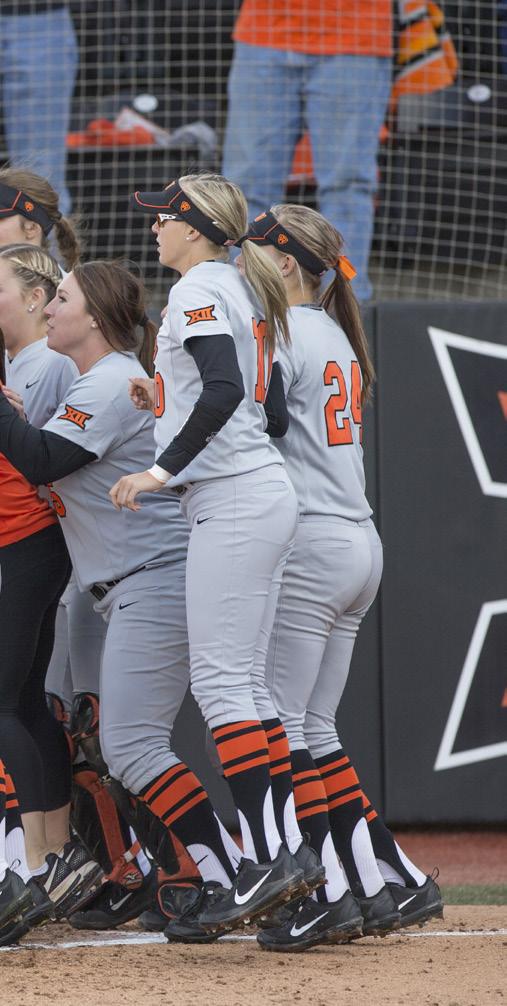


WHITEHORN
O'DONNELL
WHITNEY
RANDEE
VANESSA SHIPPY
JESSI HAFFNER
MADDI HOLCOMB
29
“I’m truly blessed that I’ve gotten to play all these positions because they’re very different. With the influence we can have on young kids, I’ve tried to embrace that role and say ‘Hey, go practice other positions. I came in here and just thought I was going to be a second baseman forever so you better learn all those positions now while you’re eight-years old.’”
Shippy has also set an example in the classroom, earning CoSIDA Academic All-America honors the last two seasons.
“My dad was a huge part in my success academically,” Shippy says. “And that was when I was in elementary school, before they even gave A’s or B’s … but he always pushed me and said school is really important. As a female student-athlete, this isn’t something that’s going to make us millions of dollars. I came to college to get a degree, and softball is something that paid for it and opened those doors for me. Obviously it’s become a huge part of my life, but the ultimate goal is getting a degree and I’m going to make sure I get all I can out of it.”
Haffner says Shippy is one of the most competitive people she’s ever met.
“Ping pong gets really intense between us. It’s a very serious sport. You could put her in any type of situation, and she’s going to be competitive,” Haffner said.
“If you walk around here lately, she’s actually studying for her big financial adviser test. It has nothing to do with Oklahoma State but to become licensed. I’m like, ‘Dude … What are you doing?’”
Shippy will graduate in May with double degrees in finance and marketing.
“Life after softball is obviously a reality, and I want to be a financial adviser the day I graduate. And I’m on track to do that.
“I think that’s what’s funny about me. I’m a planner. I wanted to go to college when I was in sixth grade. That was my plan. I wanted to go to college and play college softball and be an amazing college softball player.
Shippy committed to play the Cowgirls as a high school sophomore.
“When I got to high school I was already set on college, and I was like, ‘What am I going to do after that?’ I’ve just always been just one step in advance. My mom always says to enjoy what I’m doing, and I do. I have absolutely enjoyed every day of my life. I don’t think I’m missing out on anything by preparing for what’s coming.
“I’m excited for the future. I’m excited to start a family and go from there. It’s sad and it’s weird to think that softball is coming to an end, but I’m very excited for what’s coming after it.”
With a career on deck and a fiancé to boot — she and Matt Fletcher will tie the knot in August — Shippy is still going to enjoy her final season in a Cowgirl uniform.
“I think this team’s capable of a whole heck of a lot, and I’m excited to see what happens,” she says. “I definitely feel like our team chemistry is better than any team I’ve ever been on. Everyone has the same goal. They want to go to regionals. They want to go to super regionals. And we know once we get to super regionals, it’s anyone’s game. We could get to the World Series.
“It’s my last year, man, I want to get to Oklahoma City!”
Shippy is mentioned among the best to ever play at Oklahoma State, and a healthy 2018 season will see her name atop many all-time lists in the Cowgirl record book.
At the start of the season, she ranked in the OSU top-five in several categories: runs scored (136, 4th), doubles (42, 5th), walks (120, 2nd), stolen bases (48, 4th) and hits (193, 9th). Shippy also holds the program’s highest career on-base percentage at .502, while ranking third in career batting average (.381) and fourth in slugging percentage (.562).
“I don’t think my legacy’s going to be numbers,” she says. “And I hope it’s not that. Honestly, I just want people to remember how much I enjoyed the game and how hard I played it, how much I love OSU, how much I love the community … and maybe it’s academics. ‘Hey, she actually tried to be a good student, too.’
“As a student-athlete, it’s the coolest thing to have a platform to share my story, to share my faith and be an influence on people,” adds Shippy. “I just really want every student-athlete here to take advantage of that. Get out in the community. Give a lesson or two. Go show up at a young kid’s practice. Go out after games and sign autographs and give hugs and take pictures with these kids that completely look up to us. I’ll never be in a position again where I have as much influence on people as I have now.”
Gajewski hints that Shippy could end up immortalized in the outfield at Cowgirl Stadium, alongside OSU greats Michele Smith, Melanie Roche, Lauren Bay and coach Sandy Fischer.
“We may be talking about putting her number up on the wall,” Gajewski says. “Shippy is that type of dynamic student-athlete. She’s the most valuable player in the country if you ask me. She’s a complete player. Anything she may lack physically, she makes up for with I.Q. and just true grit. Guts. She’s fearless. What she’s done, day-in and day-out, on-and-off the field, it’s special. It’s an honor to coach her.
“She’ll sign every autograph. She’ll do anything. She’s all-in for OSU. She bleeds orange. We’ll miss her, but we’re going to enjoy her for one more season and hopefully send her and the other seniors out on a great note.”
SPRING 2018 30
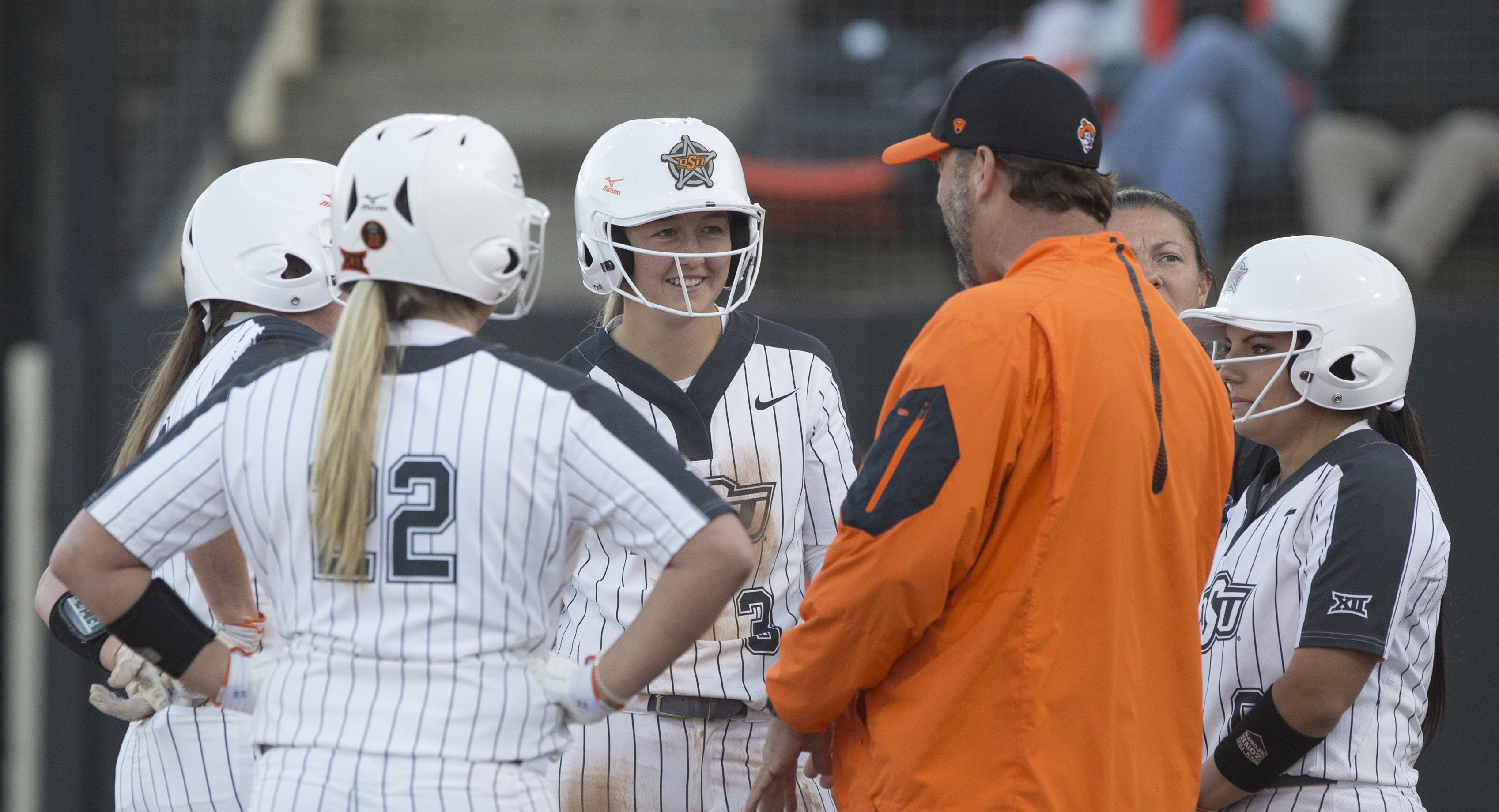
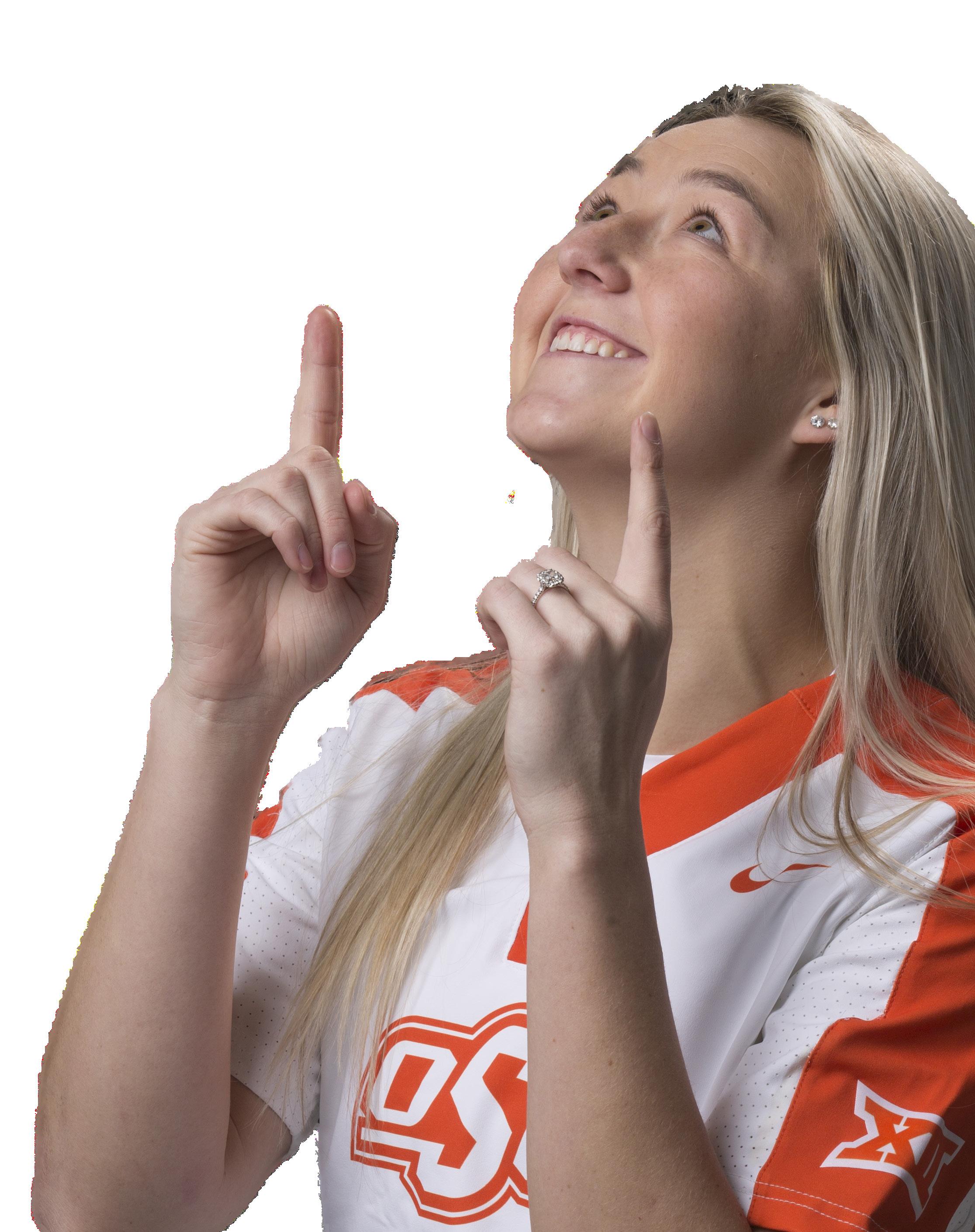
—VANESSA SHIPPY
31
"AS A STUDENT-ATHLETE, IT’S THE COOLEST THING TO HAVE A PLATFORM TO SHARE MY STORY, TO SHARE MY FAITH AND BE AN INFLUENCE ON PEOPLE."
THE AND LONG WINDING ROAD
STORY BY JOHN HELSLEY PHOTOGRAPHY BY BRUCE WATERFIELD
LORYN GOODWIN STARRED LONG BEFORE SHE GOT TO OKLAHOMA STATE, WHERE SHE STARRED AGAIN.
She was Conference USA’s newcomer of the year in 2016-2017 at UT-San Antonio, Butler’s leading scorer and an all-Big East honorable mention selection in 2015.
Oh, and the Sun Belt Conference freshman of the year before that, while playing at North Texas.
That’s right—four schools—along with five head coaches, spanning a college basketball career featuring more twists and turns than the Wild Mouse at Palisades Park. And like the screaming kids in those cars teetering on the rickety track, Goodwin never saw the abrupt curves coming around the bend.
This wasn’t Goodwin’s plotted path; far from it. Circumstances dictated each of her moves. Yet as difficult as they were, she plucked positives from each transition, including the stop in Stillwater, where Goodwin expanded her career—athletically and academically— while finding a place she can finally call home.
“One thing I love about OSU is the people and the relationships I’ve been able to make,” said Goodwin, a sixth-year graduate transfer. “And to be a part of something so great. I don’t know if people expected us to do good things on the basketball court.
“A lot of people had to put their pride aside, including myself, and say this is what’s going to be best for the team. And we’ve each done that.”
Goodwin has been pretty special herself, answering a Cowgirls’ need on the perimeter and extending OSU’s recent run of outstanding point guards in the tradition of standouts like Andrea Riley and Tiffany Bias.
And her impact was immediate, with Goodwin playing major minutes and filling the stat sheet with points, assists, rebounds and steals. She averaged 22.2 points through the nonconference schedule, going for at least 24 points in major matchups against Wichita State, Tennessee, Mississippi State and UCLA.
Once in Big 12 play, she rarely slowed, scoring 31 in a win over Oklahoma that served as a statement for her and the Cowgirls, as well as the setup to a Bedlam sweep.
SPRING 2018 32
“Goodwin is a handful,” Sooners coach Sherri Coale said after her team’s trip to Stillwater.
For Cowgirls coach Jim Littell , Goodwin is a blessing.
“She’s been a great player for us. Outstanding leader,” Littell said. “She’s just a very talented young lady who loves to play the game and is very passionate about it. She spends a lot of time in the gym. She’s one of those kids I talk about, ‘What do you do when nobody’s watching?’ Well, you’ll come in here in the evening, and she’ll be in the gym working on her game. It’s no accident she had a great year, because she invested a great deal of time in her game.”
The nation noticed, too, leading to Goodwin’s addition to the watch list for the Wade Trophy, the oldest and most prestigious Player of the Year award in women’s college basketball.
More payoff on what has been a longterm and long-traveled investment; a “journey” Goodwin calls it, although with little hint of regret.
“I wouldn’t say it’s easy, and I wouldn’t necessarily recommend it to people to transfer a million times,” Goodwin said, “but I will say that having such a good support system back home and just listening to people and not making irrational decisions was important.
“There will be struggles in college for everyone. You’re at a new place, you’re not with the same people you’re with in high school. You’re going to have to figure out how to be an adult and live on your own.”
Goodwin figured things out on the fly, again and again. Sure, her ideal path wouldn’t have involved four schools in five years. But Goodwin’s ideal never seemed within her control.
Out of Cypress Falls, Texas, Goodwin signed with North Texas, excited to play for coach Karen Aston . But before she arrived on campus, Aston left to become coach at the University of Texas.
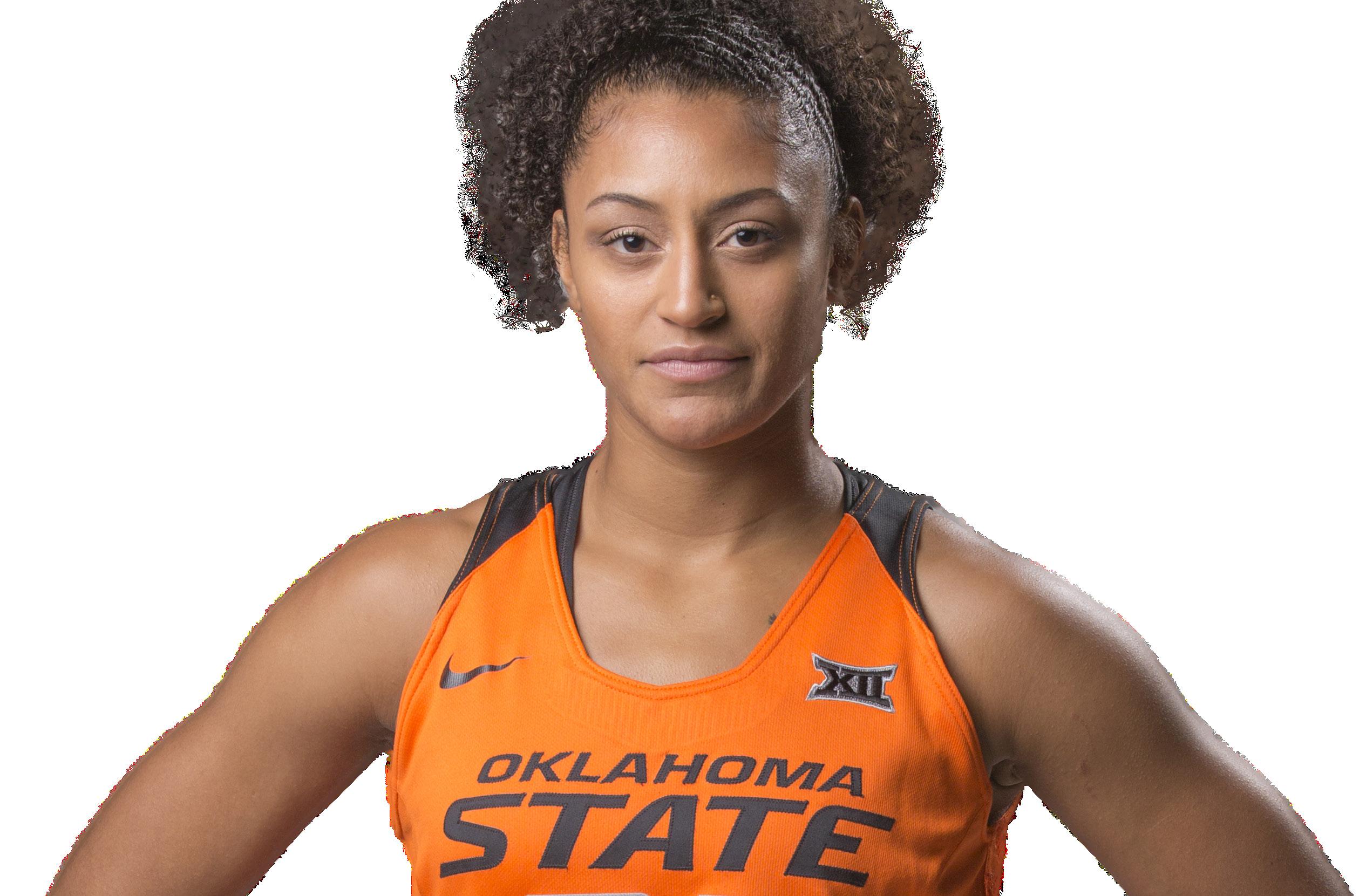
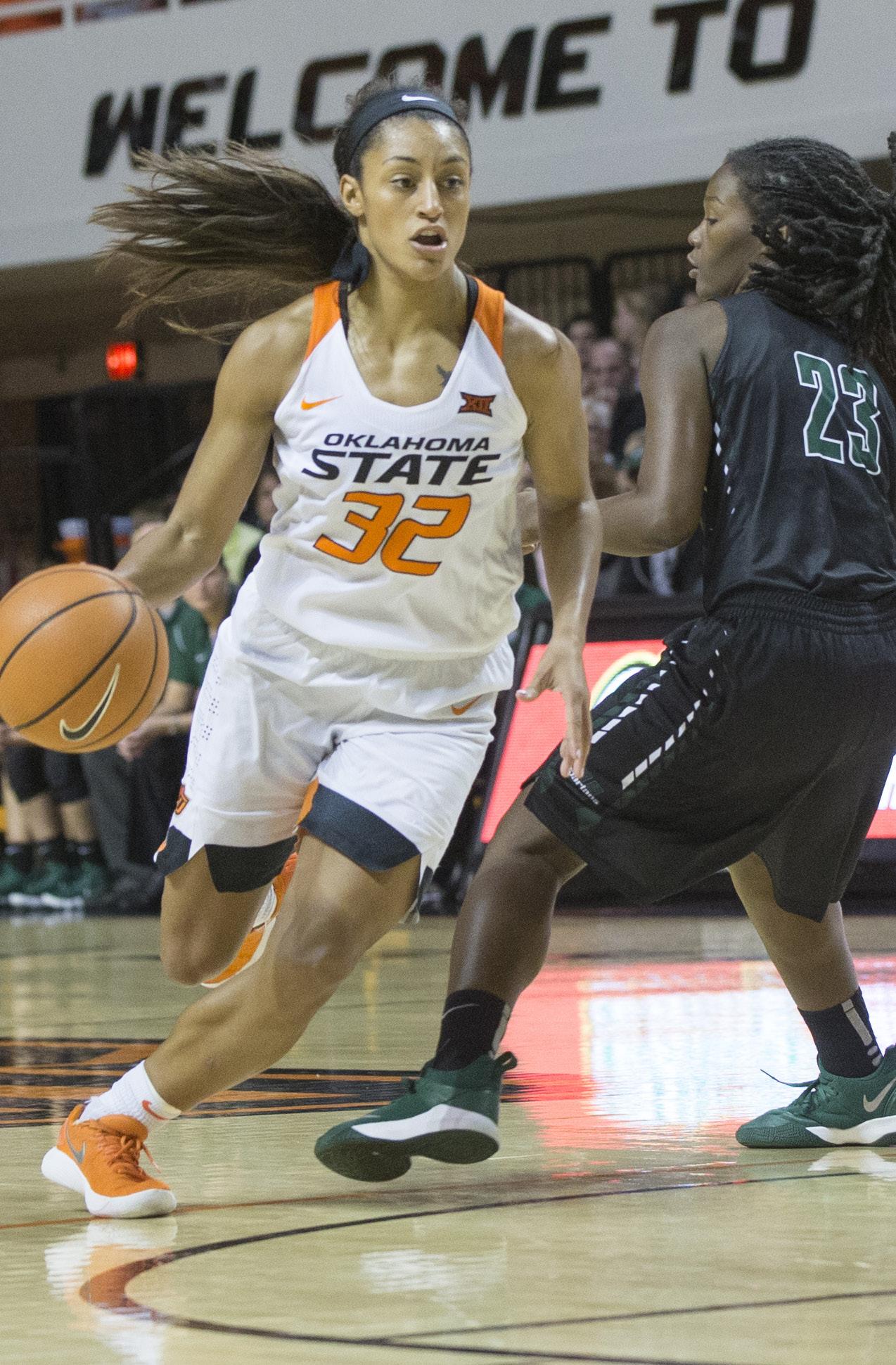
Goodwin played her freshman year at North Texas, averaging 13.1 points and breaking the school record for 3-pointers in a season, earning the Sun Belt freshman of the year award in a strong debut. Still, with Aston gone, she sought a fresh start, and headed for Butler.
The move to Indianapolis required a leap of faith, although the opportunity to play for Butler coach Beth Couture offered appeal.
Then it happened again.
After Goodwin sat out the 2013-14 season per NCAA transfer requirements, Couture and her staff were fired that May. And, again, she’d be left with a coaching staff that didn’t recruit her.
33
She played the following season for Butler, and played well, leading the team in scoring at 15.6 points per game. Still, Goodwin sought something more, and headed homeward, landing at UTSA.
The move forced her to sit another season, although the NCAA would eventually grant her another year of eligibility. And the time off didn’t show as she returned to the court a year ago, when she led the Roadrunners in scoring, assists and steals and the Conference USA coaches named her newcomer of the year.
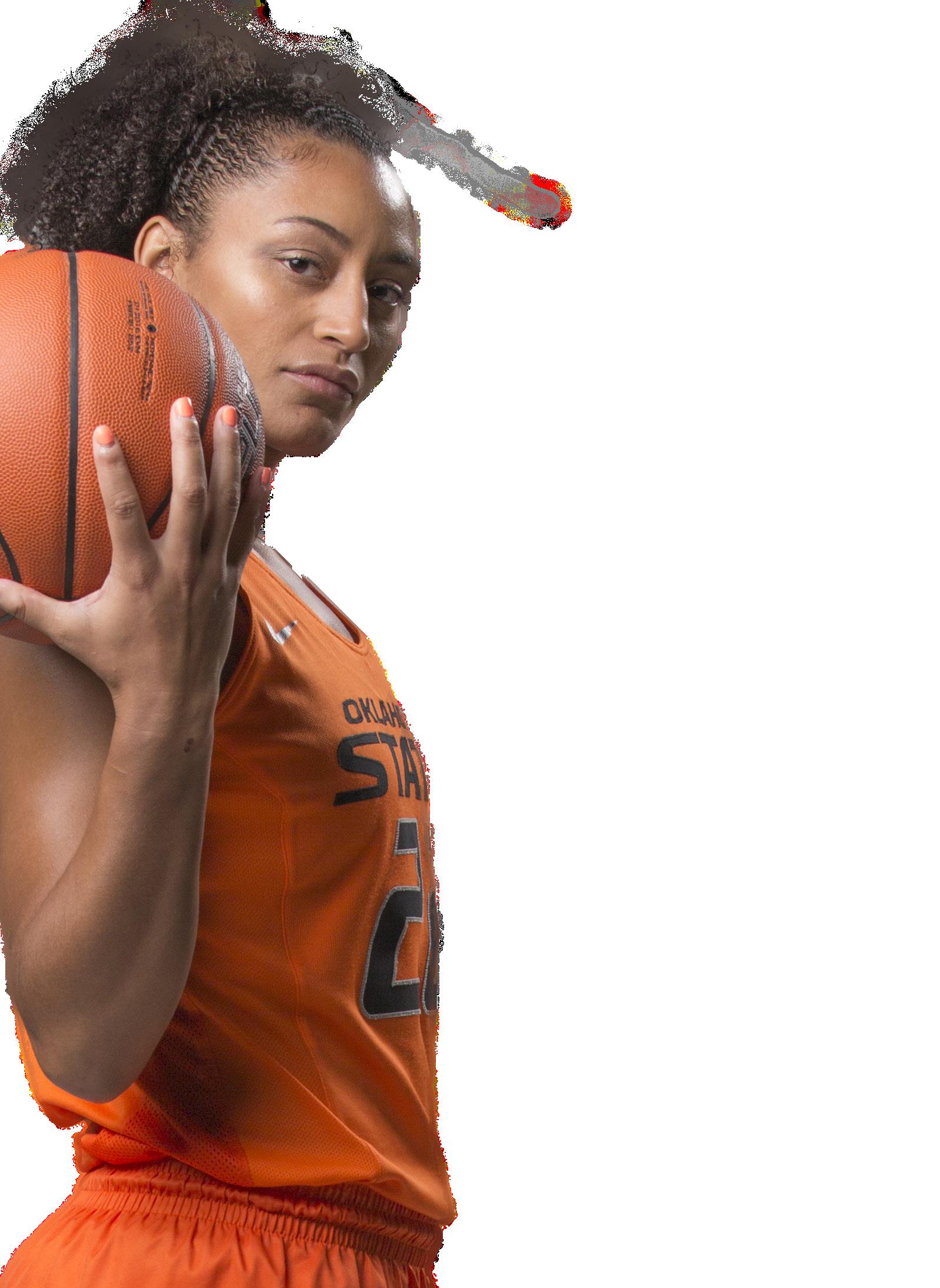

All was good … or so it seemed.
On her way to a business degree, Goodwin discovered that UTSA’s program required a minimum number of classes taken there. And she was lacking, forcing a late switch to a multi-disciplinary degree.
“That’s when I decided that if I wasn’t going to have a business degree, I had to have a master’s in business, because that’s what I want to pursue,” Goodwin said.
Soon she found out that UTSA was unable to offer the entrepreneurship program she wanted for her MBA.
“I was looking into their program, and was just basic classes. It was an extension of what I was taking,” she said. “I was like, ‘I can’t do that.’
“At some point, the ball’s going to stop bouncing and I’ll need a career.”
She’s got that figured out, too.
After graduating from UTSA and looking for a grad program centered around entrepreneurship, she identified OSU as a possible destination. Once on campus, Goodwin went to work on her classes the same way she works over opponents—with aggression.
She took a hefty graduate load of 12 hours and aced it.
“I have a 4.0 so far. That’s good,” she said in a major understatement.
Goodwin recognizes her growth, too, by simply looking around her classrooms.
“I’ve met a lot of people, and much of them are much older than me, so it’s a new environment for me, being around people who are already into their careers and seeing what they’re doing right now,” she said.
“There’s a guy who is in engineering, but he wants to open his own firm, and he’s married with two kids. And there’s a woman who wants to open her own boutique, and she’s currently working for a computer software company.
“Those are the kind of people I’m meeting now, compared to before, with people on the same route as me and in the same year as me. I’m meeting people who are wise beyond my years.”
Goodwin has gathered some wisdom of her own along the way, gaining perspective and taking something positive from each of her stops.
SPRING 2018 34
At North Texas, she learned to fill a role, with the coaches there asking her to focus on shooting and scoring from the No. 2 guard spot.
“That was my role, and I wanted to be my best in that role,” Goodwin said. “I feel like I did that. I wanted to become freshman of the year. And I did that, being just a shooter.”
At Butler, it was more personal.
“I probably learned more at Butler than in my whole career,” she said. “I was so far away from home. The weather was different. And the academics were pretty straining. But I learned how to balance it all.
“I learned how to be on my own and wear business attire and work on my résumé and go to career fairs and be an adult. I grew up on my own at Butler, a prestigious university, and met a lot of people who were in the same boat as me, trying to become business people.”
In San Antonio, Goodwin discovered her intangibles.
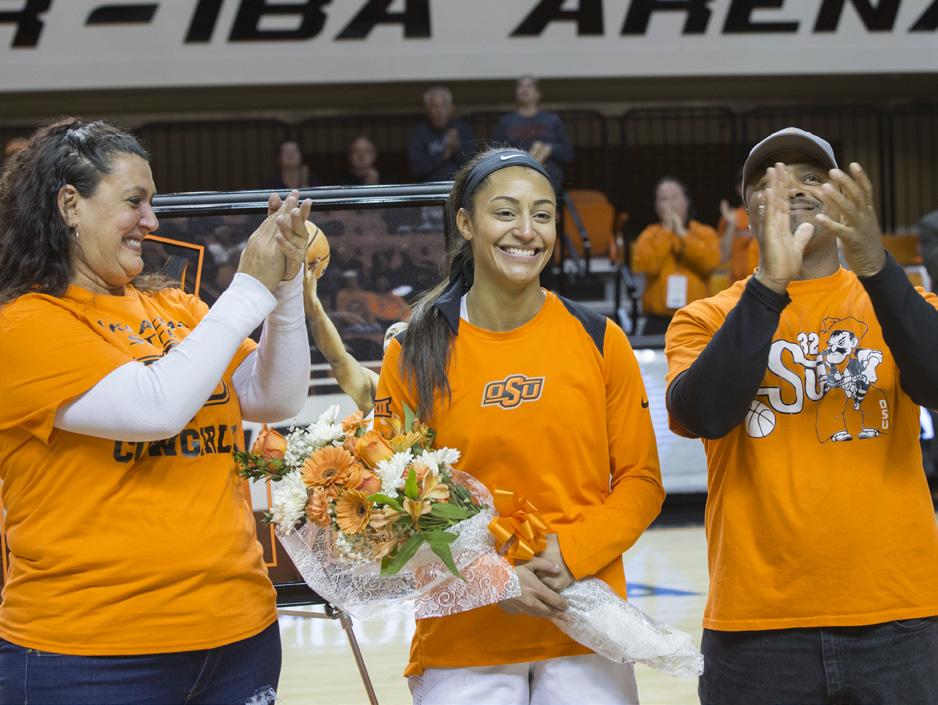
“I think I learned how to be a better teammate,” she said. “In the past I’d been a good teammate and learned how to get people involved, but at UTSA I really had to bring out the best in everyone around me in order to win ballgames.”
Four schools. Five coaches. Six years. The twists and turns.
“Throughout her entire life, we told Loryn, ‘No matter what happens, you have to out-work everybody else,’” said Loryn’s mother, Laura. “And that’s what she’s done. We told her, ‘Do the right thing. Be a good person. Follow what the Lord wants you to do. Be kind.’ And she did those things.
“As a parent, it’s hard to watch a child go through lessons. It’s easy to become frustrated with the process. While it broke my heart for her a couple of times, at the end of each of the little stops in her journey, I knew that Loryn had grown in a way that she may not have grown if that journey had not gone that direction.
“So at the end of the day, while the journey may have been challenging, for sure, Loryn came out of it a better person and a better basketball player. And a better all-around person who is ready for society. I guess it was God’s plan.”
Family prepared Loryn for all that has happened in so many ways.
Both parents were athletes, with Laura playing volleyball at Sam Houston State and dad Trampas a former football player at West Texas A&M. Her cousin, Marquise Goodwin, was a Texas Longhorn who now plays wide receiver for the San Francisco 49ers. Two younger brothers play football, basketball, run track and project to be Division I athletes; and have both attended football camps at OSU.
Loryn has always been good … at everything.
“Loryn played flag football with the little boys and was a running back,” her mom said. “And she scored so many touchdowns, outrunning those boys, they finally started tackling her, even though they weren’t in pads.
“Scored goals all the time in soccer. She was 5 and 6 years old and dribbling behind her back and through her legs. Good at volleyball. Became a track star later in the hurdles.
“She was a born athlete.”
Lately, the family influence has proven invaluable in another critical way, providing backup as a support system for Loryn through her many transitions.
“Throughout my journey,” she said, “my cousins, my parents, my siblings, they’ve all been so supportive in trying to keep it in a positive light in my mind. And pushing me to keep going.
“There could have been so many times where I settled and stayed at a school, with a new staff, and maybe not played as much or not become the player I could be, or I wanted to be. And I just stuck with it, because my family was just so strong behind me and wanted the best for me and said to not settle for anything.
“They said if I could become a better person in a better situation, for yourself, for your family, just do that.”
She’s done just that. And she’s not done yet.
There may be more basketball in Loryn’s future, perhaps professionally overseas. There’s business, too, as she charges toward a master’s degree. Her ultimate dream: owning and operating a physical therapy clinic.
The business plan is to get back home, too, in the Houston area, near the family that steered her right, even among the twists and turns.
“My parents always said, ‘Always work hard and be a good person and everything will work out,’” Loryn said. “I’ve seen that seriously. I’m going to live by that, because that has been the thing that has helped me this whole time.”
“It’s NO ACCIDENT she had a great year, because she invested a great deal of time in her game.”
35
— JIM LITTELL





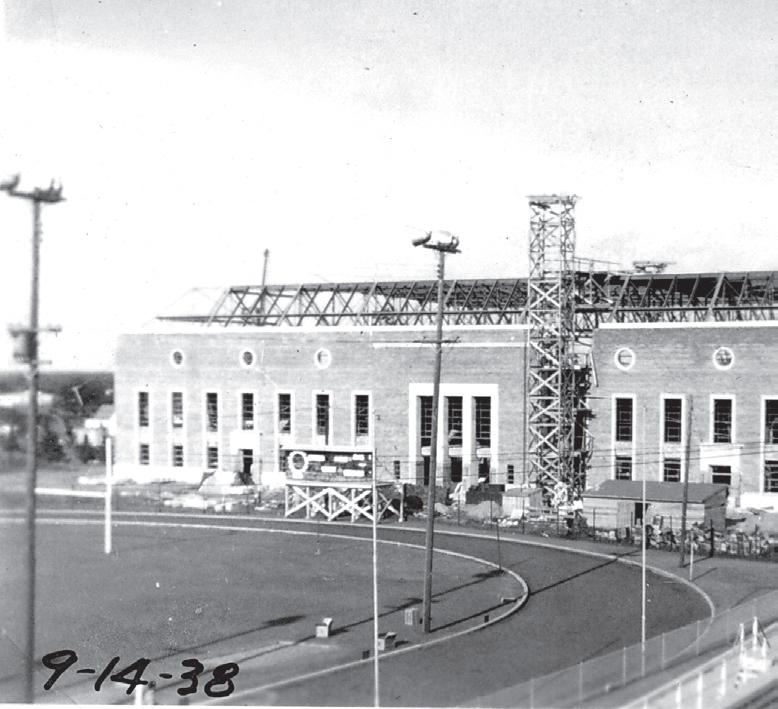
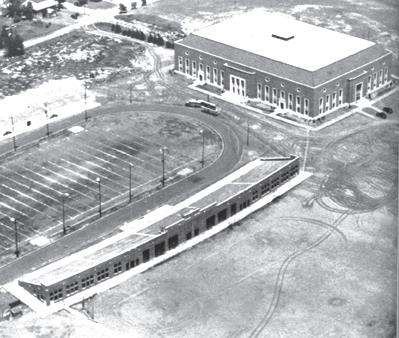
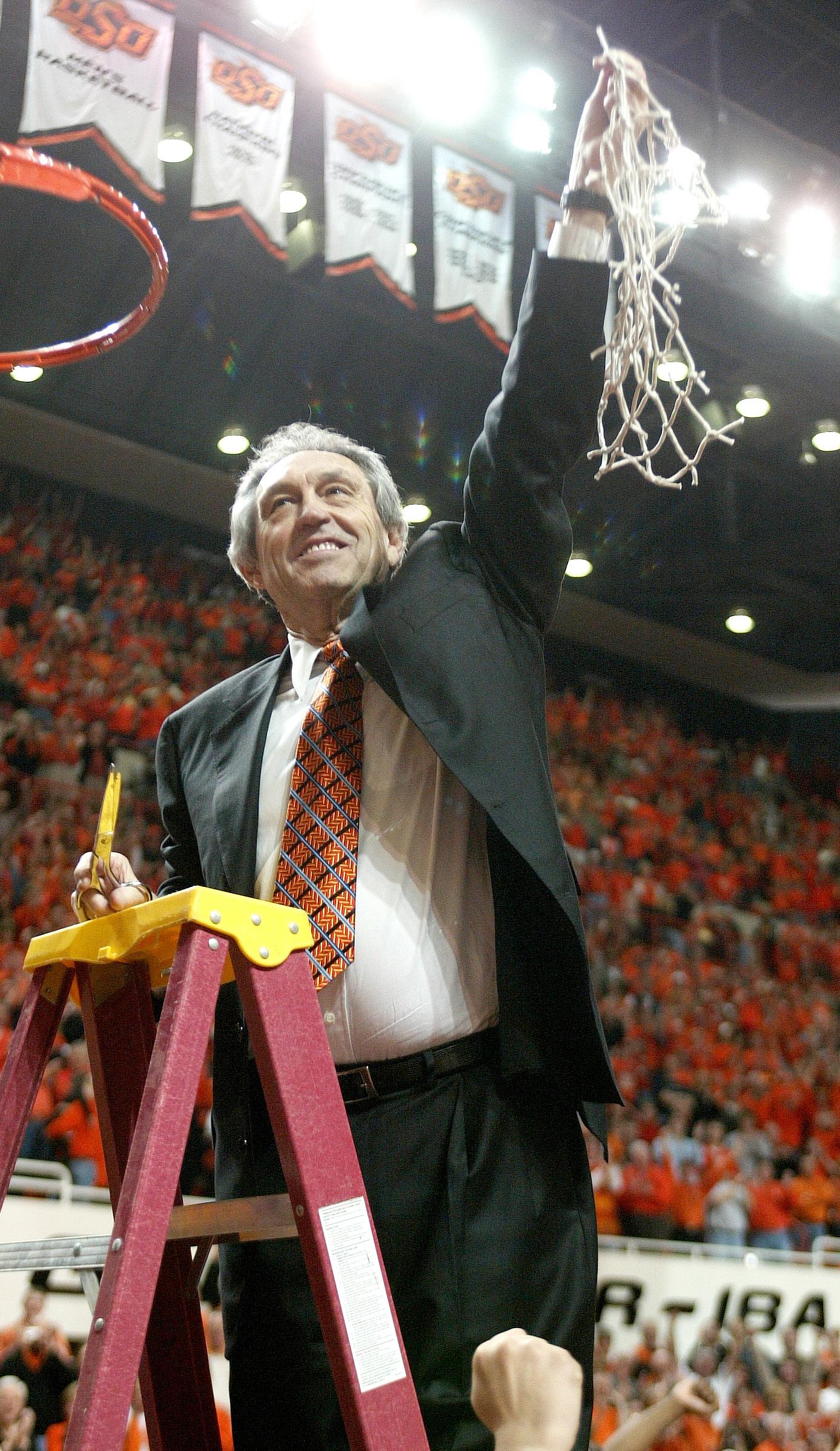
SPRING 2018 38
PHOTO / GEORGE BULARD
DUCK AND HALL OF FAME …
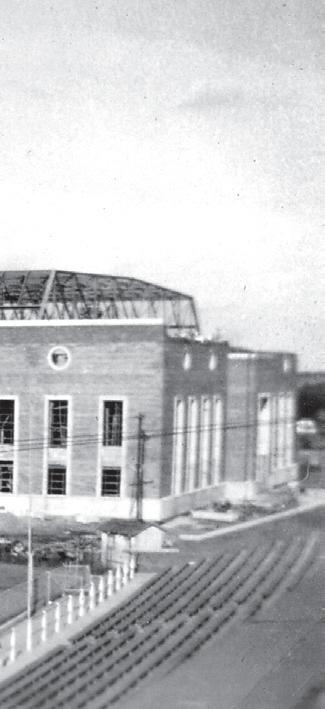
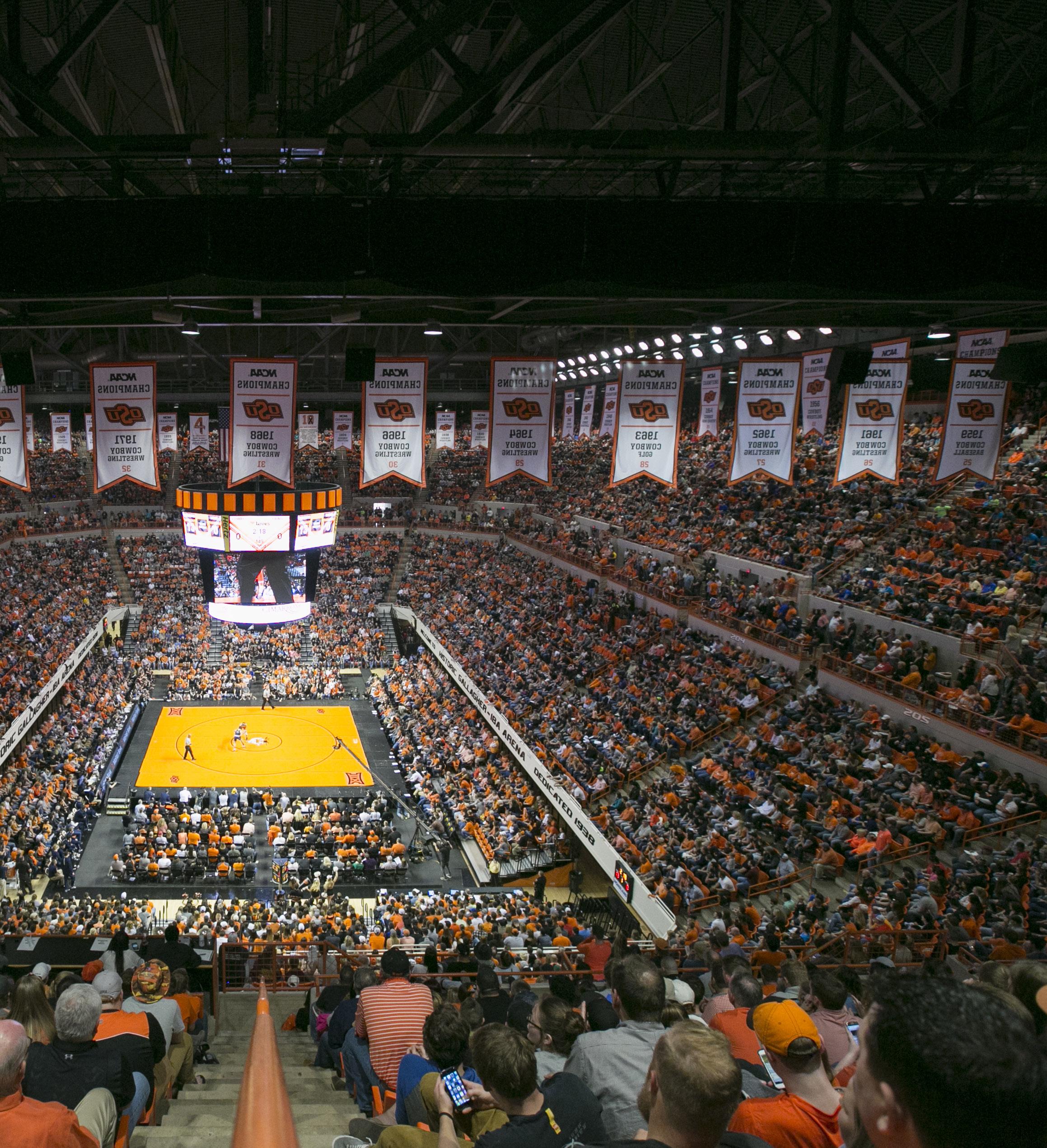
STORY
BY TOM DIRATO on the corner of
39
Iwas recently cleaning out the home office when I ran across a couple of boxes tucked away in a closet. To be honest, I’d forgotten all about those cardboard containers since I settled into retirement. But, I must admit I was curious to see what I’d filed away a good number of years ago.
It didn’t take long to drift back in time. I discovered old media guides, notebooks and stories I’d written dating back to my first days on the Oklahoma State campus almost four decades ago. Things I turned to on a daily basis for the better part of 40 years were now literally collecting dust. How sad, I thought.
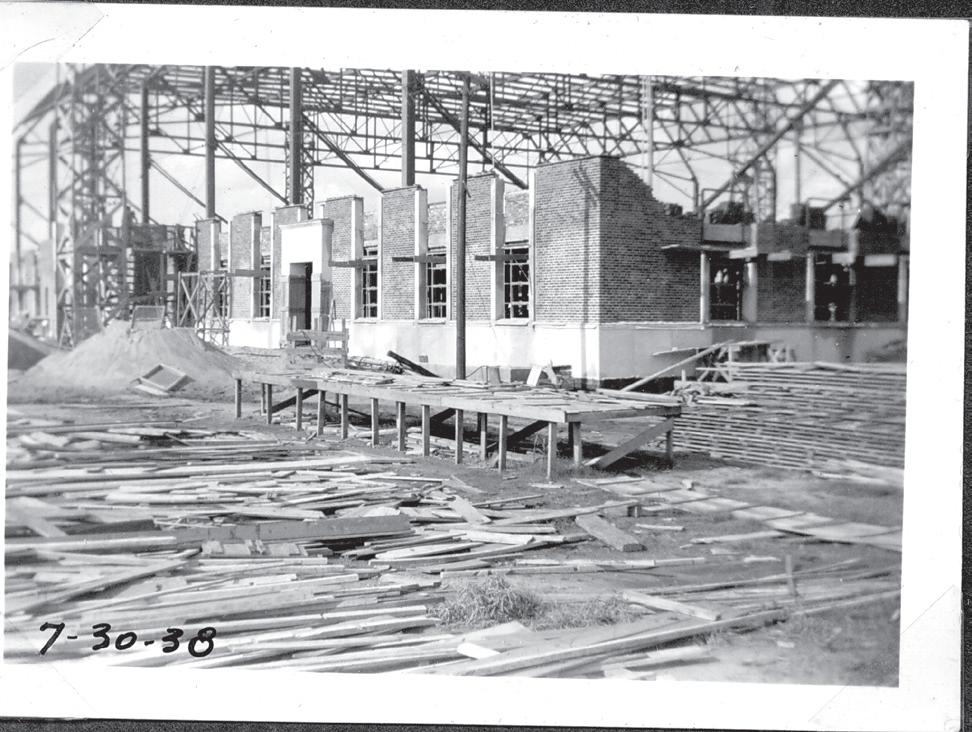
So, I decided to take myself down memory lane. I uncovered information about Cowboy basketball that I hadn’t thought about for years and years. The more I looked, the more I found. I thought, why not share some of these fun facts with people who love this tradition-rich program as much as I do?

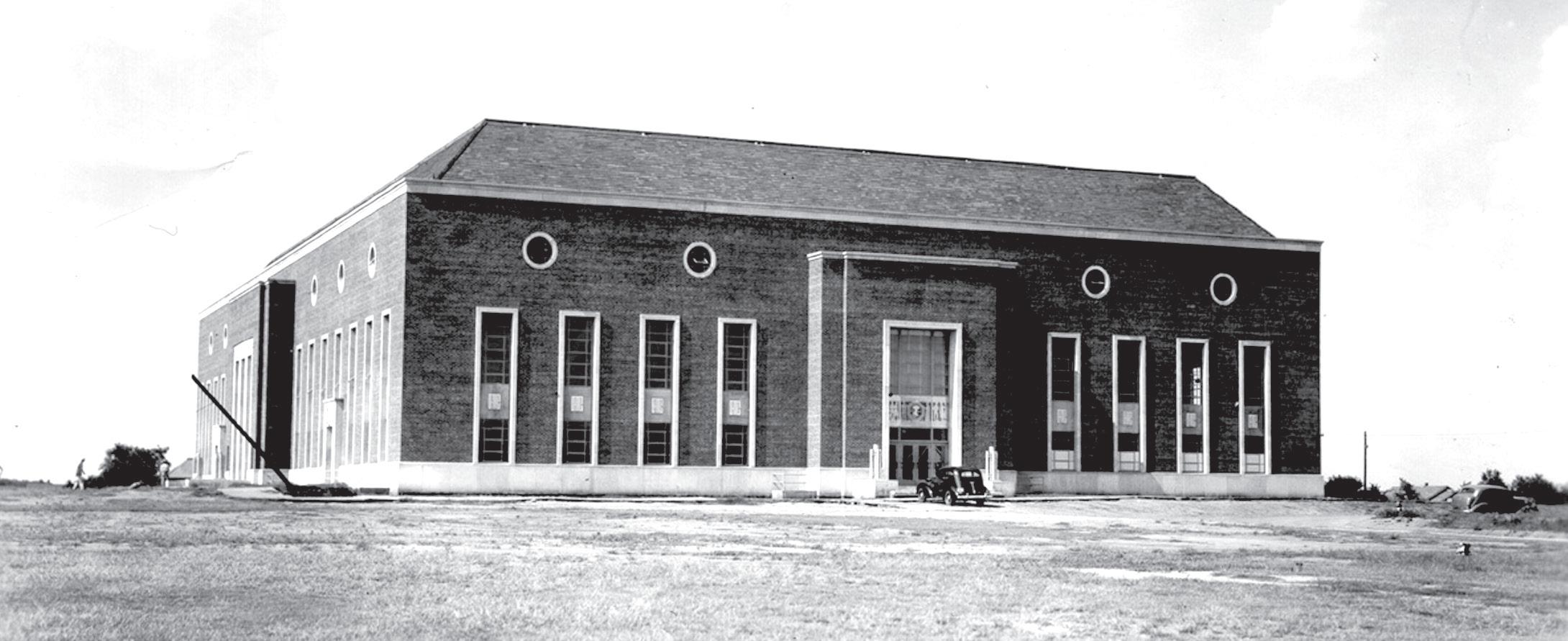

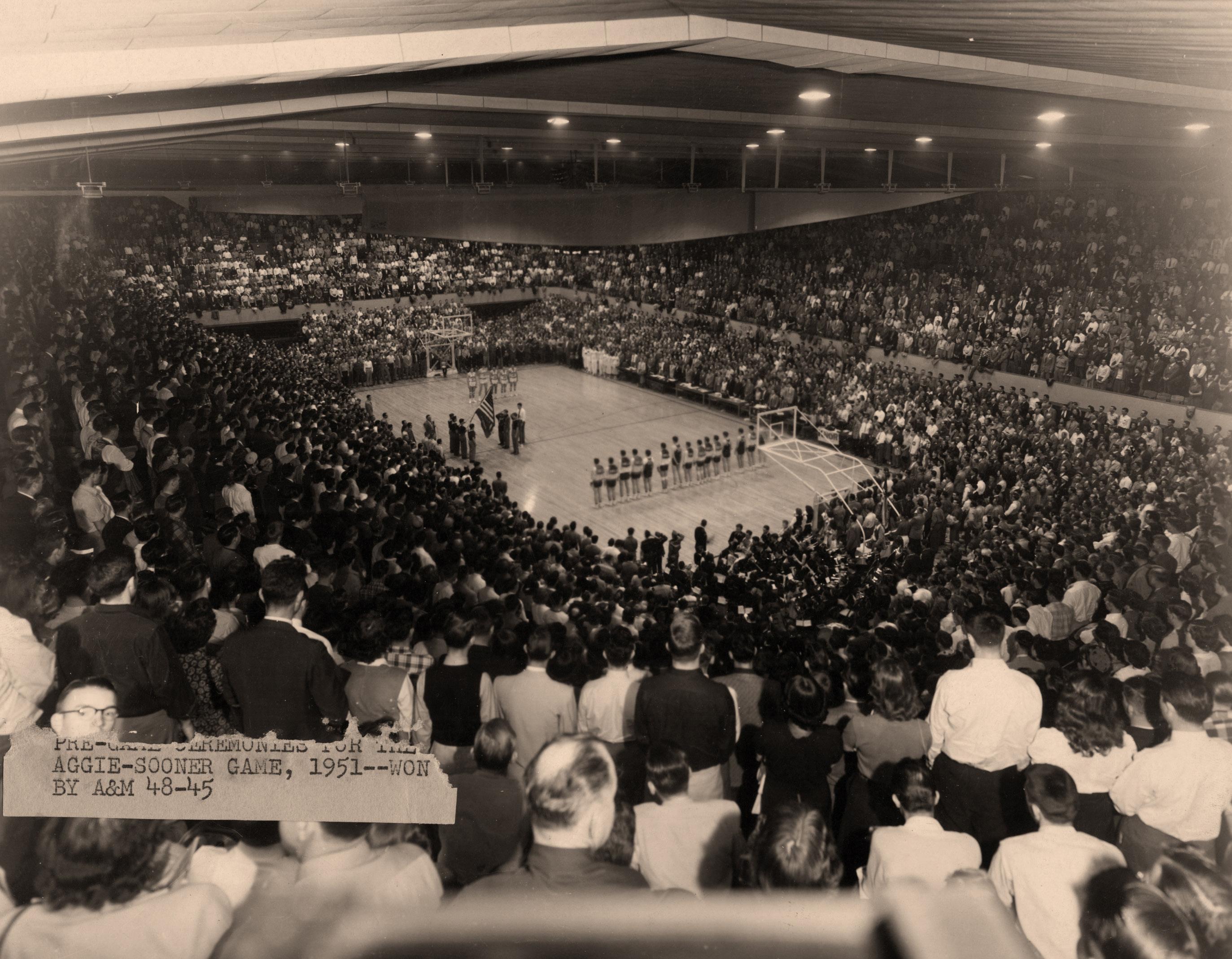
SPRING 2018 40
I called Gallagher-Iba Arena home for three-plus decades. I had six different offices during my stay in the Athletic Department. Each one had a uniqueness that made it special. I was part of the two renovations that turned Gallagher Hall into one of college basketball’s showplaces—a building we now know as Gallagher-Iba Arena.

One of my favorite descriptions of this grand structure came from national writer Dan Wetzel back in 2001 when he was working for the CBS Sports website.
“The ultimate combination of history, uniqueness, location and excitement, Gallagher-Iba has even survived a recent expansion to remain the nation’s best facility to catch a game. How much tradition does the old barn out where the wind comes sweeping down the plains have? The first game in 1938 featured Henry Iba besting Phog Allen’s Kansas Jayhawks 21-15. The maple playing surface is the building’s original and it has not only seen countless great games, it has seen practice sessions where Iba literally invented concepts such as a motion offense and manto-man defense.
“Iba also encouraged the creation of one the first student sections, where everyone wore identical orange suit coats and rang cowbells. It is truly college hoops hallowed ground. Before expansion, when GallagherIba held just 6,381 fans, this was easily the loudest arena in the nation. A well-planned expansion called Raise the Roof changed none of the ambiance, kept all the original seats and sight lines and somehow increased the noise. The renovation of the building, once called the Madison Square Garden of the Plains, has opened up the experience to even more of the passionate loyal and down-to-earth Cowboy fans that have made this college basketball’s best for 63 years.”
Read that passage again. It sends shivers of pride up and down my spine every time I let those words sink in. To this day, that eloquent description is spot on. I can honestly say I have never lost sight of the fact this has been, and will always be, a centerpiece for Oklahoma State athletic history. It still has a tremendous impact on me even though I only visit two or three times a week.
Not too many people recall that the original Gallagher Hall was built in 1938 at a cost of $389,000. As Wetzel pointed out, national powers Oklahoma State and Kansas opened the facility on Dec. 9 in a game that featured coaching legends Henry Iba and Phog Allen .

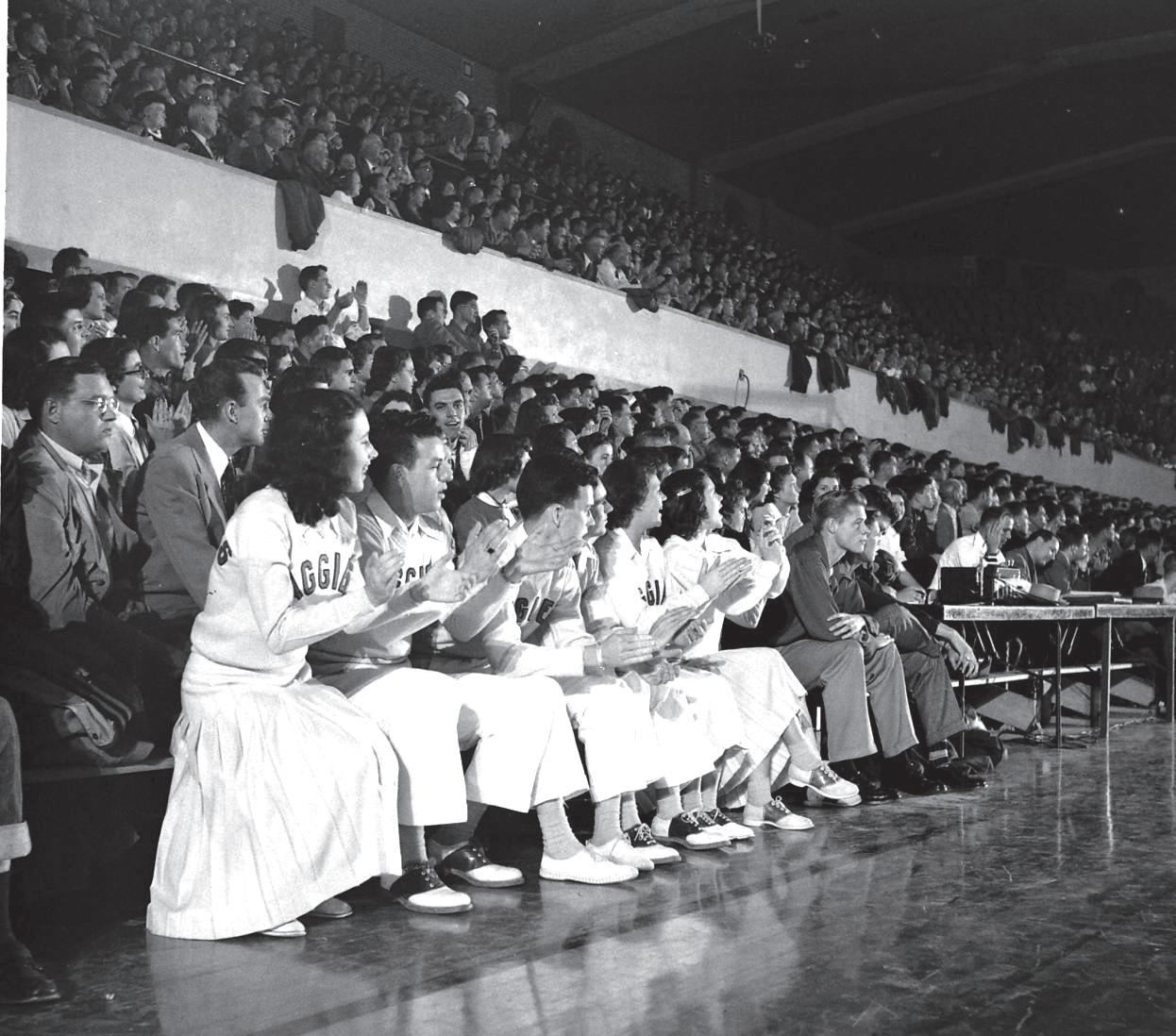
41
History tells us the grand old arena was first known as the 4-H Club and Student Activity Building with a seating capacity of 9,000. Better known as Gallagher Hall and Gallagher Fieldhouse, seating numbers decreased over the years, primarily due to fire codes. By the ’86-87 season, which was prior to the first renovation, official capacity was listed at 6,750.
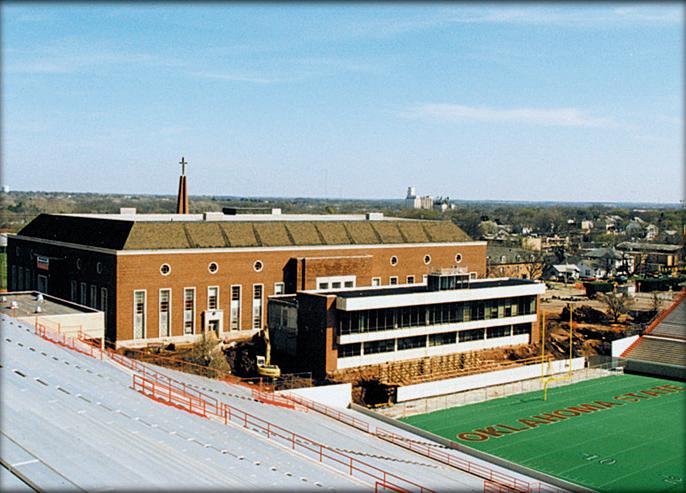
The first of two renovations came in 1987 at a cost of $3.8 million. Capacity was dropped to 6,381 and the building was renamed GallagherIba Arena honoring legendary wrestling coach Ed Gallagher and, of course, Mr. Iba
In 2000, the OSU Athletics Center was born. The price was $56 million. Capacity more than doubled to 13,611. On Jan. 15, 2005, the arena’s original white maple floor was renamed Eddie Sutton Court.


Through the first 79 years in this historic building, the home court advantage has been staggering. At this writing, Oklahoma State is 783-222 at home. That includes 10 undefeated seasons.
Some other tidbits I was able to find in several well-worn notebooks:
Mr. Iba and his Oklahoma A&M Aggies won 20-straight games when Gallagher Hall opened.
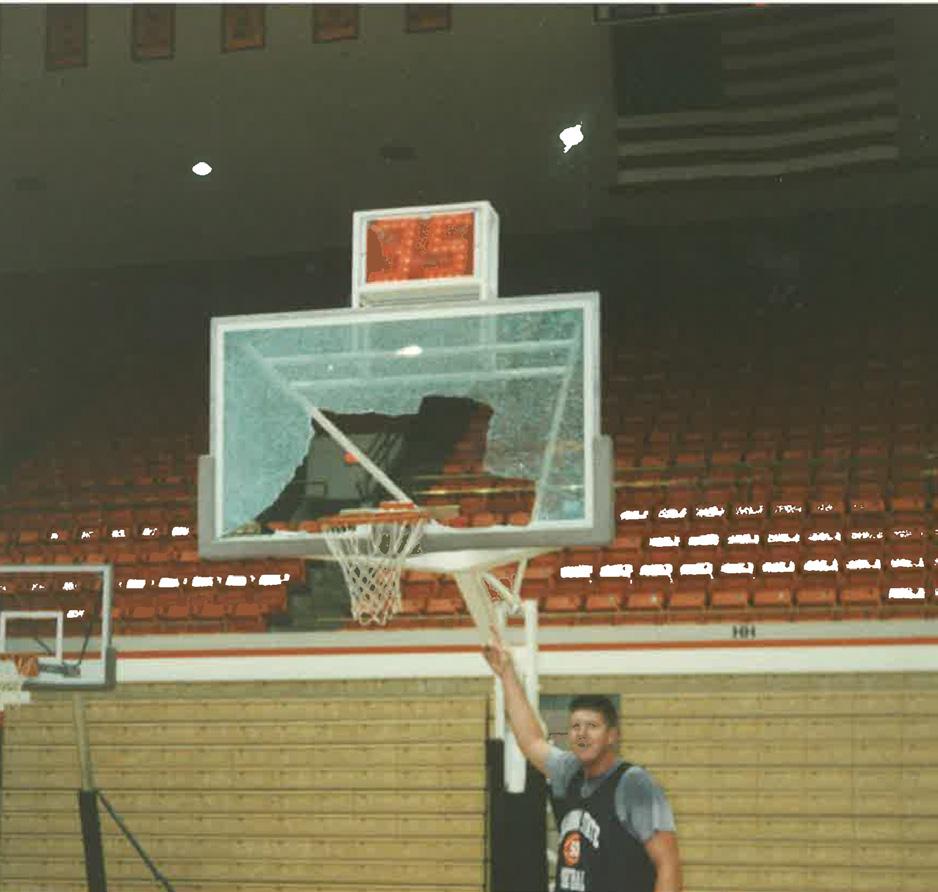
Oklahoma A&M won 31 in a row at home from 1943-45. The second longest streak of consecutive home victories is 29 from 2003-05.
More than two million tickets have been sold for men’s basketball games in Gallagher-Iba Arena since the 2000 renovation.
The most tickets ever sold to a single men’s game in Gallagher-Iba Arena (in the modern era) was 14,486 on Nov. 24, 2001. The opponent was North Texas.
More recently, a crowd of 14,059 was on hand for the muchhyped wrestling dual between Oklahoma State and Penn State in February of 2017.
Before we leave this subject, one final tribute to the building was provided by ESPNU. Several years ago Gallagher-Iba Arena was listed as No. 2 behind the historic Palestra in Philadelphia on the honor roll of greatest venues. Allen Fieldhouse was third, followed by Cameron Indoor Stadium, Pauley Pavilion, Madison Square Garden, Rupp Arena, Assembly Hall, the New Mexico Pit and Oregon’s MacArthur Court.
And now, how about some extra credit for those of you who really know your OSU basketball history?
Where did the Oklahoma A&M Aggies play before moving to the 4-H Club and Student Activity Building? Well, if you said the original armory (where the Business Administration building stood for so long) you are right. The Aggies played there from 1907-1919 when they moved into the new armory (old gym) which is now the Architecture Building just south of Boone Pickens Stadium.
I THINK WE CAN ALL AGREE that exhibition games are just that—exhibitions. Coaches get to try different personnel combinations and get a read on newcomers when, as they say, the lights come on and you can smell the popcorn.
The Cowboys are 57-4 in exhibition play since the 1973-74 season and have won 30 straight. OSU is 20-0 since the NCAA rule change in 2005-06 that only allows exhibition games against other college teams.
SPRING 2018 42





DAN WETZEL 43
“... this was easily the loudest arena in the nation.”
Since 1973, Oklahoma State has faced foreign national teams, all star teams, faith-based teams and teams made up of former players. The one I still remember like last week came back in 2000 when Athletes First took on the Cowboys. The game was played in Enid because Gallagher-Iba was still under construction.
Athletes First won that night 96-95. Big Alex Webber, a 6-10 Searcy, Ark., center, led the way that night for the visitors. Webber, who played for head coach Eddie Sutton (’962000) had mixed emotions after the game.
“I’m glad we won. It was good to see Coach again, but I think I’ll wait to visit with him. I know that is not a happy locker room right now,” Webber, who is a fixture in the Stillwater community, laughed. “I’ve been in a few of those, and Coach isn’t happy at all—even if it was just an exhibition.”
Webber was right. No loss ever sat well with Sutton. As I recall, the next few days at practice were more intense than usual.
That loss ended a 22-game win streak that dated back to 1988 when the Cowboys dropped an 80-63 decision to an outstanding Soviet Union team led by Sharunas Marchulenis , Arvydas Sabonis and Alexander Volkov
OVER MY 30 YEARS BEHIND THE MICROPHONE
I had the privilege of calling some of the greatest basketball games in Oklahoma State history. Even better, I got to know hundreds of players during that time—some of the best to ever to ever represent OSU on the hardwood. A good many of those players are close friends today. I still see them as 18-to-21-year-old studentathletes, when in fact some have kids that age or older. That goes with getting old I guess.
I covered one individual as a reporter for the old Oklahoma Journal back in the early to mid-1970s. In my opinion, he was one of the most dynamic players to ever wear an Oklahoma State uniform. Unfortunately, not many people in this day and age remember the name.

SPRING 2018 44
Andy Hopson was a rugged, tough-minded young man from Chicago. Every rebound seemed to have his name on it—whether it was offensive or defensive. Over his three-year career, he pulled down 20 or more rebounds in a game 11 different times. Let that sink in for a second. Twenty or more rebounds in a game on 11 occasions! He stills ranks as one of the most prolific rebounders in school history. He averaged 13.1 rebounds per game in his OSU career.
Let me put it another way for you. Only a handful of Cowboys (Bob Mattick , Mario Boggan, Bryant Reeves , Don Youman and James King) ever had a 20-rebound game. Hopson, who is third on the all-time career rebound list, had 11 such games. He was simply amazing to watch.
IF YOU ARE ONE OF THOSE PEOPLE who are fascinated with uniform combinations and numbers, the following is for you.
Former Cowboys to wear the number 5 include Corey Williams, Victor Williams and Marcus Dove . The number 23 was worn by Chianti Roberts , Ivan McFarlin and James Anderson , just to mention a few. And, what about the number 34? Eddie Sutton, Desmond Mason and Melvin Sanders wore that number proudly.
The first year of college basketball on the Stillwater campus took place way back in 190708. It was a short season. It was also a year in which long distance travel was obviously kept to a minimum. Oklahoma A&M played just five games that year. The lone road win came in Oklahoma City. The Aggies split home games with Tulsa, but lost both to Oklahoma. The coach that year was Boyd A. Hill
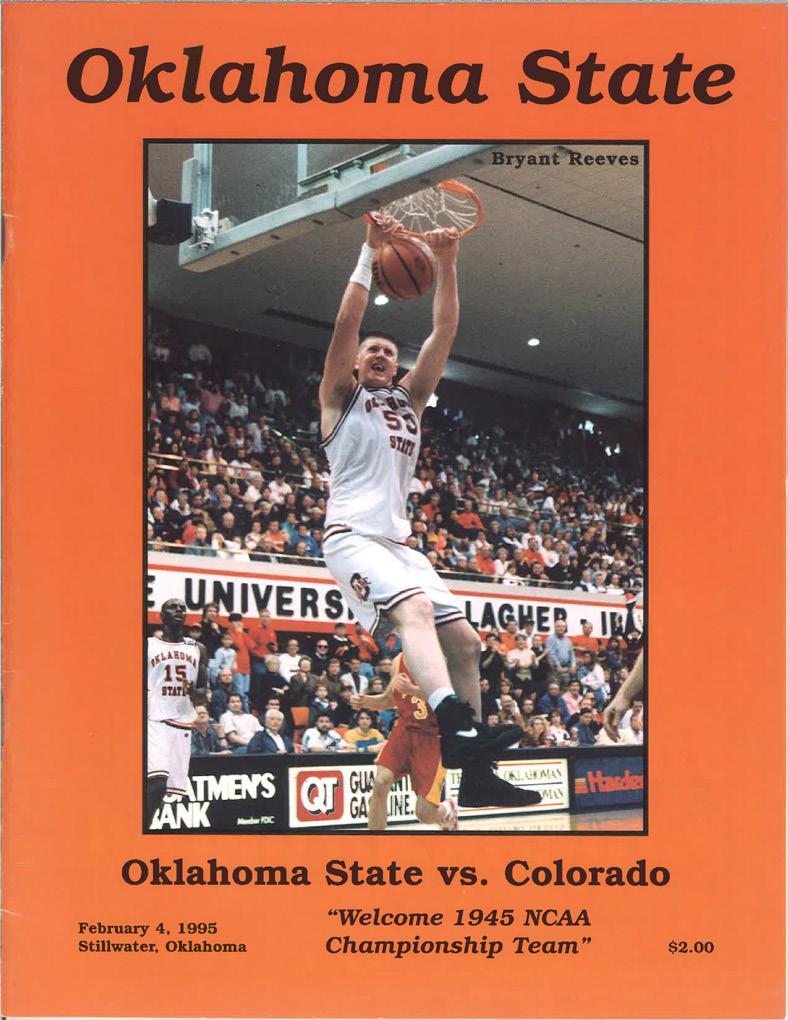
MITCHELL SOLOMON RECENTLY JOINED a very exclusive club at Oklahoma State. He is part of a group that has 500 rebounds, 100 blocks and a career shooting percentage of 50 percent or better.

The 500-100-50 club has some distinguished members to say the least. Leroy Combs , Joe Atkinson, Byron Houston, Bryant Reeves , Andre Williams , Ivan McFarlin and Michael Cobbins join Solomon in that group.
If you think Oklahoma State has had a lot of success against Kansas during the Bill Self era, well, you are right. OSU recently joined Iowa State as the only programs to win twice in Lawrence during Self’s tenure. But no program has beaten KU more over the last 10 years than Oklahoma State. OSU has eight wins over the Jayhawks since 2008.

Mike Boynton became just the fifth firstyear head coach to win in Allen Fieldhouse and the first since Bill Frieder’s Michigan team turned the trick back in 1980.
The Cowboys have advanced to the NCAA Tournament in four of the last five seasons and 28 times overall. They have six Final Four appearances—1945, 1946, 1949, 1951, 1995 and 2004. OSU is tied for the 10th most among all schools. OSU became the first program to win consecutive NCAA championships in 1945 and 1946. The two championships tie the Cowboys for ninth nationally.

OSU has won 20 or more games 35 times in school history, and those 28 appearances in the Big Dance are tied for 25th most in the NCAA.
In the AP poll era (since the 1948-49 season) the Cowboys are 10-6 (62.5 percent) at home against teams ranked in the top three. That is second in the country only behind Indiana (63.6 percent). Overall, the Cowboys have 14 wins against top three teams. That total includes three wins over a team ranked number one. OSU currently owns 49 wins over top 10 teams.
I COULD GO ON for several more pages, but unfortunately space won’t allow that to happen. And to think all this came out of one box. I haven’t even unpacked box number two yet. Perhaps we’ll do this again soon. I was fortunate to accumulate a lot of great memories and good times over the years. I feel even more blessed now to share these stories with others.
45
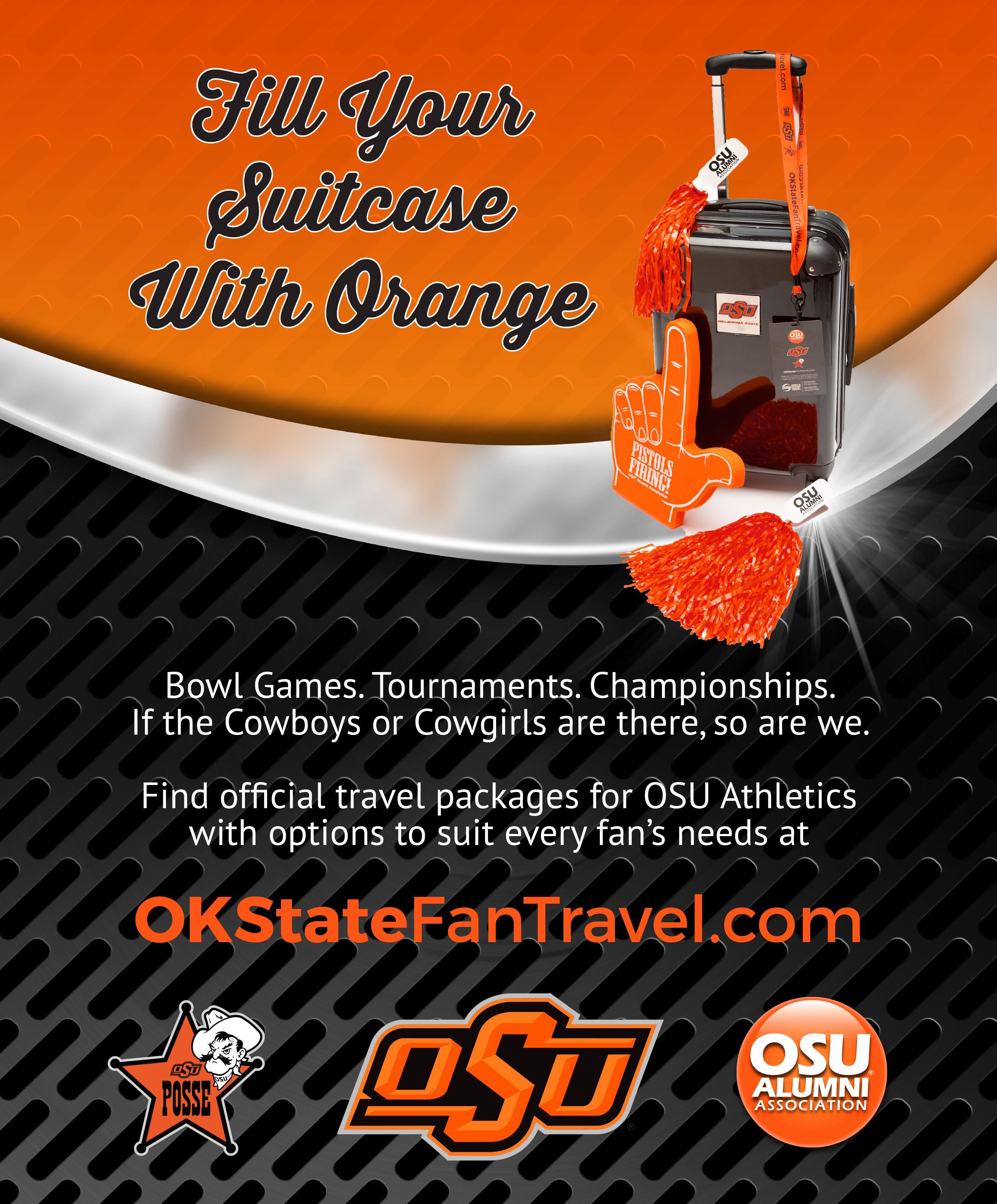

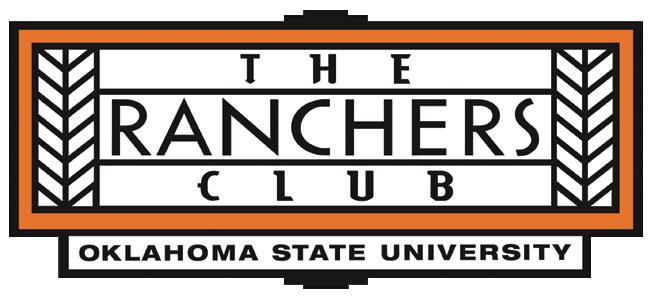
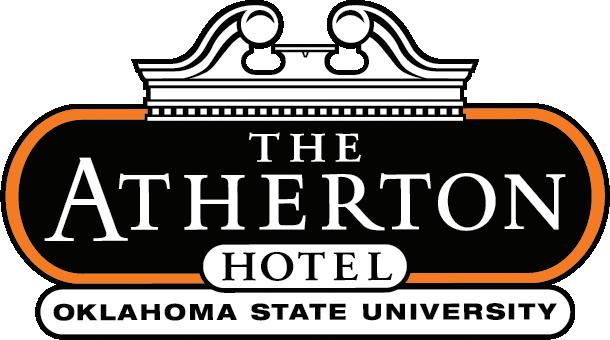
theRanchersClub.com AthertonHotelatOSU.com 405-744-BEEF (2333) 406-744-6835
MITCHELL SOLOMON
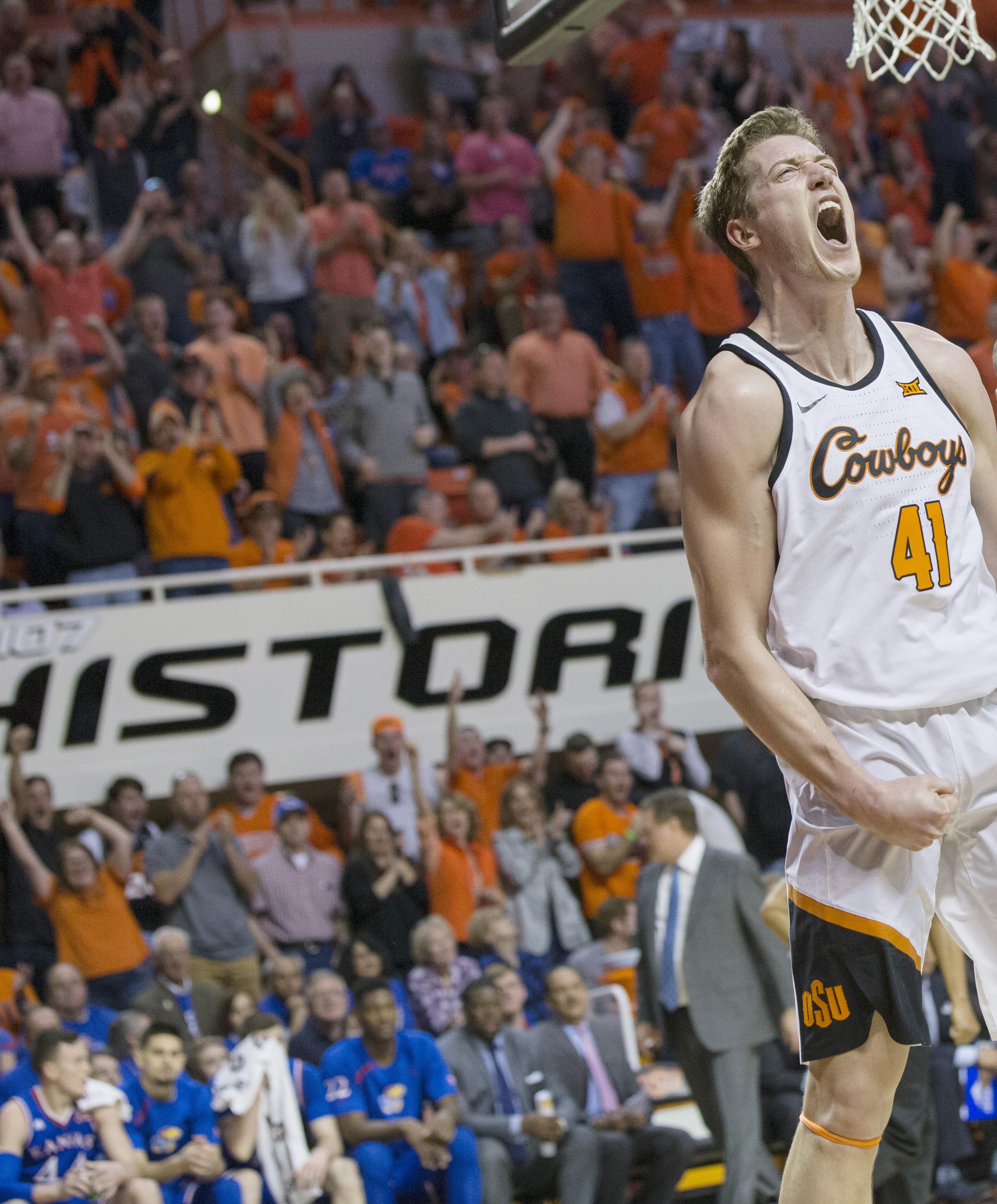
SPRING 2018 48
03/03/18 COWBOYS VS. JAYHAWKS 82-64
On Senior Day, Oklahoma State took down No. 6 Kansas for the second-time, becoming the first team to sweep the Jayhawks in the regular season since 2004. Cowboy fans rushed the court at the final buzzer as OSU claimed its fourth top 10 victory of 2018.
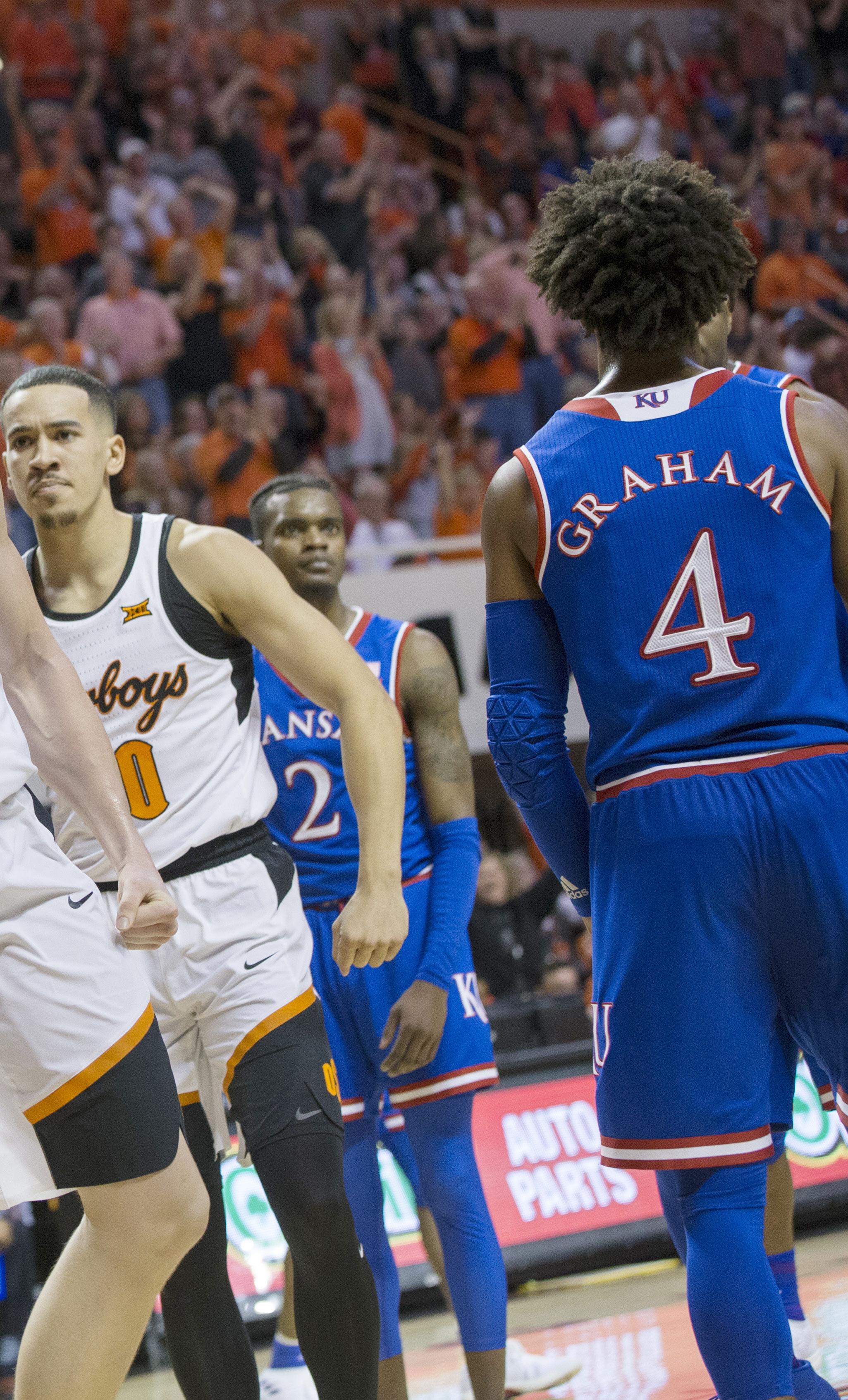
49
02/07/18
COWGIRLS VS. GATORS
4-3
Chris Young’s gutsy Cowgirl squad celebrates after knocking off No. 3 Florida — defending NCAA champions — at the Greenwood Tennis Center.

SPRING 2018 50
DID YOU SEE IT?

51
AFTER 32 YEARS AS THE MEN’S GOLF COACH, MIKE HOLDER WAS NAMED ATHLETIC DIRECTOR AT OKLAHOMA STATE ON SEPT. 16, 2005. THE LENGTH OF HIS TENURE AS AD IS ECLIPSED ONLY BY THOSE OF ED GALLAGHER AND HENRY IBA . HOLDER RECENTLY VISITED WITH POSSE MAGAZINE ABOUT HIS TIME IN THE AD’S CHAIR.
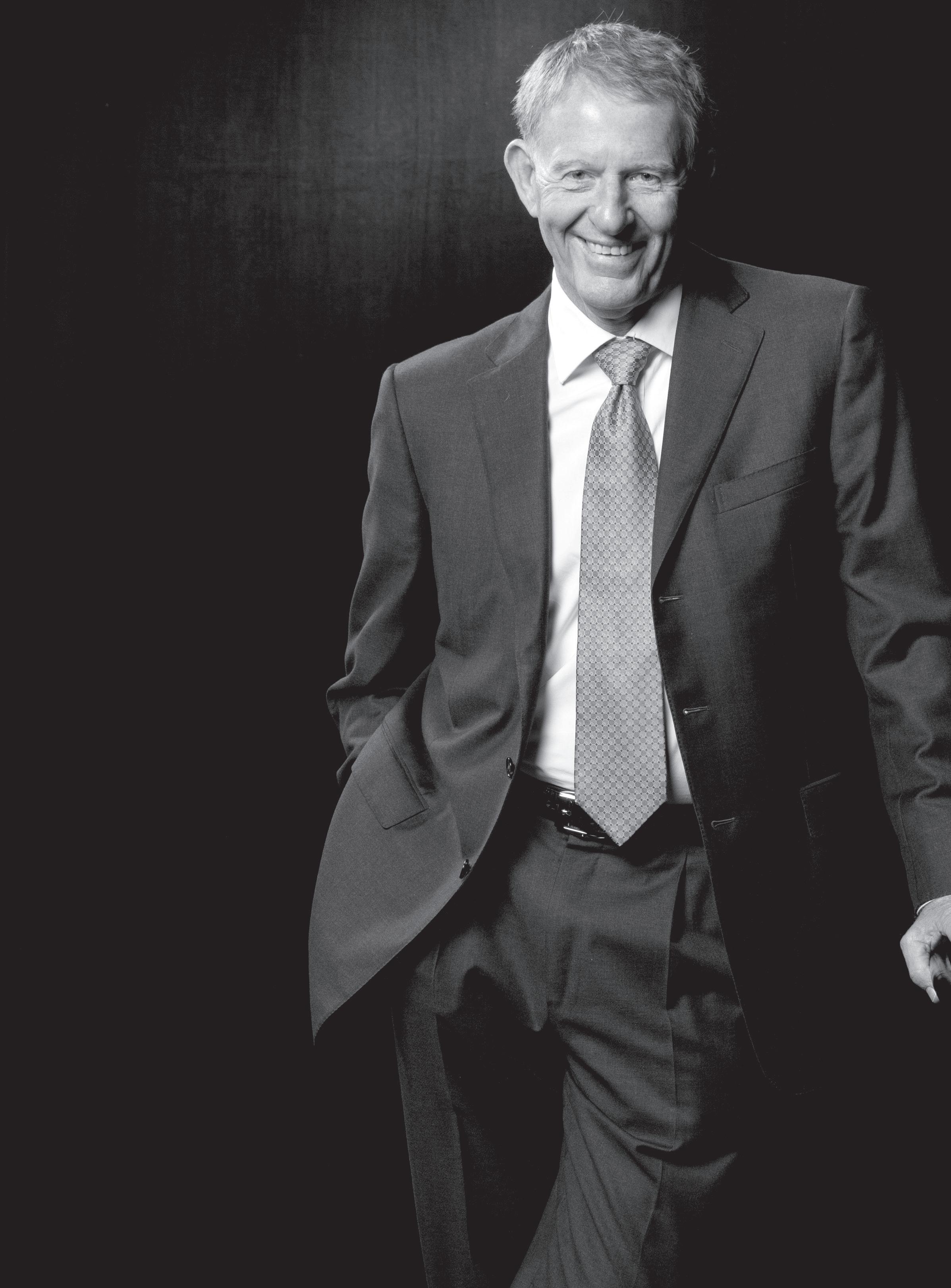
SPRING 2018 52
in the words of Mike Holder
STORY BY KEVIN KLINTWORTH
You replaced Harry Birdwell in 2005
PHOTOGRAPHY BY BRUCE WATERFIELD
Harry was great for me. He probably did more for the golf program than any other athletic director. He got Cowboy Golf incorporated. He helped us gain some independence and the ability to manage our money, control our own golf course (Karsten Creek) and set us up for a bright future. I can never thank him enough for caring about the golf program.
How did you become AD?
Boone Pickens and I became really, really good friends after his best friend, Jerry Walsh, and his wife, Jane, were killed in a car wreck. That was in November of 1995. I hunted quail with Boone maybe one time that hunting season, and then the next year we hunted every time he got the urge to hunt. The way the golf schedule worked, I had a little bit of time in late November, December and January, and we ramp back up in February. We spent a lot of time hunting and talking. The mutual interests we shared other than hunting were OSU and athletics. We talked about all the sports, the frustrations we shared on football and our lack of commitment to football and the sorry state of our football stadium –all the things that everyone talked about among themselves.

53
But it was just talk
Neither one of us had enough money to do anything about it. It was just wishful thinking. Then in 2000 he started making money, and I told (former OSU AD) Terry Don Phillips he needed to talk to him because we need to do this football stadium, and I think he’s got some interest in that, and he’s actually got enough money to do something about it. We went out there to hunt quail and talk about raising money. That was an interesting deal. I can’t remember if it happened that time or a couple of trips later, but we were at breakfast one morning and Terry Don was talking to him about the football stadium and Boone asked what he could do for us immediately that would make a difference for football. Terry Don’s thoughts were that we needed to focus on the stadium. He didn’t think we needed to get distracted from that. My thoughts were that we were leaving money on the table, and it never hurts to ask.
And that set the stage for your position change
Asking people for money is an acquired taste. I don’t think it’s in anybody’s nature to do that. But I had a lot of experience doing it because I had no choice. With our golf program, if I didn’t raise money, we were never going to be any good. So out of necessity I’ve learned to ask and be aggressive about it, and I’d done that close to 25-30 years at this point in time. So that was in 2000, and I think Boone finally gave that gift of $20 million in 2002. He hosted a bunch of fundraisers out at his Mesa Vista ranch trying to get other people involved. That’s how we got the south side of the stadium started. Then Terry Don left to go to Clemson and to keep the momentum they put Harry Birdwell in charge of athletics until he stepped down in 2005. And as I continued to pester Boone about money, he came up with that idea about me becoming the AD.
And he was serious about it
I told him I had no interest in being the athletic director. I had the best job in college athletics, and I planned on doing it a long time. My wife NEVER wanted me to do it and tried to talk me out of it.
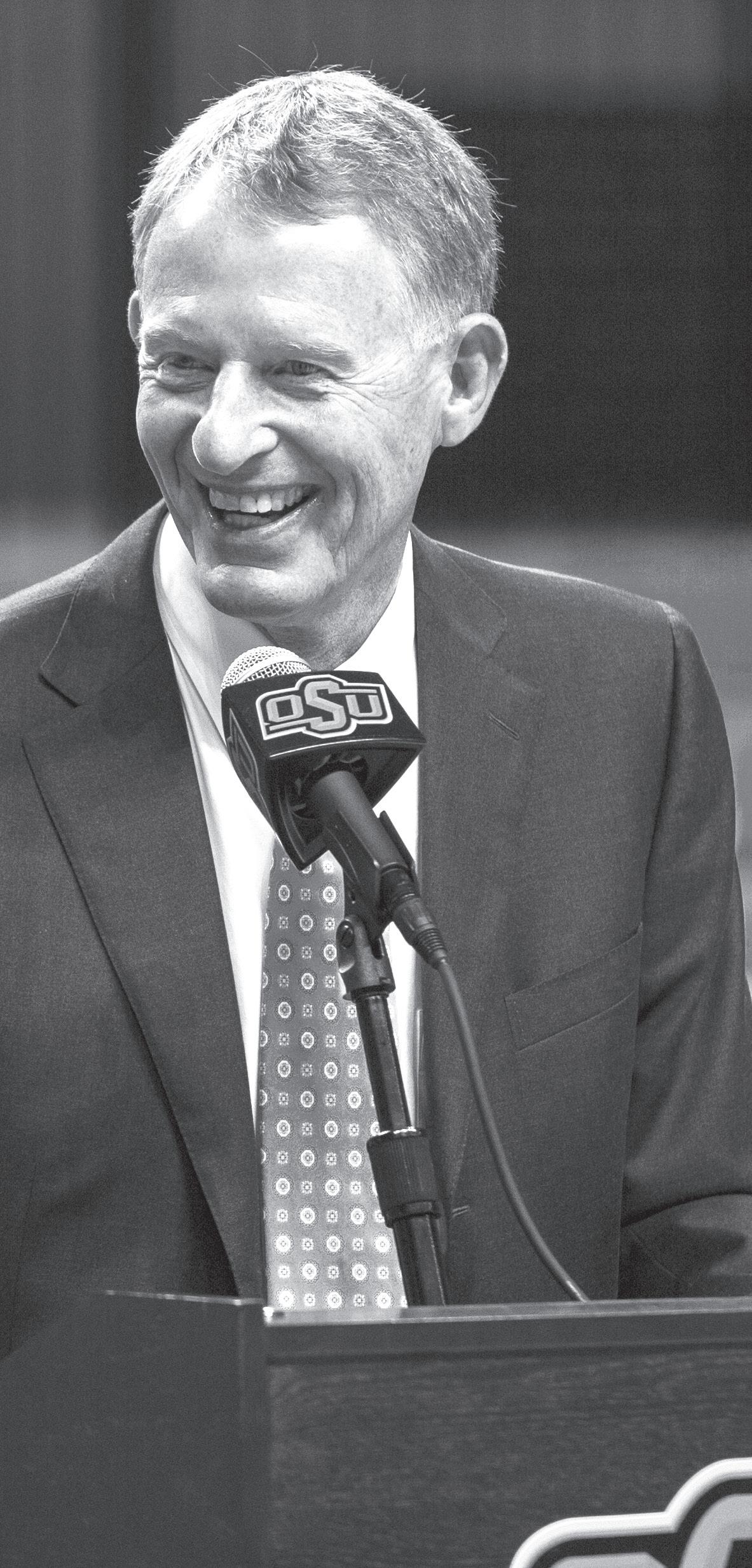
What tipped the scales?
I loved football growing up, and my dad was a huge football fan. He played football in high school and was the president of the quarterback club in Andrews, Texas, back in the 1950s. In the Permian Basin of Texas, football is everything … Friday Night Lights, Odessa Permian … that whole culture of football. I got so frustrated that we were never consistently any good in football. You get tired of going to the games on Saturday and not really feeling like you have a fair shot to win – that it’s a fair fight. You wonder what it could be or if you ever could be any good if you actually ever committed to football. Could we compete with all of the other serious programs? I guess what it actually came down to was that as much as I loved my job coaching golf – and I wanted to win more national championships than Dave Williams (University of Houston) … I guess I just had to see if it was possible. That’s why I did it. Honestly, I really hoped I couldn’t get the job.
SPRING 2018 54
PHOTO / MELISSA MORALES
What about Mr. Pickens’ game-changing gift?
About a month after I got the job I went to Dallas and asked him for $300 million. He said, “I’m not giving you $300 million. I’m not writing you a big check.” I told him then I would be like all of the athletic directors I had worked for the last three or four decades. We have no chance. We can’t be business as usual and change the paradigm for football. And really my goal was to give every sport a realistic chance to win the national championship.
He’s also a fan of people who invest in themselves
He loved people that had skin in the game. He always had his money in every deal he ever put together. And he liked other people to do the same thing. One of the reasons I was always able to raise money for golf was because I always donated money to the program myself. I was always just as committed or more committed. I felt like I was more committed than anyone I got money from because of the percentage of net worth. I had more money in the golf program than anyone else. So I knew that he would understand the significance of putting every single thing that golf had into the effort to build the athletic program.
So was it a Merry Christmas?
So it was a process?
He told me no in September. He told me no in October. Then we had Hurricane Katrina, and that changed the giving rules for the rest of the year. I thought that would be the impetus to push him over the edge. But in December he said no again. On Christmas Day 2005, I realized he’s not going to give $300 million. I started wondering what the least amount of money I could get from him that could make this thing happen long term. So I backed into the $300 million number. He had said he could earn 20 percent on the money at BP Capital. So even if that’s pie in the sky, what would it look like? I figured if he gave $165 million (he had given around $6 million just a couple of weeks before just to balance the books in the athletic department), and if I take that $6 million and the $31 million we already had at BP Capital that we had raised for the golf team – put that together, and you have $202 million. Then you start projecting out at 20 percent … let’s just dream big. How long would it take you to finish the football stadium, build the athletic village and have enough money still invested that you could actually go toe-to-toe with all the behemoths in college athletics? When I finally sat back and thought about the plan, I realized it was pretty good because everyone likes a discount. No matter how much money you have, you like a discount. So $165 million sounded a whole lot better than $300 million.
I sent an email to Bobby Stillwell, Boone’s good friend and attorney, on Christmas Day because Boone Pickens doesn’t have email. A day or two later I got a phone call from Bobby asking if I could get Burns Hargis, who was chairman of the Board of Regents at the time, and President (David) Schmidly to come down for a meeting. The three of us sat around and talked for a little bit and Boone said, “Mike, can you get up there on the dry erase board and put those spreadsheet numbers up there?” So I put it all on the board, and I had a baseball stadium and a football stadium, a track, soccer stadium and the whole bit. I ballparked what each would cost. It’s amazing how close I was to the actual cost of the facilities we’ve built. And then I showed how if we invested the money with BP Capital that over five or six years we could build that infrastructure and set up every sport for the long term. Like I said, the original goal was to win the national championship in every single sport. After I finished he said, “OK, tell me again how much you want.” I told him the least amount that he could give that I thought would get us to the promised land was $165 million. He said, “OK.”
55
“It always comes down to how good your athletes are and how good your coaches are. Administrators should stay in the background.”
Happy room?
There wasn’t any high-fiving or anything like that. I knew what was going to happen. Boone was worth about $1 billion at the time, I’m guessing. That’s a lot of money, but even when you have that much it’s not all liquid and people need to understand that was 16.5 percent of his net worth at the time. Who does that? He got the money through Bear Stearns and sent it to Cowboy Golf, Inc. because the OSU Foundation wasn’t open, and then we turned around and sent it to BP Capital to invest. We already had the golf team’s money invested down there. That was $31 million. So we were set up to trade on Jan. 1, 2006, and by July of 2008 it was $407 million.
Then the second half of 2008 …
You could have cashed out and built everything we talked about and retained quite a nest egg for the future. But we never had a goal in mind. And I think the week before the market went on that steep nosedive, Boone decided he was going to get out, and sell all of the positions. He probably had more crude oil positions than anyone in the world at that time. When you are that big, it’s hard to get out. I think the scale, the size of things, really hamstrung his options. That’s more of a question for him and the people he had working for him back then. It’s too bad in one respect, that we didn’t get out. But it’s pretty amazing that we had $407 million, but I thought we were going to get a billion. Why not? Boone Pickens was probably worth $5 billion. He didn’t get to $5 billion by laying up.
You are talking about a mindset
When I was a coach, I was always very, very aggressive – a risk taker. It’s not fun to be conservative, maybe that cost us some championships – although I might disagree with that. I think it won us a whole lot, and I think it appealed to recruits. I think that was one reason I was a good recruiter. I think kids enjoyed playing on our teams. I’d be walking with a player and he’d be on a par five, let’s just use that for an example, and you would have had a second shot to go for the green, but there’s some risk in it – water hazard or out of bounds or bunkers because the architect put some obstacles in your way. A player would look at me and ask if he could go for the green? “Well sure. We didn’t travel halfway across the United States to lay up. Get the head cover off your wood, and let’s go for it.”
Charles Howell was at the Camping World Bowl, and we were reminiscing about the 2000 NCAA championship at Grand National in Auburn, Alabama. There was one hole in particular, the 16th hole, that was a driveable par four, but there was a water hazard short of the green and not very many people were going for it. It was about a 285yard carry just to get over the water, and it was probably 290 to reach the front edge of the green. In the first two rounds, Charles knocked it on the green and made birdie, but there was no wind. In the third round he was playing with David Gossett, who was a great college player for Texas, and Matt Kuchar, who played for Georgia Tech and is still on the PGA Tour. It wasn’t their turn to hit, but they could see that Charles was thinking about going for the green and asked if they could go ahead. Sure. They laid up and then walked off the tee. There was no wind the first two days, but on the third day there was some wind in your face. I couldn’t hear exactly what they were saying, but obviously they couldn’t believe he might be going for the green … I hope he goes for it. “This is crazy.” Anyway, they go on down the fairway. When the green finally cleared, Charles looked at me and asked me what I thought. I just reached over and pulled the head cover off the driver. He hit it about three feet from the hole. I’ll never, ever forget that as long as I live. And those two guys who were playing with him, at that moment in time, realized that this guy was playing a different game. That’s what’s fun. That’s what memories are about. I always tell coaches that fear is like garlic. You can sense it. You can smell it. You want to exude confidence. That relaxes your players. When you believe in someone and you are willing to take chances with them, that’s empowering. It’s important how you go about coaching the game and talking to your players.
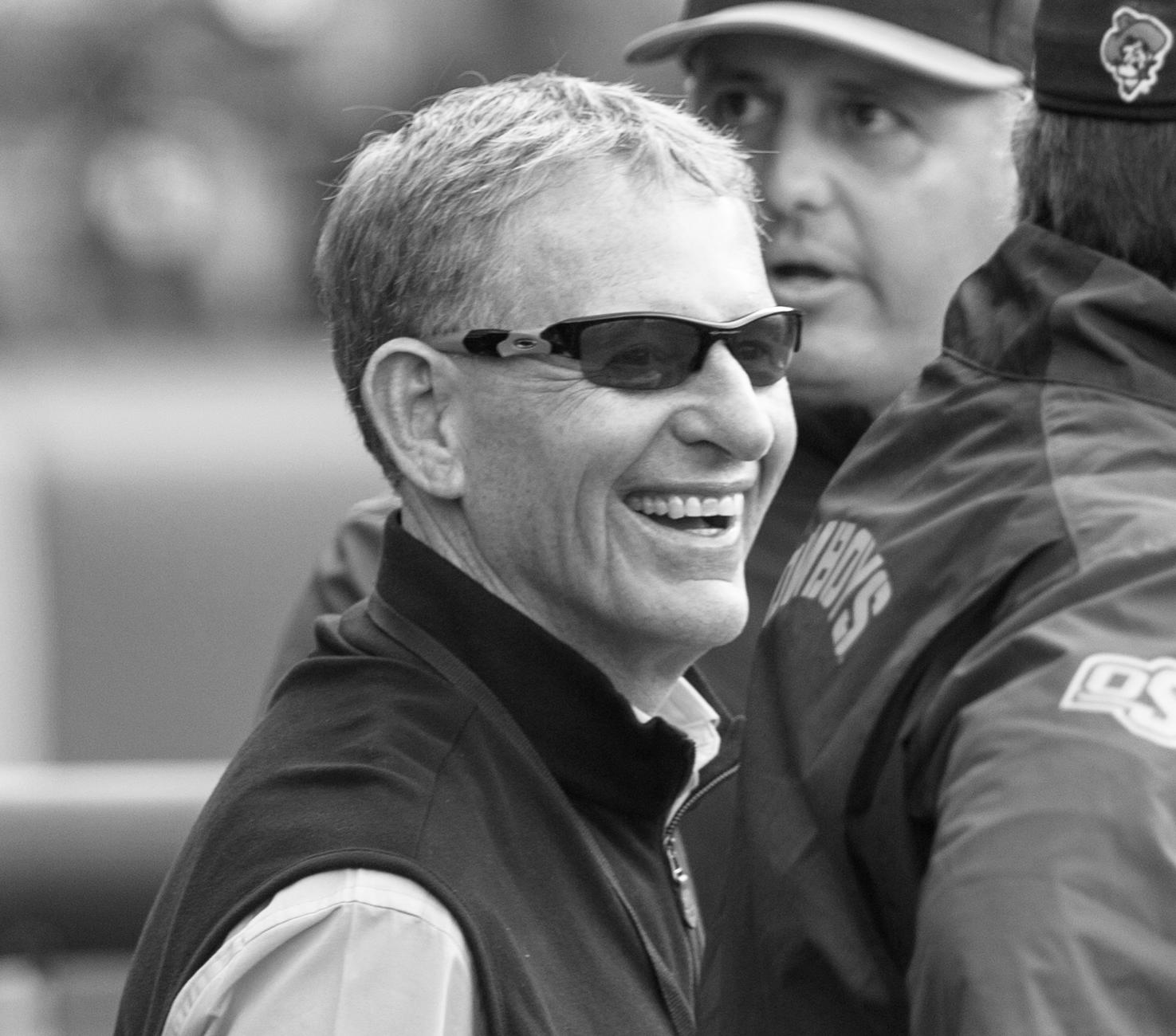
SPRING 2018 56
Talk about your first days as Athletic Director
I felt like I was on the deck of the Titanic. I managed to jump off, but I didn’t have a life jacket. It was just a whirlwind. I had no idea what an athletic director did. It was just getting to know people, going to meetings – trying to get my mind around what being the leader of an athletic department really involved. I had a sobering experience before my first day on the job. The Board of Regents met on a Friday and made me the athletic director, and we had a press conference. On Saturday morning, I had a meeting in the Student Union and was walking back to the stadium because we had a game that day. I’m walking across the stadium parking lot on the south side, and I just had a different feeling than I had had for any game ever. And you can imagine how many games I had seen. It just felt weird.
You always say you learned something that day
After the game was over, I thought being the athletic director is not quite as important as I thought it was. Because we had just put on a football game, and we had 40,000-plus in the football stadium, things were going on all over the place. We hadn’t had an athletic director since June, and things seemed to go off without a hitch. So if you think you are pretty important, just harken back to that day and understand in the grand scheme of things you are just a small part of a big enterprise. And you are not the most important thing in the department or on campus or anywhere you go to represent the university. It always comes down to how good your athletes are and how good your coaches are. Administrators should stay in the background.
Are you a better athletic director now?
I don’t know. You like to think that you get better. I’ve tried to get better. It’s like coaching. You remember the losses a lot more than the wins. It’s the same for an athletic director. The mistakes that you make are lot more painful than the joy you get from your successes. It’s a different perspective, because when you are coaching you have real skin in the game. You are a real part of what just happened. As an athletic director you’re not. You are always in the background. You are more of a facilitator. My first year, we won the national championship in wrestling, and John Smith wanted me to get in the team photo. I wasn’t getting in the team photo. I had nothing to do with it. That moment in time is sacred. It’s about the athletes and coaches – the people who are invested. Those moments are so rare. Even at a place like Oklahoma State where wrestling has won 34 national championships, there’s something to be cherished about a championship, so I didn’t have any reason to be in that picture. You won’t see me cutting down any nets or in any national championship team photos, and I don’t want any championship rings from the other sports. I had my moment in time, and I cherished it, but I’ve moved on. I’ve got another role now.
What are you most proud of as AD?
I don’t know that we’ve accomplished that much. I harken back to coaching. I won eight national championships as golf coach, but I think we should have won 16. So I’m more focused on why we didn’t win those other eight. It’s always about personnel. The toughest part of coaching is the players. It’s also the biggest joy that you have and the biggest challenge that you have. It’s no different for the athletic director. It’s personnel: hiring personnel, firing personnel, managing personnel. That’s everything because this is a people business. Unfortunately, these days, a lot of focus is on the money. But it will always be about the people.
If you are starting over, would you want to be a golf coach or an AD?
I’m going to be a golf coach. And this time I’m never, ever changing. Although if Boone Pickens asked me, I would have a hard time saying no to him.
57
“Unfortunately, these days, a lot of focus is on the money. But it will always be about the people.”
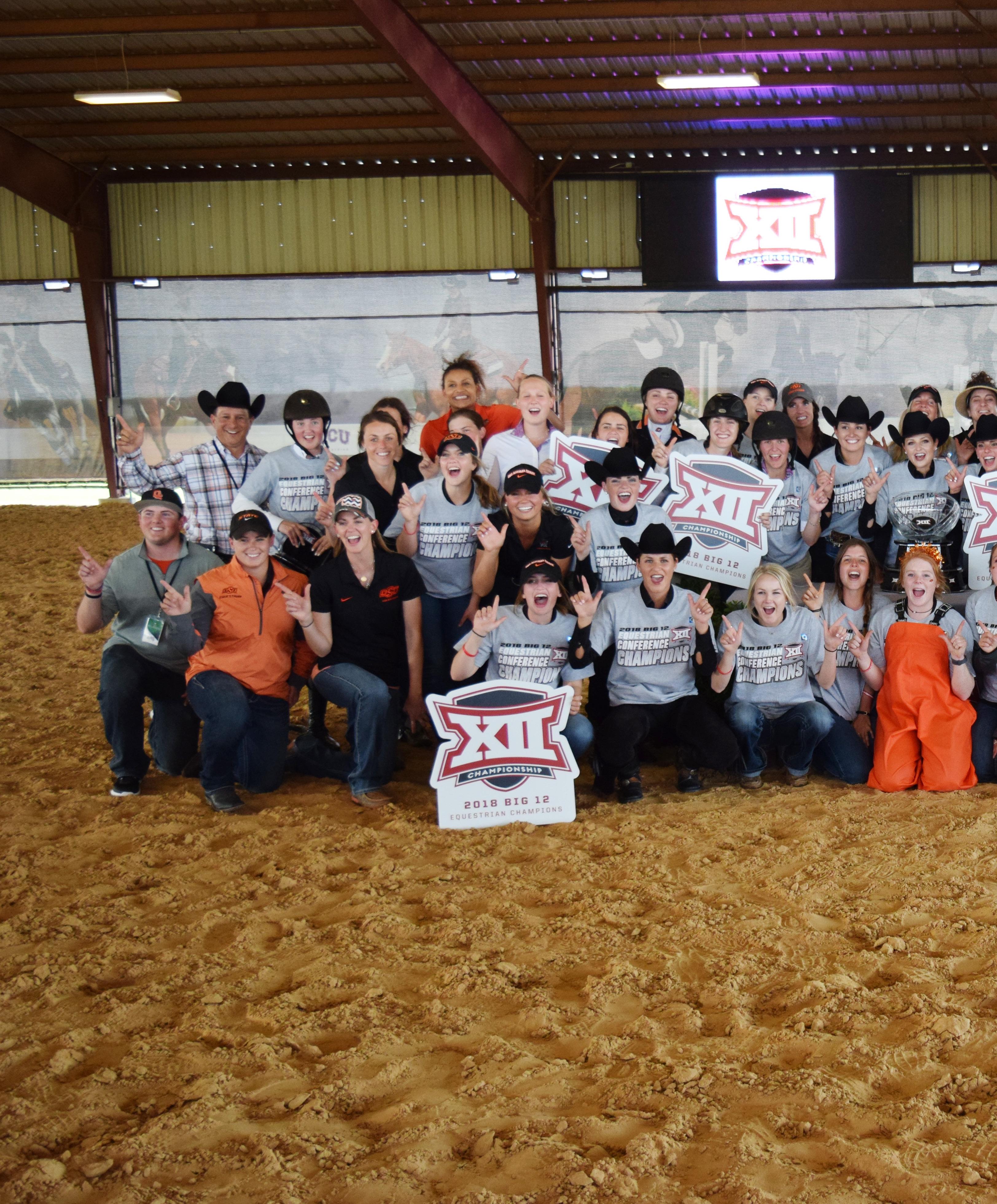
SPRING 2018 58
PHOTO BY PAIGE KEMPER
03/10/18
EQUESTRIAN WINS SIXTH BIG 12 TITLE
Cowgirl Equestrian claimed its conferencebest sixth Big 12 Championship this spring. Along with the team trophy, OSU picked up Most Outstanding Performer honors in all four categories: Abigail Brayman, Flat/Fences; Danielle Cohen, Reining; and Harley Huff, Horsemanship.
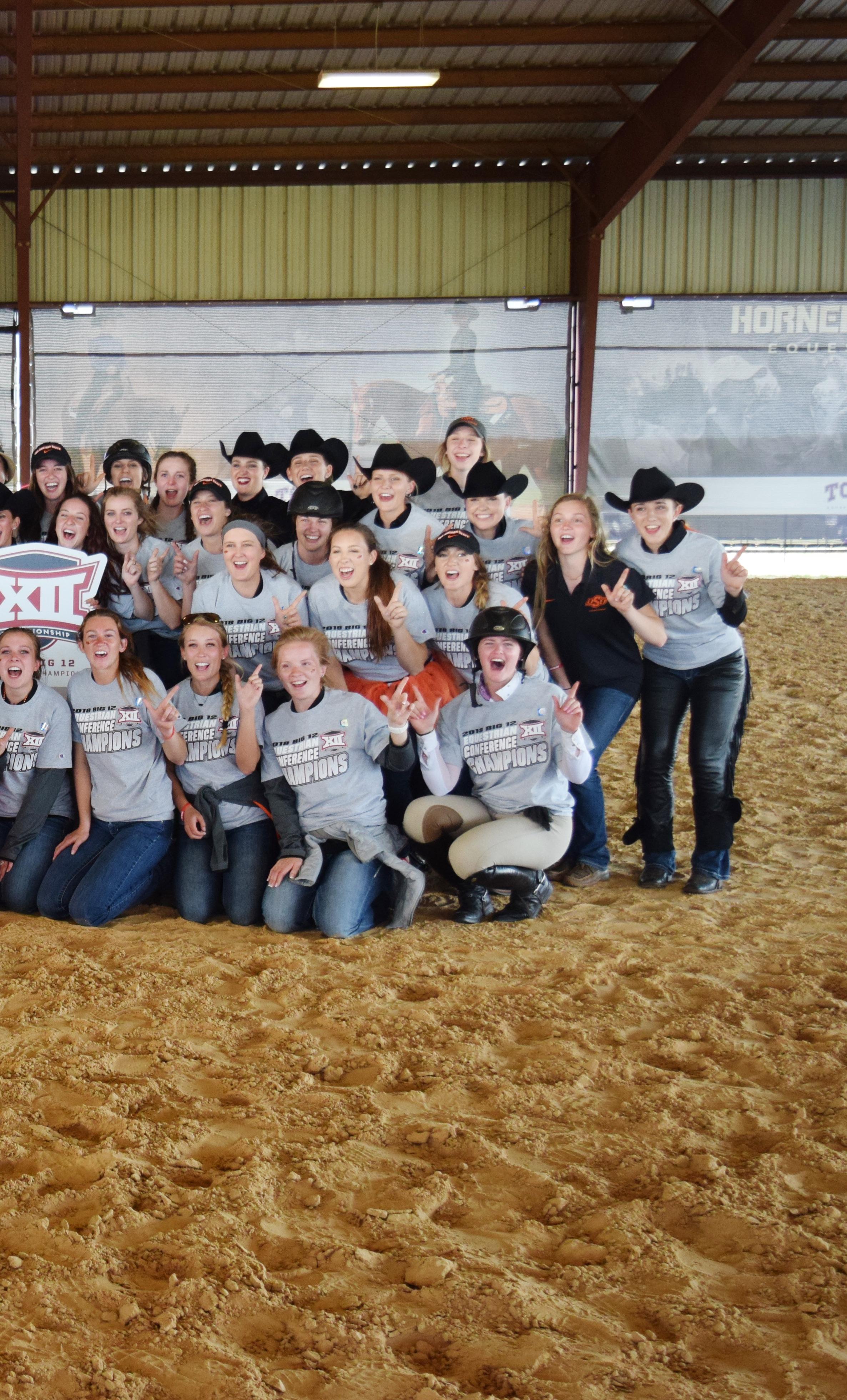
59
04/10/18
COWBOY FOOTBALL SPRING PRACTICE
Coming off a victory in the 2017 Camping World Bowl, Cowboy Football got back to work this spring with sights set on another successful campaign. Under head coach Mike Gundy, OSU has averaged 9.8 wins per season this decade, the 10th best mark nationally.
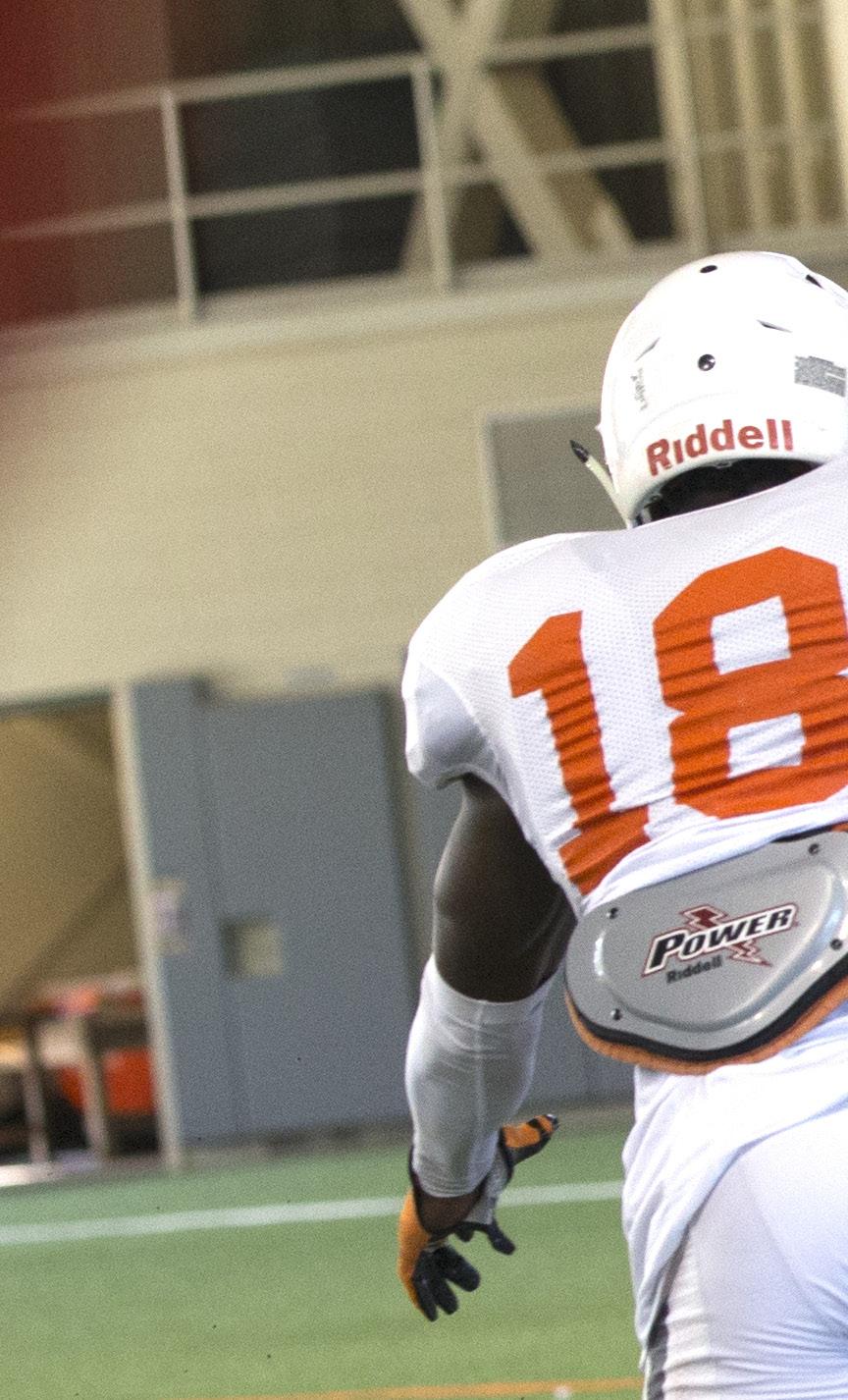
SPRING 2018 60
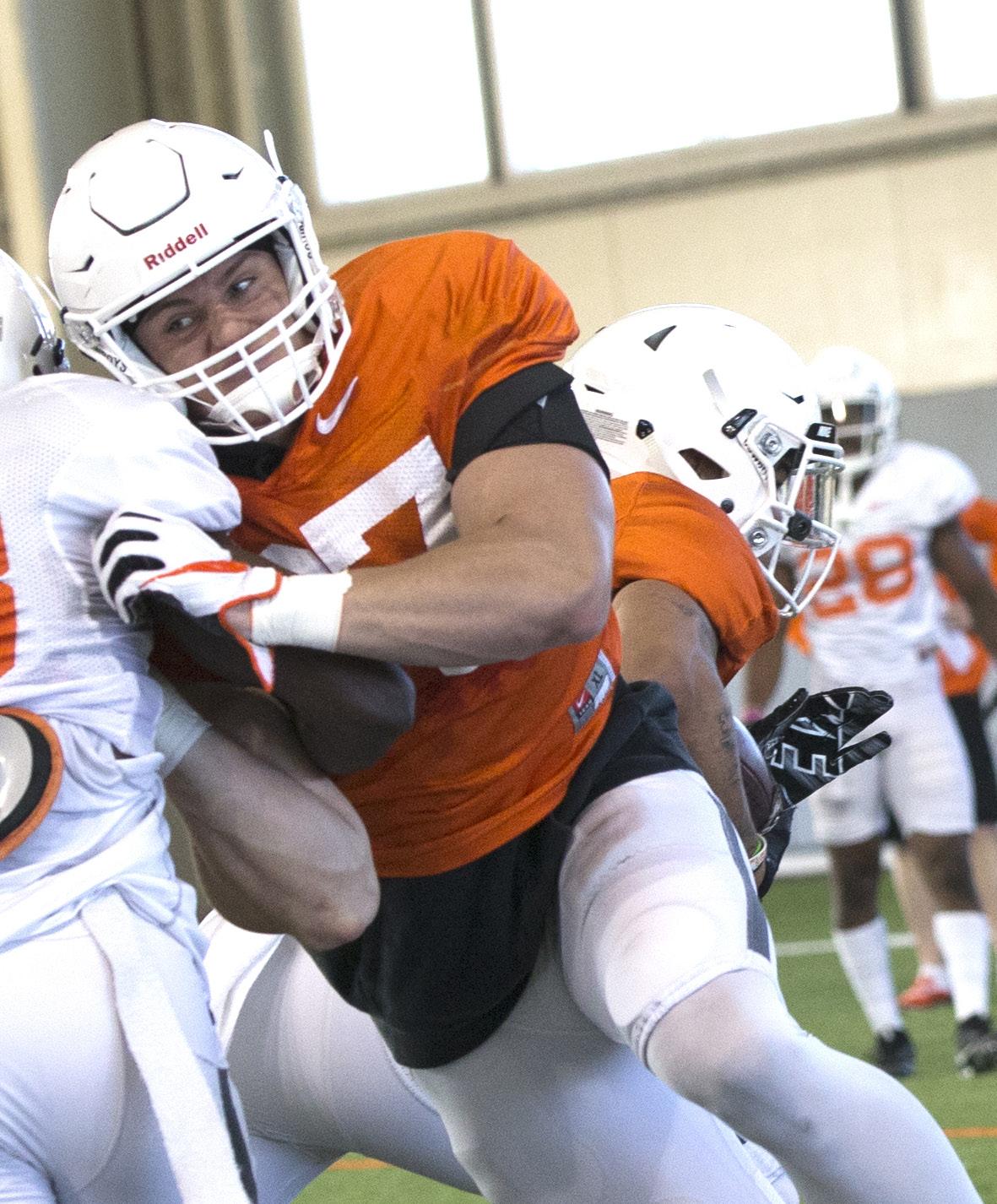
61
Hire America’s Brightest.

Hire OSU Grads.
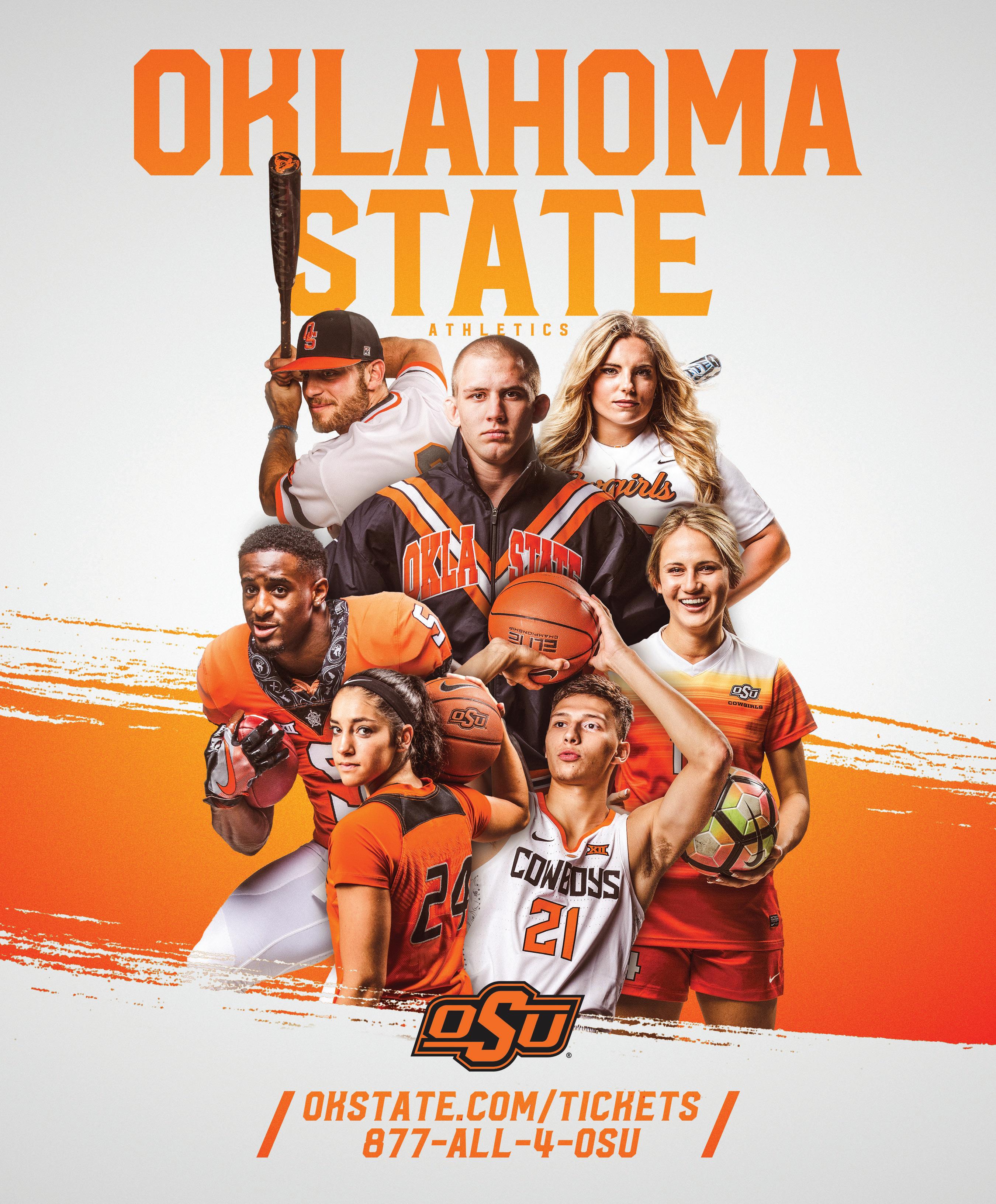
04/08/18 COWBOYS DEFEAT BAYLOR BEARS 4-3
The 14th-ranked men’s tennis team defeated No. 19 Baylor in dramatic fashion at the Greenwood Tennis Center, notching the program’s sixth victory over a ranked opponent this spring.

Senior Eleftherios
“Lefty” Theodorou provided the matchclinching point in a third-set tiebreaker.
SPRING 2018 64

ELEFTHERIOS
65
THEODOROU
TAYLOR LYNCH

SPRING 2018 66
03/24/18
COWGIRLS VS. CYLCONES 7-2
The 2018 OSU softball team has their eyes on the prize. Under coach Kenny Gajewski, the Cowgirls are poised for a thirdstraight postseason appearance.
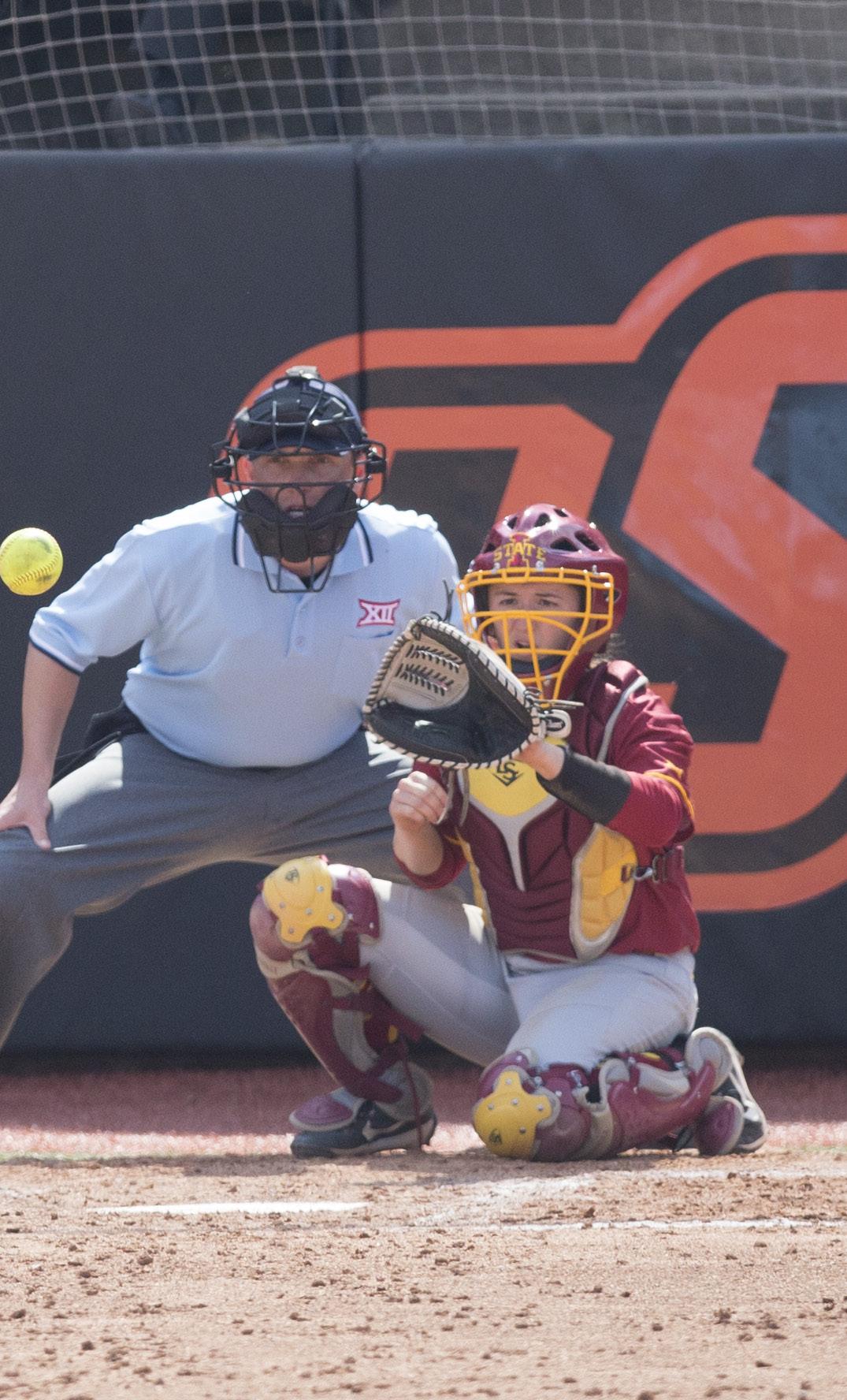
67
THE HONOR ROLL
When OSU announced its scholarship endowment initiative, the athletic program was last in the Big 12. Now, more than halfway through the 10-year program, OSU leads the conference.
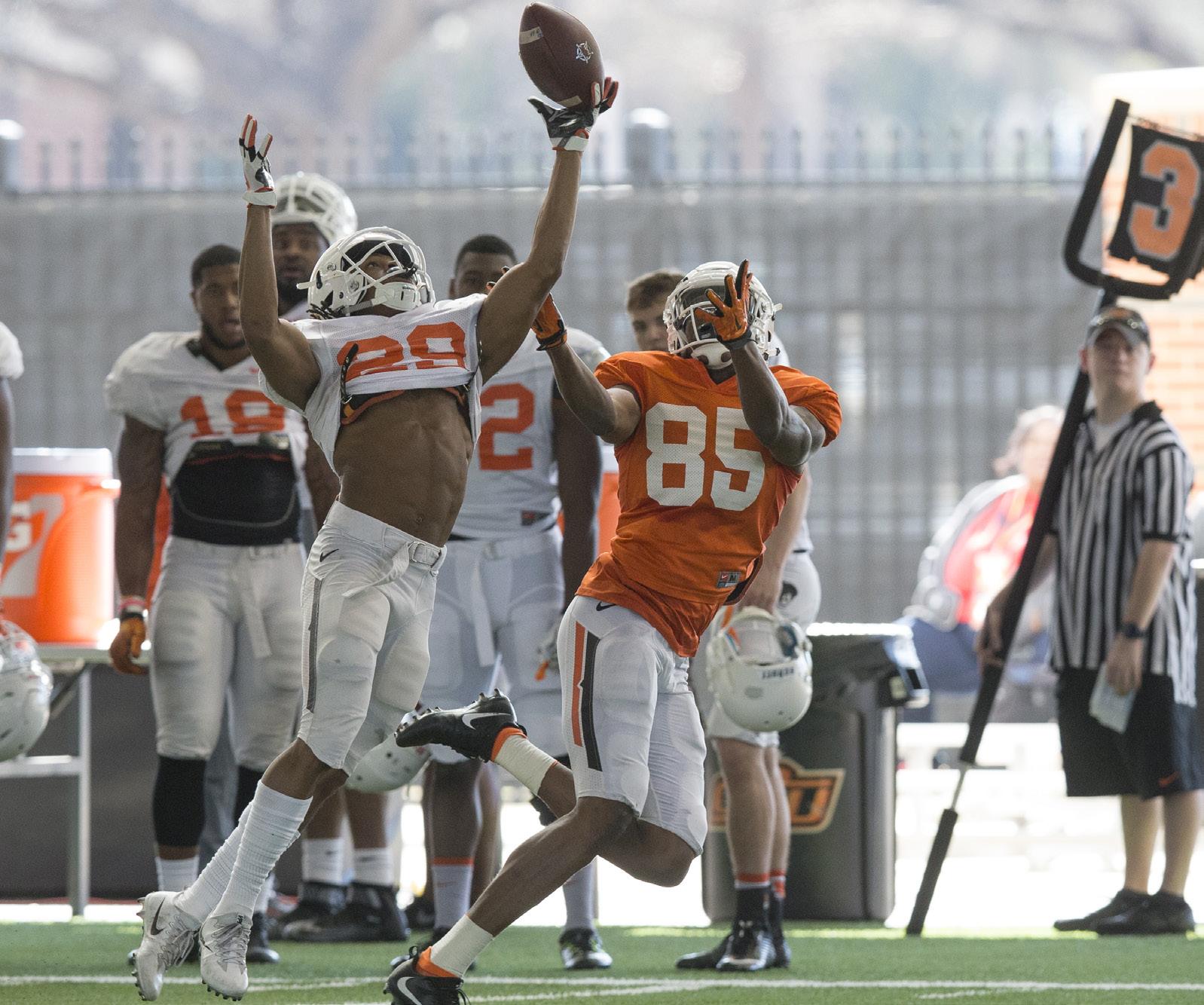
But we’re not finished yet.
OSU awards 229 full scholarships to studentathletes each year at a cost of $4.5 million. Each dollar freed up through endowed scholarships goes back into our programs. Better equipment. Better facilities. Better support. Each dollar has a direct impact on the lives of our student-athletes.
“Each scholarship we endow secures the future of OSU athletics and provides more opportunities for our student-athletes on and off the field,” says Mike Holder, Vice President for Athletic Programs and Director of Intercollegiate Athletics.
This is the list of all the generous supporters who have helped to provide a bright Orange future.
They are our Honor Roll.
Baseball
9.0
FULL SCHOLARSHIP
Dennis and Karen Wing (2) | Hal Tompkins
Sandy Lee | Jennifer and Steven Grigsby
Mike Bode and Preston Carrier (2)
HALF SCHOLARSHIP
Sally Graham Skaggs
QUARTER SCHOLARSHIP
Bryant and Carla Coffman
David and Grace Helmer | Jill Rooker
Martha Seabolt | Dr. Scott Anthony
John and Beverly Williams
Equestrian
0.25
QUARTER SCHOLARSHIP
David and Gina Dabney
Football
33.0
FULL SCHOLARSHIP
Bob and Kay Norris
Bryant and Carla Coffman / The Merkel Foundation
David LeNorman | Dennis and Karen Wing (2)
Dr. Mark and Beth Brewer
Jack and Carol Corgan Football Scholarship
Jim Click | John and Gail Shaw
Ken and Jimi Davidson | Leslie Dunavant
Mike and Kristen Gundy
Mike and Robbie Holder
Ron Stewart | Ross and Billie McKnight
Sandy Lee | Tom and Sandra Wilson
Wray and Julie Valentine
James and Mary Barnes
HALF SCHOLARSHIP
Cindy Hughes | Donald Coplin
Doug Thompson | Ed and Helen Wallace
Greg Casillas | Ike and Marybeth Glass
Jim and Lynne Williams / John and Patti Brett
Mike and Judy Johnson | Sally Graham Skaggs
State Rangers | Tom Naugle | Nate Watson
QUARTER SCHOLARSHIP
Al and Martha Strecker
Arthur “Andy” Johnson, Jr.
Arthur Couch | Barry and Roxanne Pollard
Bill and Ruth Starr | Brad and Leah Gungoll
Brian K. Pauling
Bridgecreek Investment Management LLC
Bryan Close | David and Cindy Waits
David and Gina Dabney | Dr. Berno Ebbesson
Dr. Ron and Marilynn McAfee
Eddy and Deniece Ditzler | Flintco
Fred and Janice Gibson | Fred and Karen Hall
Howard Thill | James and LaVerna Cobb
SPRING 2018 68
PHOTO / BRUCE WATERFIELD
Jerry and Lynda Baker
Jerry and Rae Winchester | John P. Melot
John S. Clark | Ken and Leitner Greiner
Kent and Margo Dunbar | Paul and Mona Pitts
R. Kirk Whitman | Randall and Carol White
Roger and Laura Demaree | Shelli Osborn
Steve and Diane Tuttle
Tony and Finetta Banfield
General
1.25
HALF SCHOLARSHIP
Terry and Martha Barker
QUARTER SCHOLARSHIP
David and Judy Powell
Kenneth and Susan Crouch
Sally Graham Skaggs
Graduate Athlete
0.75
QUARTER SCHOLARSHIP
Bob and Joan Hert | Neal Seidle
Tom and Cheryl Hamilton
Men's Basketball
22.25
FULL SCHOLARSHIP
A.J. and Susan Jacques
Bill and Marsha Barnes
Brett and Amy Jameson
Calvin and Linda Anthony
Chuck and Kim Watson
David and Julie Ronck (1.25)
Dennis and Karen Wing (2)
Douglas and Nickie Burns
Griff and Mindi Jones
James and Mary Barnes | Jim Vallion
Ken and Jimi Davidson
Kent and Margo Dunbar | KimRay Inc.
Sandy Lee | Mitch Jones Memorial
HALF SCHOLARSHIP
David and Julie Ronck
Dr. Mark and Susan Morrow
Jay and Connie Wiese | Sally Graham Skaggs
Stan Clark | Billy Wayne Travis
QUARTER SCHOLARSHIP
Dr. Scott and Lynne Anthony
Gary and Sue Homsey | Holloman Family
Michael and Heather Grismore
Rick and Suzanne Maxwell
Robert and Sharon Keating
Steve and Suzie Crowder
Terry and Donna Tippens
Men's Golf
4.25
FULL SCHOLARSHIP
David and Julie Ronck
Dennis and Karen Wing
Jack and Carol Corgan Men’s Golf Scholarship
HALF SCHOLARSHIP
Bank SNB
QUARTER SCHOLARSHIP
Bob and Elizabeth Nickles
Garland and Penny Cupp
Richard and Joan Welborn
Men's Tennis
0.25
QUARTER SCHOLARSHIP
Tom and Cheryl Hamilton
Men's Track
0.75
QUARTER SCHOLARSHIP
Dr. Mark and Susan Morrow
Susan Anderson | Ken and Leitner Greiner
Soccer
1.0
FULL SCHOLARSHIP
James and Mary Barnes
Softball
0.25
QUARTER SCHOLARSHIP
Tom and Cheryl Hamilton
Women’s Basketball
6.25
FULL SCHOLARSHIP
Brad and Margie Schultz
Ken and Jimi Davidson
Mike Bode and Preston Carrier
HALF SCHOLARSHIP
Baloo and Maribeth Subramaniam
Don and Mary McCall
John and Caroline Linehan
Calvin and Linda Anthony
QUARTER SCHOLARSHIP
Bill and Roberta Armstrong
Bill and Sally Cunningham
Donald Coplin | Jill Rooker
Richard and Linda Rodgers
Jo Hughes and Deborah J. Ernst
Women’s Golf
1.0
HALF SCHOLARSHIP
David and Julie Ronck
QUARTER SCHOLARSHIP
Amy Weeks | Kent and Margo Dunbar
Women’s Tennis
0.25
QUARTER SCHOLARSHIP
Jamie Maher
Wrestling
10.75
FULL SCHOLARSHIP
A.J. and Susan Jacques
Bruce and Nancy Smith
Chuck and Kim Watson
Lon and Jane Winton
OSU Wrestling – White Jacket Club / Gallagher Endowed Wrestling Scholarship
OSU Wrestling – White Jacket Club /
Myron Roderick Endowed Wrestling Scholarship
OSU Wrestling – White Jacket Club / Ray Murphy Endowed Wrestling
Scholarship
OSU Wrestling – White Jacket Club / Tommy Chesbro Endowed Wrestling Scholarship
The Cobb Family
HALF SCHOLARSHIP
Mark and Lisa Snell
Bobby and Michelle Marandi
QUARTER SCHOLARSHIP
Danny and Dana Baze / Cory and Mindy Baze
John and Beverly Williams | R.K. Winters
To learn more about scholarship opportunities and how you may contribute, please contact Larry Reece (405-744-2824), Matt Grantham (405-744-5938), Shawn Taylor (405-744-3002) or Keegan Davis (405-744-4201).
69
ORANGE-COLORED THROUGH GLASSES

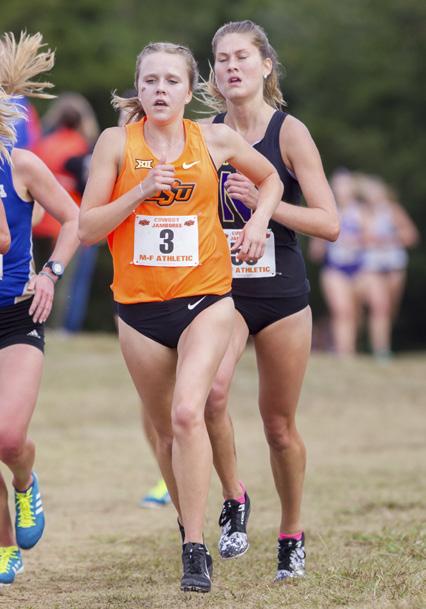
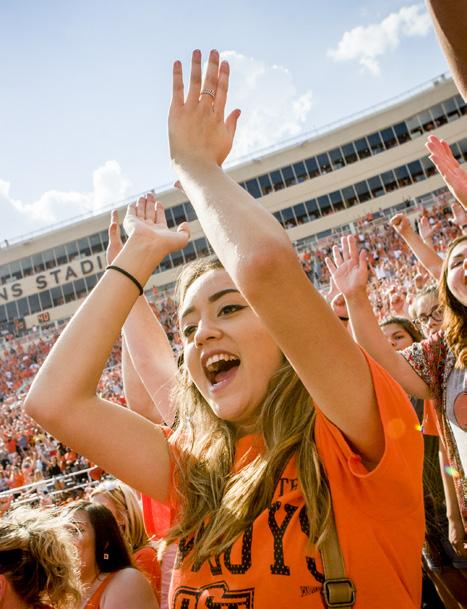
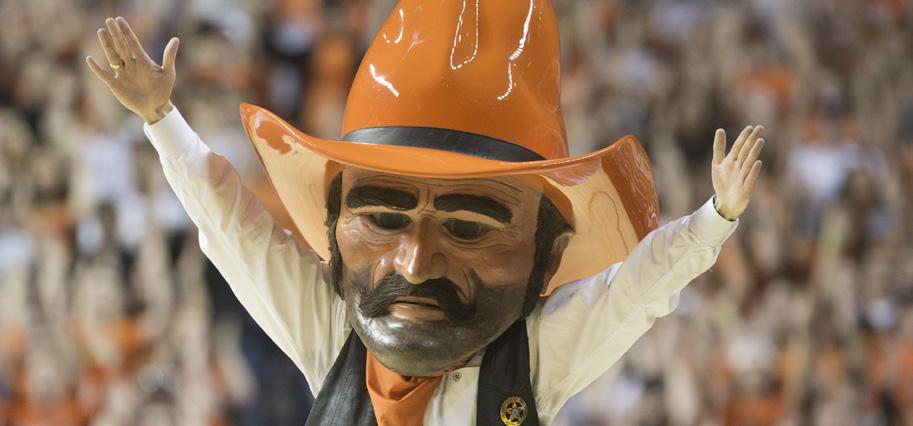 STORY BY JOHN HELSLEY
PHOTOGRAPHY BY BRUCE WATERFIELD
STORY BY JOHN HELSLEY
PHOTOGRAPHY BY BRUCE WATERFIELD
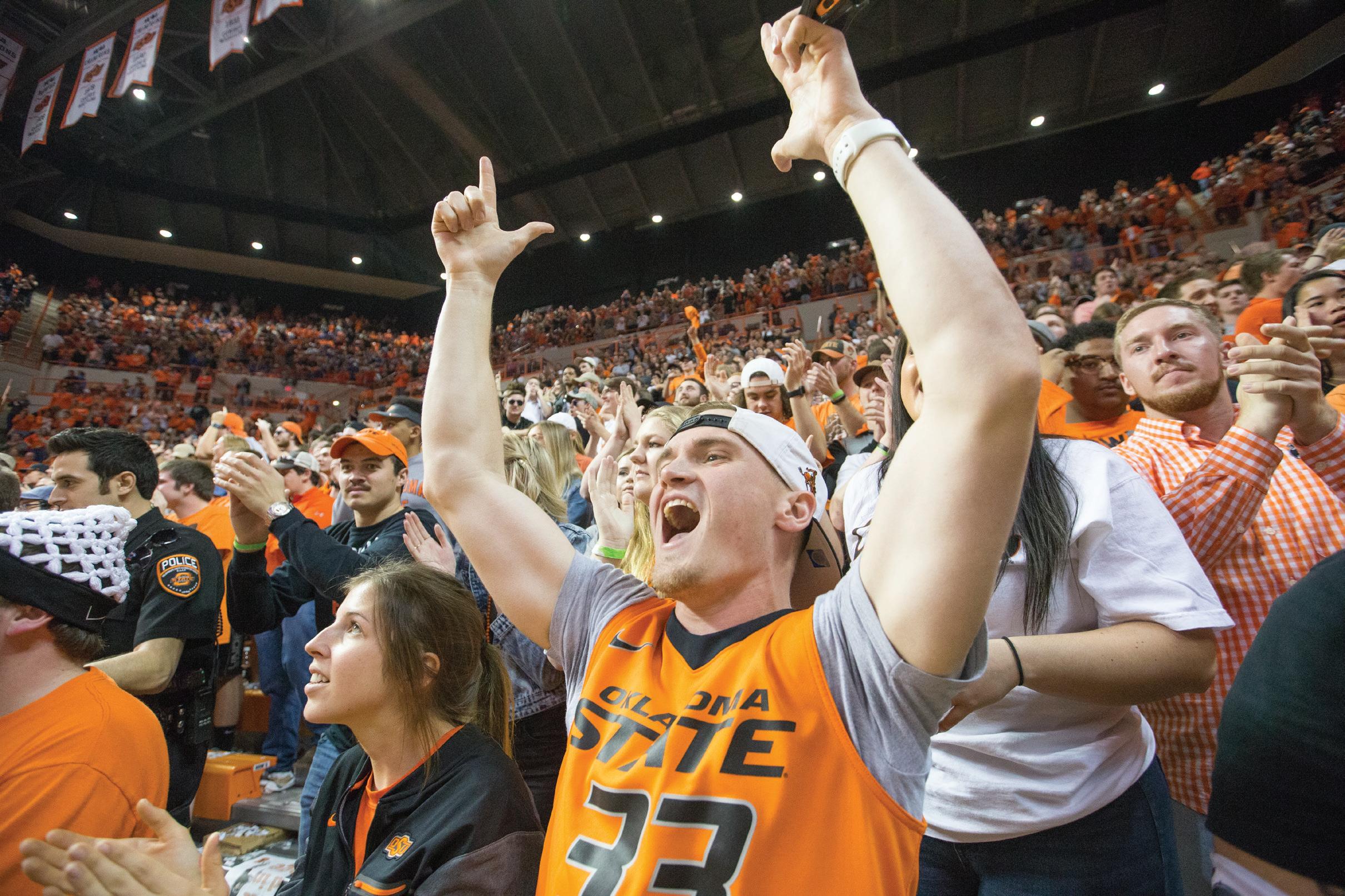

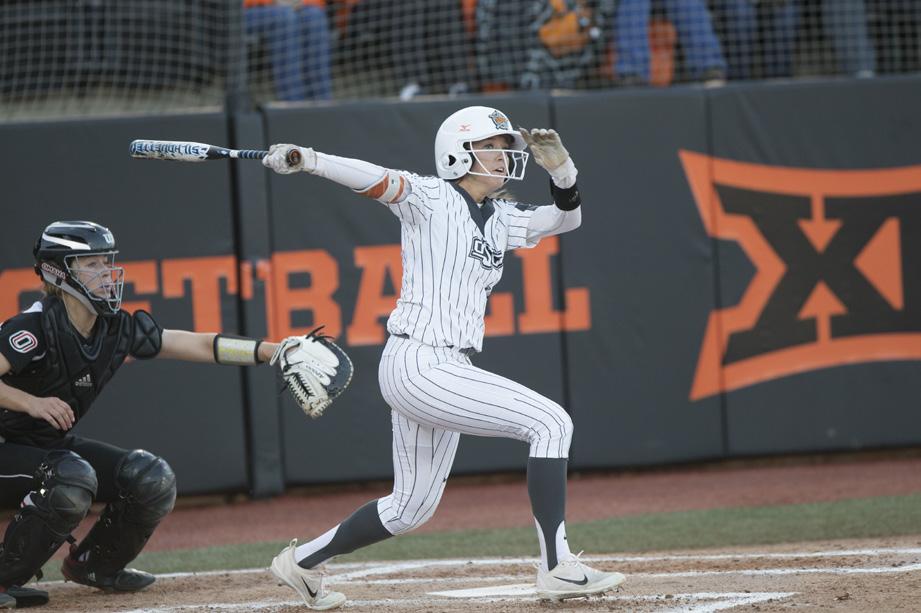
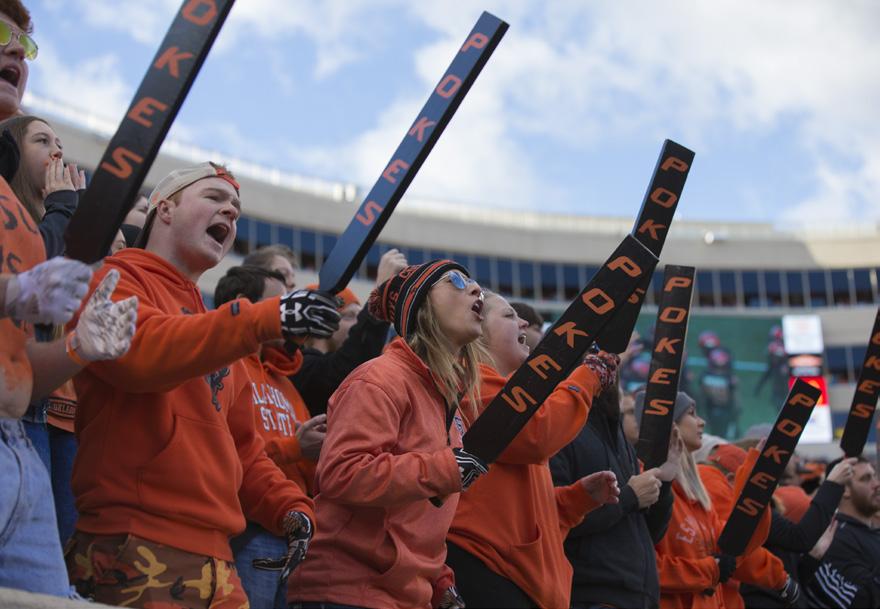
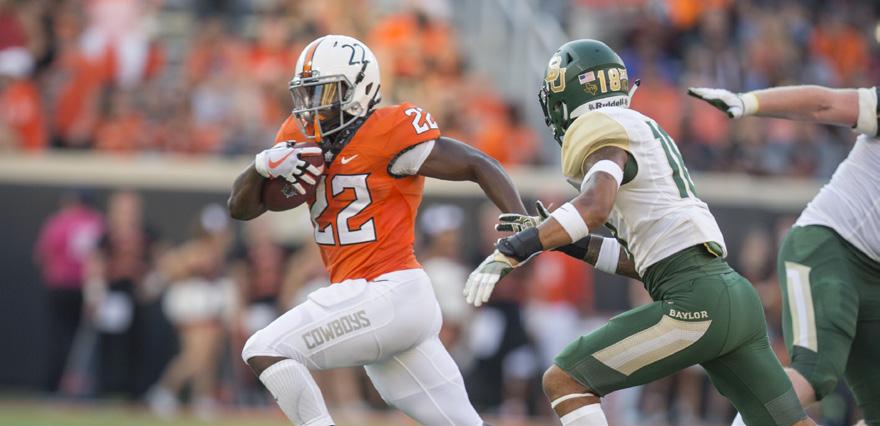

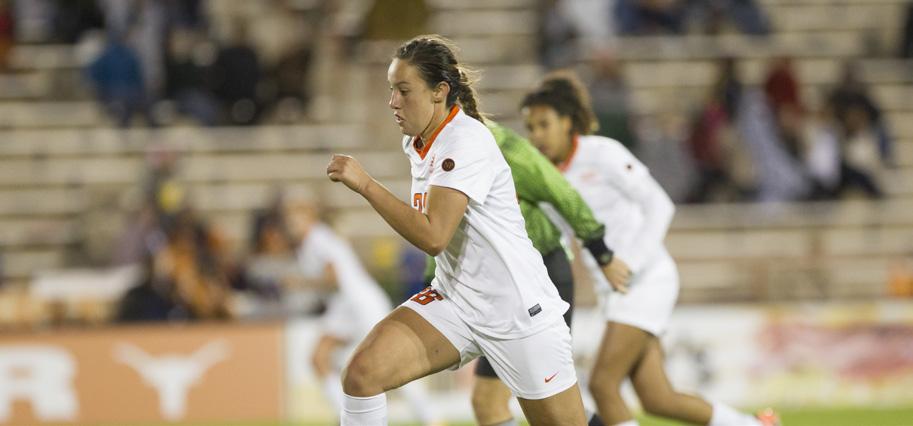
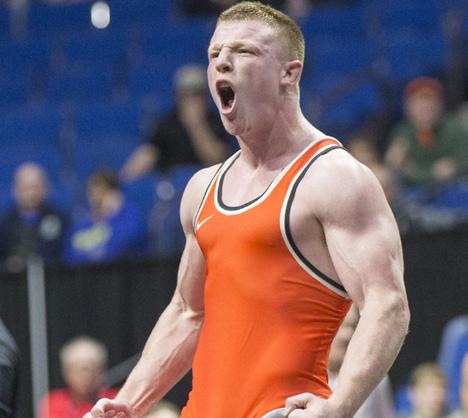
SPRING 2018 70
Yet behind the scenes is where the real work takes place, with a staff of seven pushing out another entertaining product through Orange Power Studios, the burgeoning creative arm of Oklahoma State Athletics charged with taking the fun to the masses, including fans, alums, recruits and the media.
Hardly just some random tweet, the Gundy Valentine’s bit was a tightly orchestrated and polished attempt to reach people and grab attention. Much like the “cinematic highlights” featuring OSU’s best moments from any given game—also an Orange Power Studios production.
The pregame hype videos, spread on Twitter and broadcast on the big screens at Boone Pickens Stadium and Gallagher-Iba Arena? Products of Orange Power Studios.

A number of live game broadcasts, spanning men’s and women’s basketball, baseball, softball, soccer, tennis and more, delivered on TV or via video streaming? Orange Power Studios.
OSU coaches shows, news conferences and interviews taped and shared through Twitter or YouTube? Orange Power Studios.
Those photo shoots of recruits, decked out in Cowboys gear and posing joyfully for shots shared across social media? Yep, Orange Power Studios.
So, what—and who—is Orange Power Studios, better known as OPS inside Oklahoma State Athletics? The in-house production hub
MIKE GUNDY EMERGED FROM THE SHADOWS,
sporting sunglasses and brandishing a saxophone, then serenading a young couple—all on Twitter—playing along in a promotion designed to attract Cowboys fans to Gallagher-Iba Arena for a basketball game competing with Valentine’s Day.
Finally, taking a break from his faux sax act, Gundy says with a jazzy cool, “See you in Gallagher.”
Gundy being Gundy? Yes, absolutely, as an ever-popular front man for his program and the university.
essentially serves as the athletic department’s own video company, working out of two multimillion-dollar control rooms in the west end zone of Boone Pickens Stadium.
You can see Gundy bouncing around with a sax or showing off in a wrestling singlet, or James Washington hauling in another long touchdown pass, or Mitchell Solomon diving on the GIA floor for a loose ball, or Kaylee Jensen powering for points in the paint, or the other faces of OSU sports. And all of these elements, once produced strictly by traditional media, now flow with heavy frequency from OPS.
“It’s all about original content,” says Kevin Klintworth, senior associate athletic director for communications. “We are an in-house media company. That’s really what we are. We cover all the bases.
“We have a magazine. And hold news conferences and produce news releases. We have a website, we produce live television as well as special programs. And of course we produce content for the social media platform flavor of the month.”
And, the way Klintworth tells it, it’s about time.
OSU is fairly new to a pool other schools have been wading in for years, some as far back as the 1990s. The department went online with OPS in the fall of 2014, first trying to claim its place in the third-tier television market, which is the live OSU sporting events passed over by the Big 12 television partners.
Before OPS launched, OSU basically relied on Cox Communications in Tulsa to help with everything from televising events to providing imaging for their big screens.
“Our video department was literally one of our graphic designers walking around the department with an iPad,” Klintworth says.
Meanwhile, the rest of the Big 12 was charging ahead technologically.
“I would say we were probably 15th in the Big 12,” Klintworth jokes. “Yeah, we were pretty far behind when we started. Everyone was in the digital age but us. It took a lot of planning. It took money. It’s an expensive start-up.
“And now I think we’re part of the game. We have a nice operation.”
The operation has grown. And is growing still. While the staffs at other schools may be larger, OSU’s creative crew won’t be outworked or outperformed.
“It’s really a talented bunch, and not a lot of people,” says Chris Deal, who serves as the director of digital media for OSU football and the man in charge of coachgundy.com. “What they’ve been able to do is really impressive.”
71
TEAM THE
ALLISON GAPPA coaches shows, producer
Oversees the entire operation and shepherded OPS through its infancy to where it stands today.
JEREMY DAVIS
director of in-house and third-tier productions
Creates content for multiple platforms (live event, social, in-game, web, etc.).
Helps manage and maintain control room and engineering equipment. Helps manage, train, and teach student workers. Also teaches classes for the School of Media and Strategic Communications.
GRAHAM
Creates content for multiple platforms. Main producer on the football and men’s basketball opens. Acts as the director of cinematography. Has an internship at NFL Films under his belt.
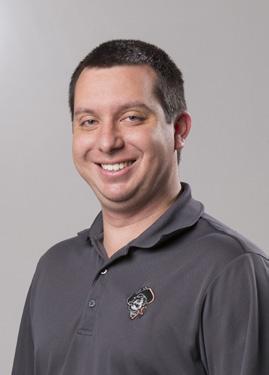

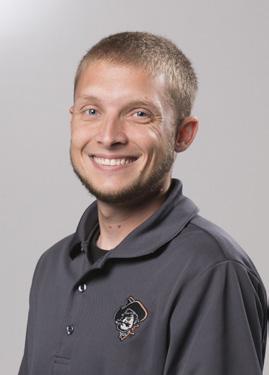
Creates content for multiple platforms. Sideline reporter for third-tier men’s and women’s basketball and in many ways is the face of Orange Power Studios.
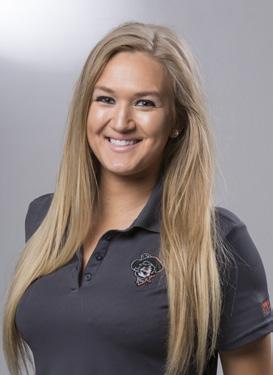
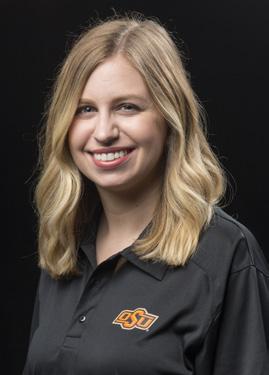
COURTNEY BAY
videographer and editor
Creates content for multiple platforms, with an emphasis on social media and a heavy emphasis on football content.
JEFFREY PARR
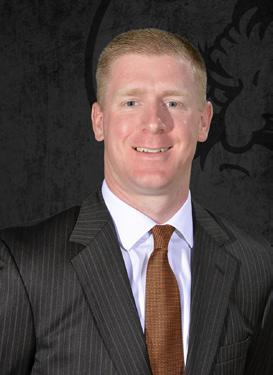


men’s and women’s basketball videographer and editor
Creates content for multiple platforms, with an emphasis on social media.
BRUCE
Provides photos of every sport to be used across every platform. He also handles photo shoots for recruits wishing to pose in OSU gear during official visits.
CJ LICKERT executive producer
TEWELL lead videographer and editor
football
WATERFIELD lead photographer
SPRING 2018 72
When the athletic department made the commitment to go all-in on OPS, the first hire was considered critical. And Lickert was Option A.
A veteran of several other studio startups, Lickert had also spent four years at Nebraska, working for HuskerVision, a frontrunner in the industry since the mid-1990s. Lickert was recruited as a Nebraska freshman by his older brother, Mike, who was already working at HuskerVision.
“I was actually pre-med when I went to school,” Lickert says now. “My brother is four years older than me, and he was a broadcast major. When I got there, I needed a part-time job, and he said, ‘Hey, change your major to broadcasting, we’ll hire you, then you can change it back to pre-med. But you need to be broadcasting to apply.’
“I switched it, took a couple of classes and realized it was a lot easier than chemistry and biology and all the other stuff I was taking my freshman year. I thought, ‘Maybe I’ll just stick with this.’”
And stick with it he has.
From Nebraska, Lickert went to work for Major League Baseball’s Tampa Bay Rays, opened studios at the Ted Constant Convocation Center at Old Dominion University in Norfolk, Va., and the Qwest Center in Omaha, spent six seasons with the NBA’s New Orleans Hornets—including one in Oklahoma City— before coming to OSU.
“I came in at a good time, because everybody wanted to make this move,” Lickert says. “And they put the money into it. When I took the job it was, ‘We might build a control room next year. And we might not build a control room for five years. It might just be you for five years until we get to that point.’
“We started doing some stuff and everybody was like, ‘Let’s pull the trigger and build one control room and see how it goes just doing our in-house stuff.’ We got that done, and once everyone saw how it was going— and it looked good—apparently they liked what we were doing over here, because they made the call to build a second control room and get into TV.
“We really have gone in five years from no video department to multiple people we have working here with multiple control rooms; and from not doing any television games to doing 40 or 50 each year.
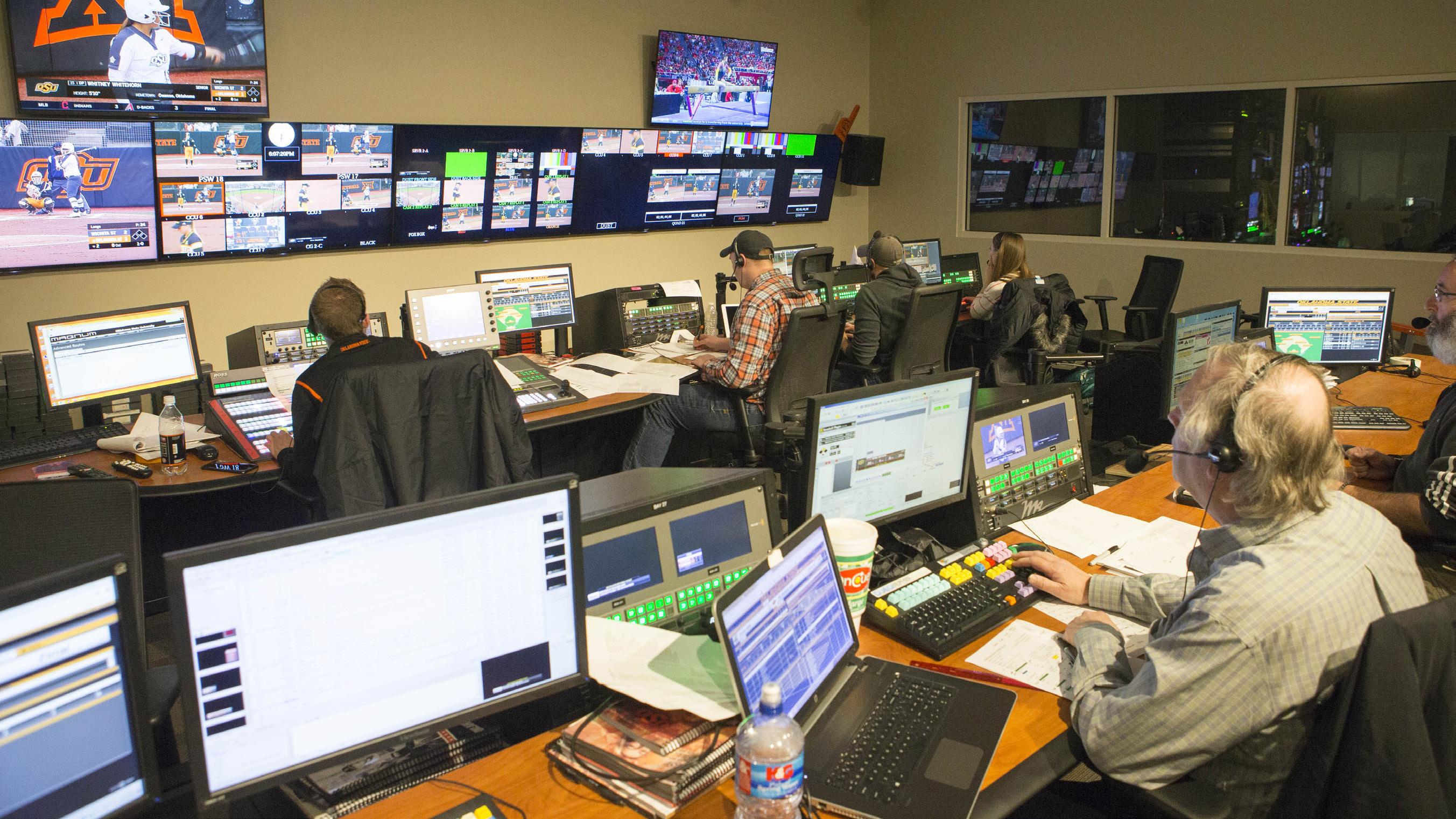
“We’ve really grown quickly. And I think we do a real good job. I go to other places where they’ve been doing it a while, and I think, ‘Hey, you guys have been doing this 20 years, and I like ours better.’”
“I get lots of backslaps for the OPS productions because OPS falls under my umbrella, but quite frankly, C.J. is the reason we are what we are,” Klintworth said. “He is completely at home on the technical side as well as the creative. We were a complete blank page and he took our dreams and ran with them.”
73
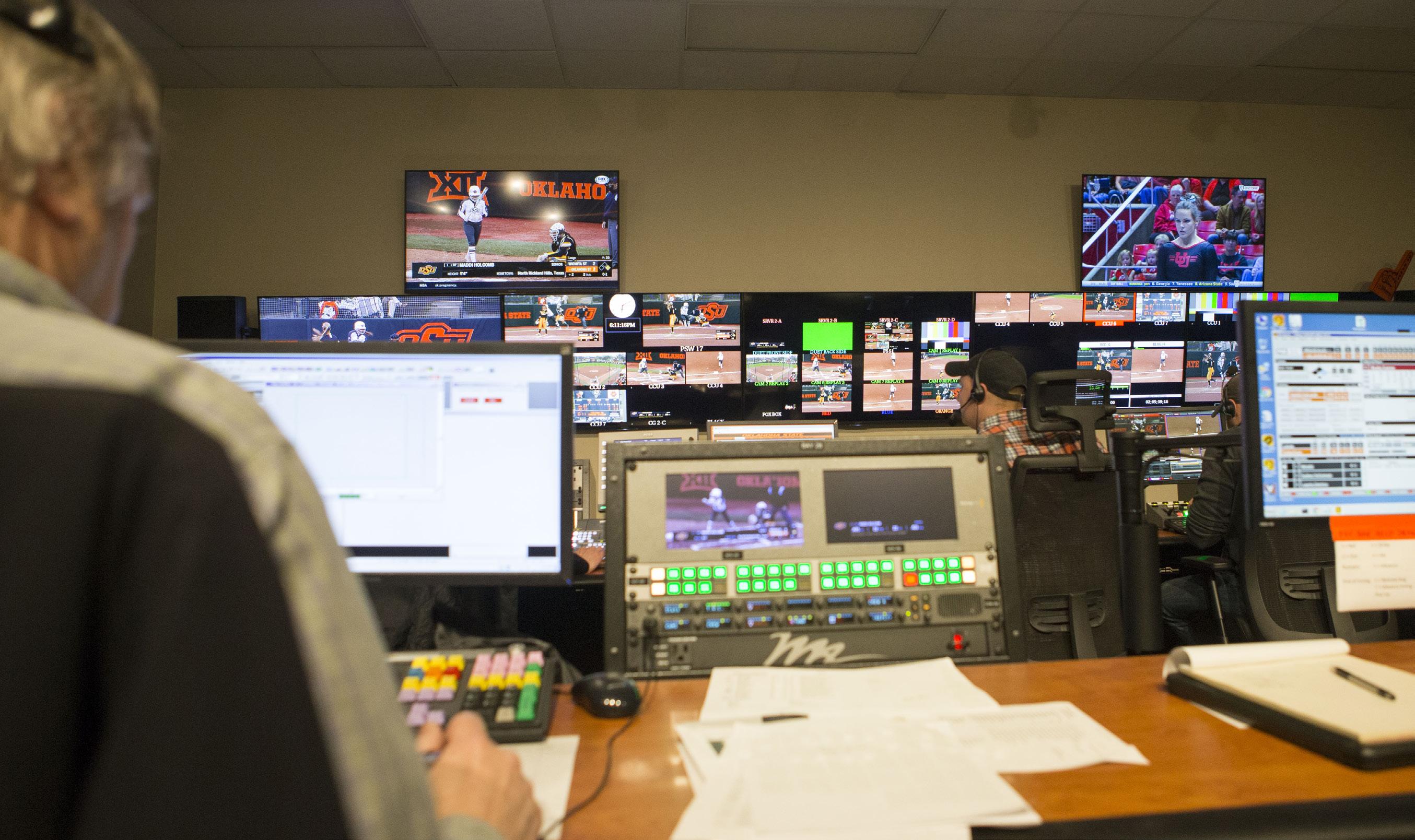
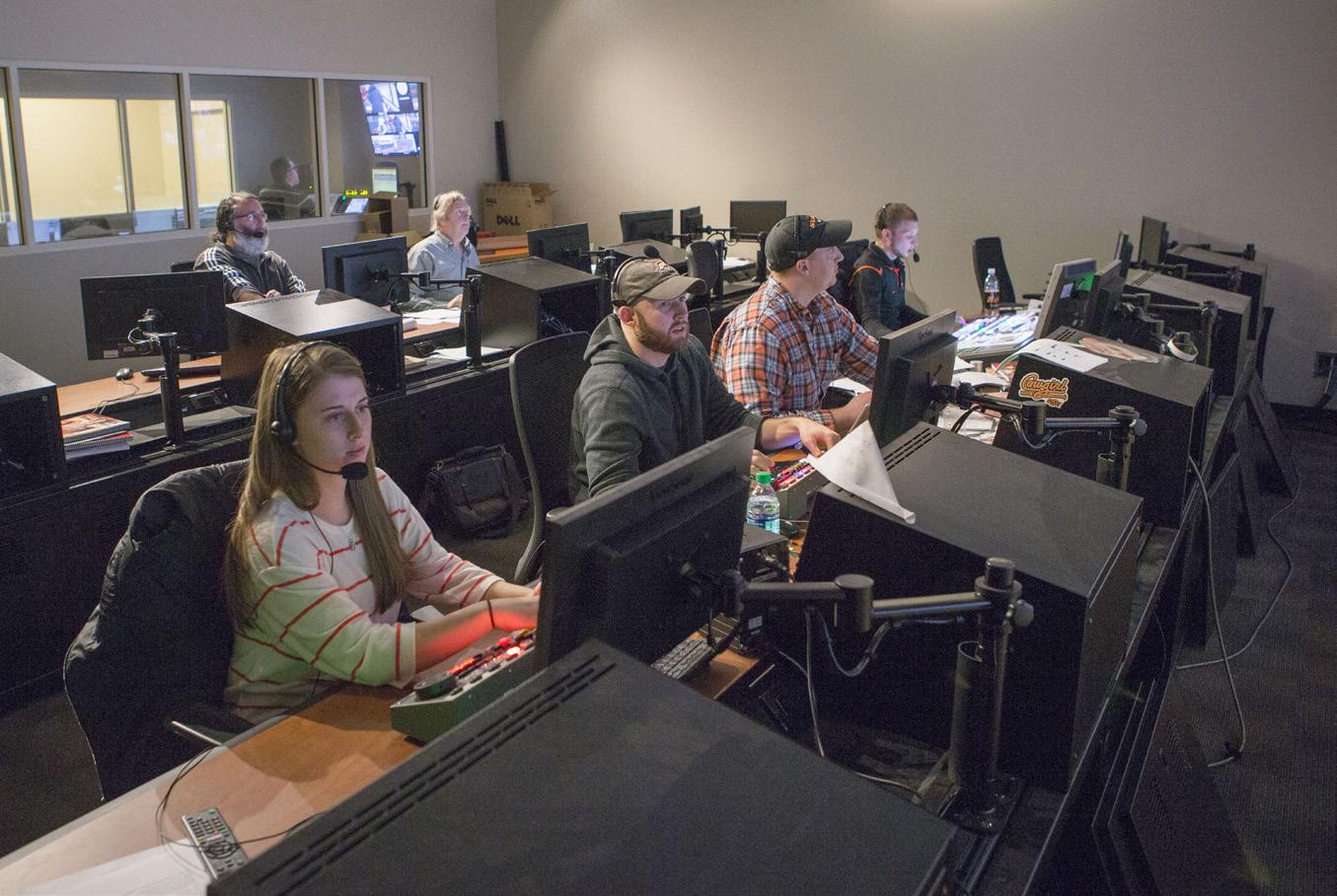
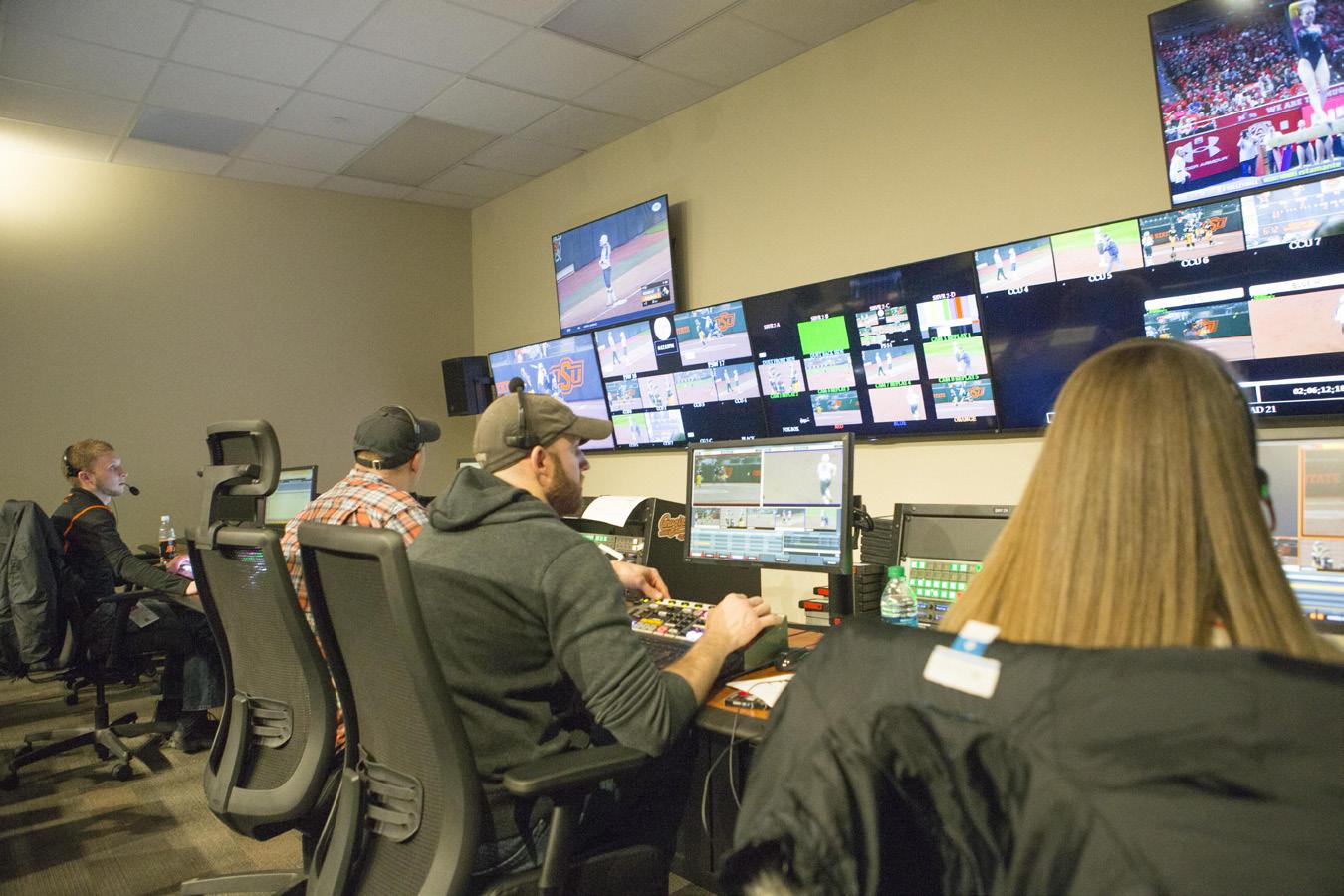
SPRING 2018 74
“IN THE BIG 12, where we don’t have our own network, you now essentially have your own digital platform in YouTube to stream sports.” — CJ LICKERT
Like the operation itself, the OPS reach keeps expanding. While thirdtier television remains important, the ability to impact recruiting has become an emerging focus, with the creative staff promoting OSU’s sports with a variety of content via social media, through the photo shoots with prospects and in expanding exposure of sports like baseball and softball through live streaming.
“You’re constantly trying to be in the feed of a young person’s social media account, with videos and social content,” Deal says. “You have to be able to compete on a digital platform of videos and graphics, because that’s where they’re living. In the recruiting world, they’re living on their phones.
“So that means we have to be able to produce content in-house with Orange Power or graphic designers so that we stay in their feed.”
“The role of video in social media and recruiting wasn’t even a consideration during our buildout,” Klintworth said. “Some of the most popular platforms didn’t exist back then.”
The social media channels are where OPS spreads the good news. That’s where uniform combinations and live in-game updates are shared. The content includes sound bites from press conferences and peeks inside postgame locker rooms. It’s where Mason Rudolph’s honors campaign was launched.
OPS also creates program-specific videos, spreading the culture and success of the school’s various sports to recruits who are connected through Twitter, Instagram and Snapchat. The videos highlight key aspects like academics, facilities, the game day experience and the training table. They provide a glimpse into Pro Day and alumni events.
And, of course, they emphasize success, whether tightly focusing on specific position groups, or capturing the hoisting of a championship trophy—delivering the moment instantly through social media, or more intently, with a link sent via direct message to a prospect’s cell phone.
The photo shoots have become increasingly popular during football official visits. And OSU holds an advantage with Waterfield, an accomplished photographer whose work is so strong that newspapers and magazines regularly seek his shots for their publications.
All within NCAA rules, prospects stop in for sessions with Waterfield, who patiently works with the players and their families for what amounts to a professional photo shoot, utilizing light kits and props, as well as the ultimate opportunity to slip into a uniform.
“Typically, that is a highlight of their day, to be able to put their jersey number on and a helmet on,” Deal says. “And you’ll usually see them send it out on social media. It’s become such a hit that men’s basketball has essentially copied the same approach.”
“Orange Power Studios is really part of the facility tour now, even when taking photos is not on the agenda,” Klintworth said.
Away from the major sports, non-revenue sports are enjoying recruiting benefits through OPS in a different way: live streaming.
For baseball, softball and tennis, exposure on the TV networks is limited. Live streaming, through the formation of the Oklahoma State Athletics YouTube channel, allows recruits a way to watch games or highlights or mini-features.
The production is improving, too, going from a single camera shot initially, to the use of five and six cameras now, with graphics and broadcasting talent in the booth calling the games.
“Softball and baseball have a huge following through the streaming aspect,” Deal says. “That’s been a big advantage for us. In the Big 12, where we don’t have our own network, you now essentially have your own digital platform in YouTube to stream sports.”
Lickert was hired in 2013, inheriting nothing but a blank slate and working with little more than a vision. Much has changed, and Orange Power Studios continues to charge ahead, albeit behind the scenes.
It’s not a glamour job. It requires many long hours and days. And it involves the usual frustrations that come with relying on equipment to perform flawlessly.
“A lot of times when the games are over,” Lickert says, “it’s like, ‘We won, right?’
Within OPS, they count their own wins. And it’s not always about how slick a production turns out, or how trendy they can be with graphics and prompts on the big screen.
“When things break, and nobody knows, I find that to be satisfying,” Lickert says. “Hey, there’s 60,000 people out there and we lost a camera or something, and were able to make it work. That’s what’s memorable for me.
“It’s stressful and a lot of times I’m running around. I definitely get my steps in on game day. I move at a pretty quick rate a lot of times. But even though it’s stressful, it’s, ‘Hey, we got it done.’ And you feel like you accomplished something.
“I’d say I’m really proud of where we are. In just the short amount of time we’ve taken to get here, we’ve grown by more than one person a year and I don’t know when that’s going to fizzle out. I think we’re doing a good job. And other people tend to think we’re doing a good job, because they want us to do more.”
75
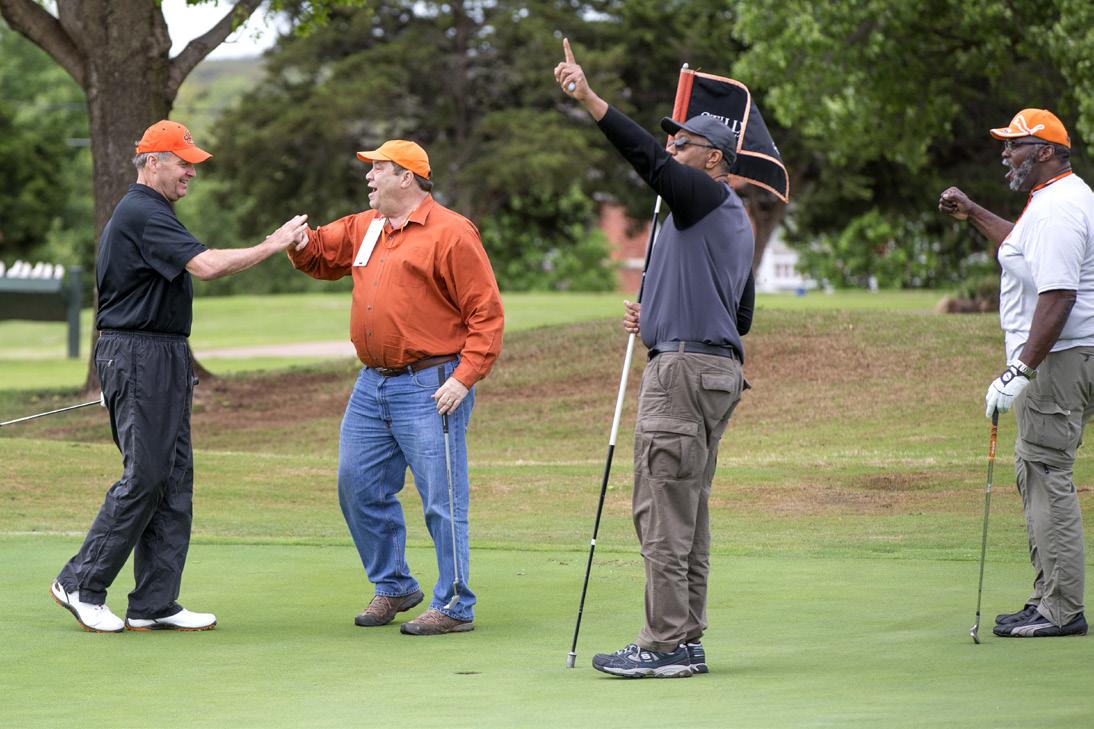
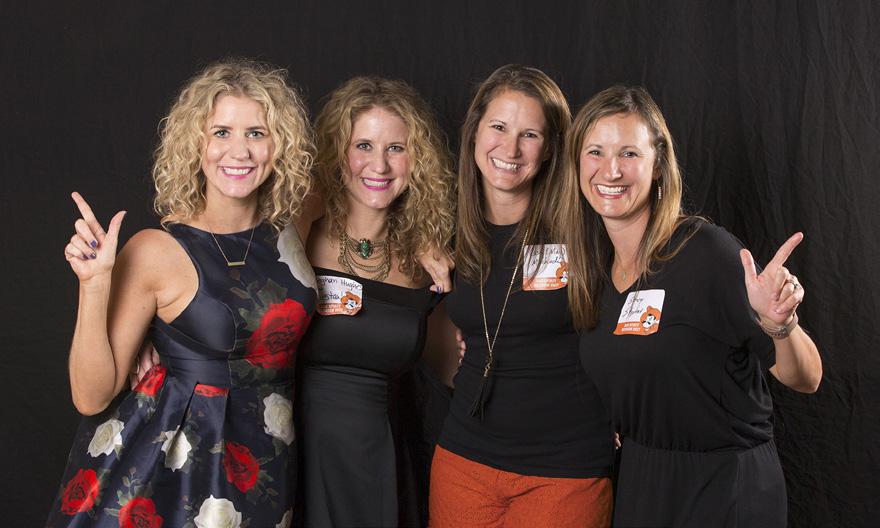
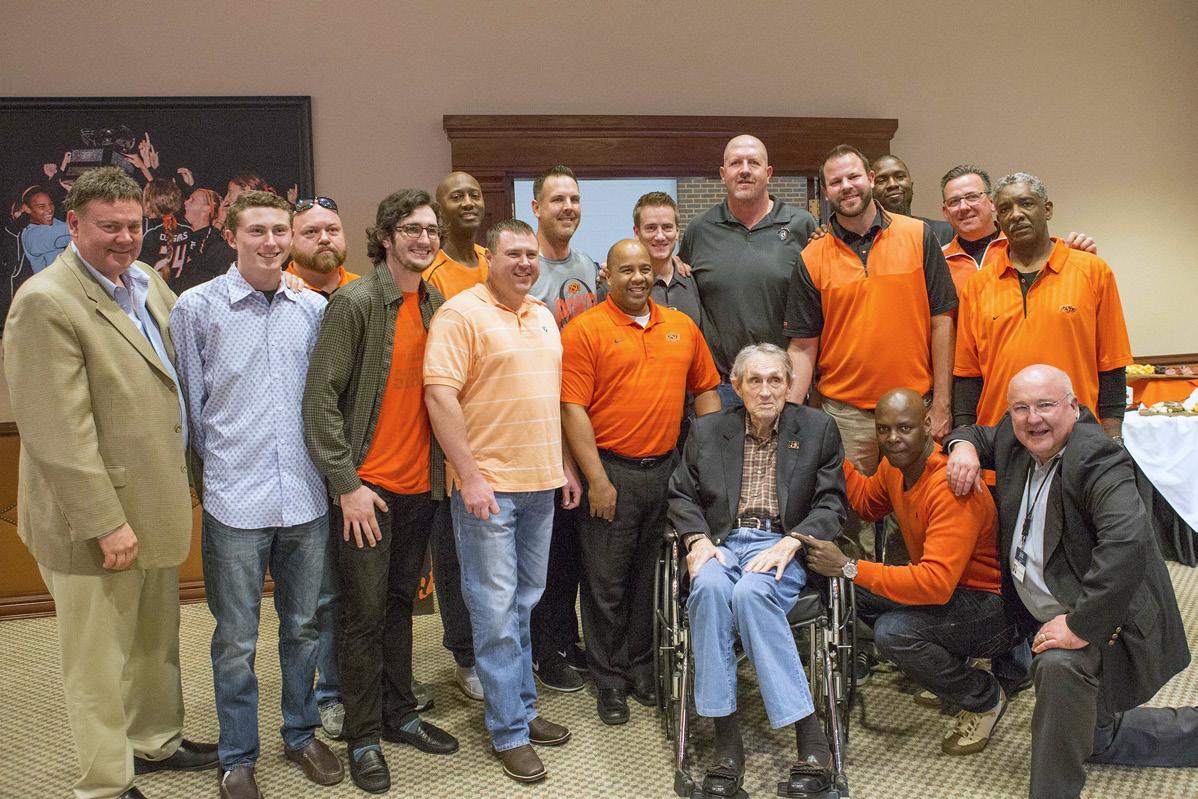
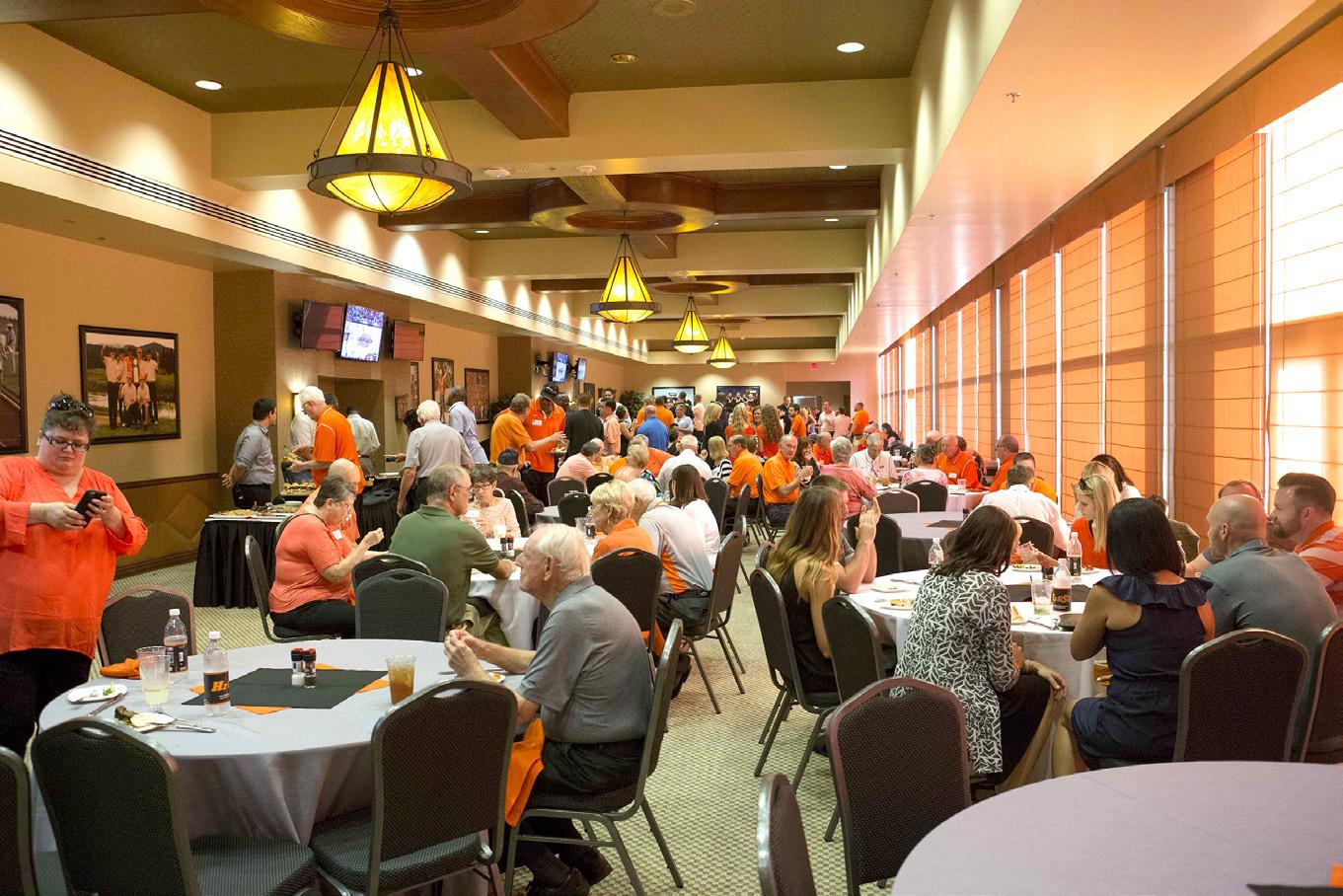
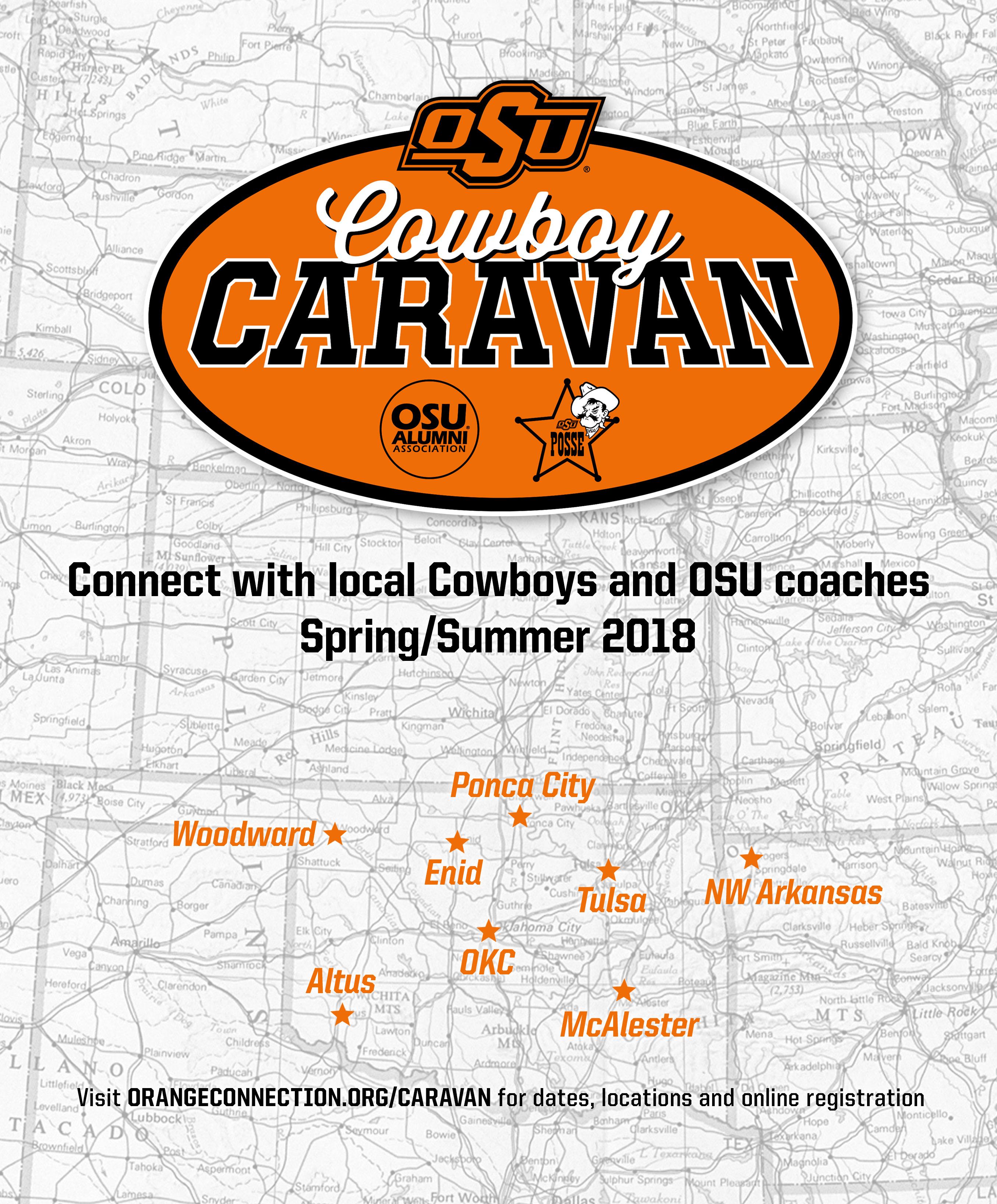
BASEBALL LESSONS
They also help us learn the converse of all those things. And I’m not talking about the competitor of Nike. We find out, as athletes and fans, what naturally happens when we compete. We learn how to win, which is not as easy as it sounds.
There are plenty of examples out there of people who do not know how to hit a shot, make a throw or get a hit without embarrassing themselves.
Losing. Losing is a problem of another color. Especially for fans. Often times, it’s not that the referees were biased, or the football was too slippery, or the coaches didn’t call a good game. Maybe on that particular day the other team was just better. Losing probably takes more skill and grace than winning. And contrary to what some may tell you, every team just gets beat. Sooner or later. It’s a fact.
One of the greatest lessons we can learn is by simply observing fans. We can see as many examples of whom we don’t want to be as whom we do. But there are times when a really positive one sneaks up on us.
When I was 12 or so, my dad took us to see a Tulsa Drillers baseball game. It was a treat we weren’t often allowed to experience. Even though I didn’t fully understand the concept of affordability at the time, I got the gist. We were standing in line to buy tickets outside of the stadium — which as you know, can be a form of entertainment in and of itself. There were busy folks of every size, shape and personality. People-watching is probably second only to baseball in terms of a national pastime.
The hawkers were selling candy, peanuts, popcorn and Cokes. As ticket holders milled around, the chatter of the growing crowds and their exchanges with others was attention grabbing. About the time I became spellbound with all of my surroundings, I noticed my father watching an interaction in front of us.
It was a lady and her two boys. They were about my age. And they were horrible. Their mother was searching her purse for money to pay for the tickets, and the boys were punching, pulling hair, spitting on each other and creating a real scene. I knew if I were acting that way, I wouldn’t be able to sit down once we got to our seats. Dad didn’t appreciate boys who didn’t know how to act. To my horror, I saw him inching closer to the situation. I mean, the lady needed help with those two little monsters, but I wasn’t really sure it was his place to interfere. As I watched, I soon realized he was not going to give them a lesson. He was looking at something else.
The lady had started to cry. Not at the behavior of her sons, but because she didn’t have enough money to get them into the game. She began to tell the ticket personnel she didn’t have the money, but they were more worried about the growing insurrection in line behind us as people got annoyed with 12-year-old boys and a mother who couldn’t pay for her tickets.
My dad turned his back toward the lady and retrieved his billfold from his pocket and pulled out a twenty. There weren’t many of those in there. He then walked up beside the lady and bent to the ground as though tying his shoe. He quickly stood up, handing the bill to the lady and said, “Ma’am, I think you dropped this.”
She reluctantly took the money, and the look on her face told me she was grateful for the gesture and for the preservation of her dignity all at the same time. All powerful lessons.
Me … I was more lost in the fact I couldn’t get the souvenir plastic batting helmet I wanted later inside the stadium. It would be several hundred lessons later before I understood what had really transpired.
I look around and see that Oklahoma State has great coaches. Women and men committed to teaching young people how to dedicate themselves to compete at the highest levels and how to act while the television cameras are rolling. It makes us proud our teams don’t sacrifice accountability and integrity for wins. Instead of putting up with bad behavior, our athletes receive life lessons. ORANGE ONES.
WRAY Vice President
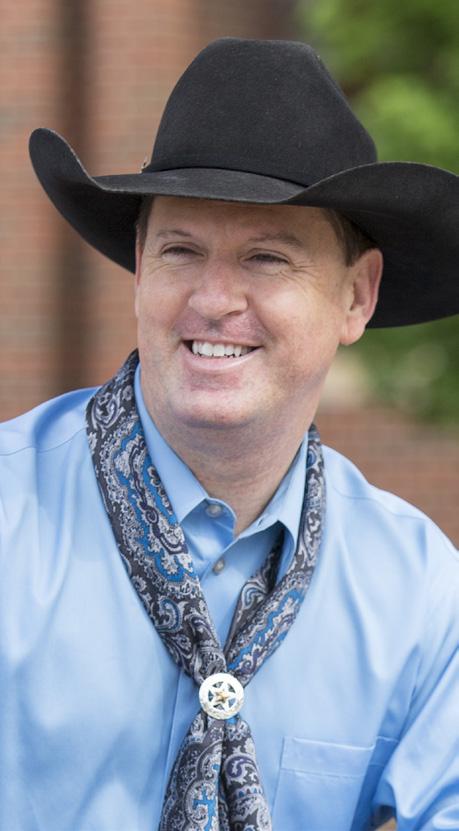 Management & Marketing
Kyle Wray OSU @KyleWrayOSU
Management & Marketing
Kyle Wray OSU @KyleWrayOSU
KYLE
Enrollment
GO POKES!
WRAVINGS
SPRING 2018 78
Sports can teach many great lessons. Hard work. Dedication. Focus. Teamwork.
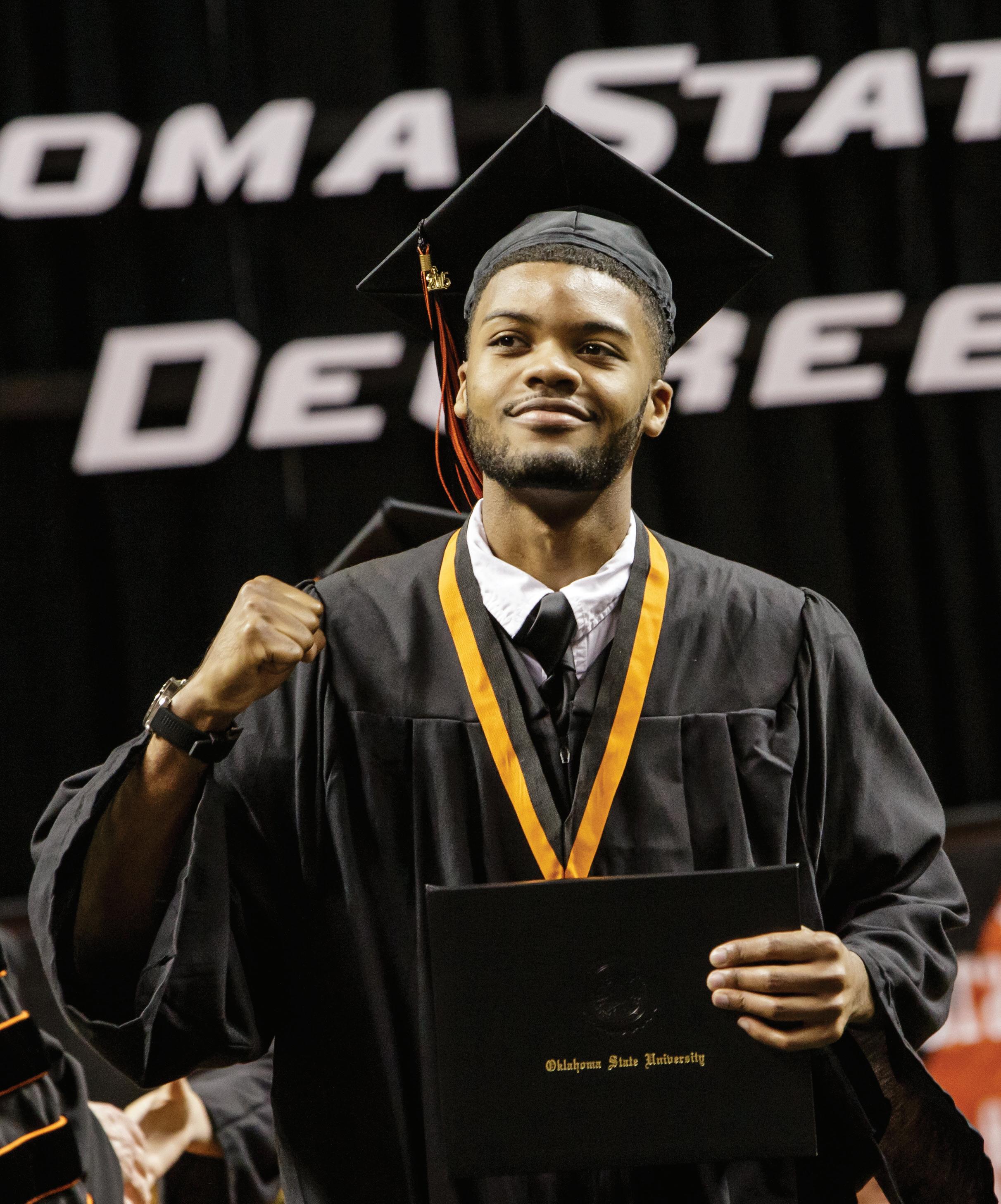

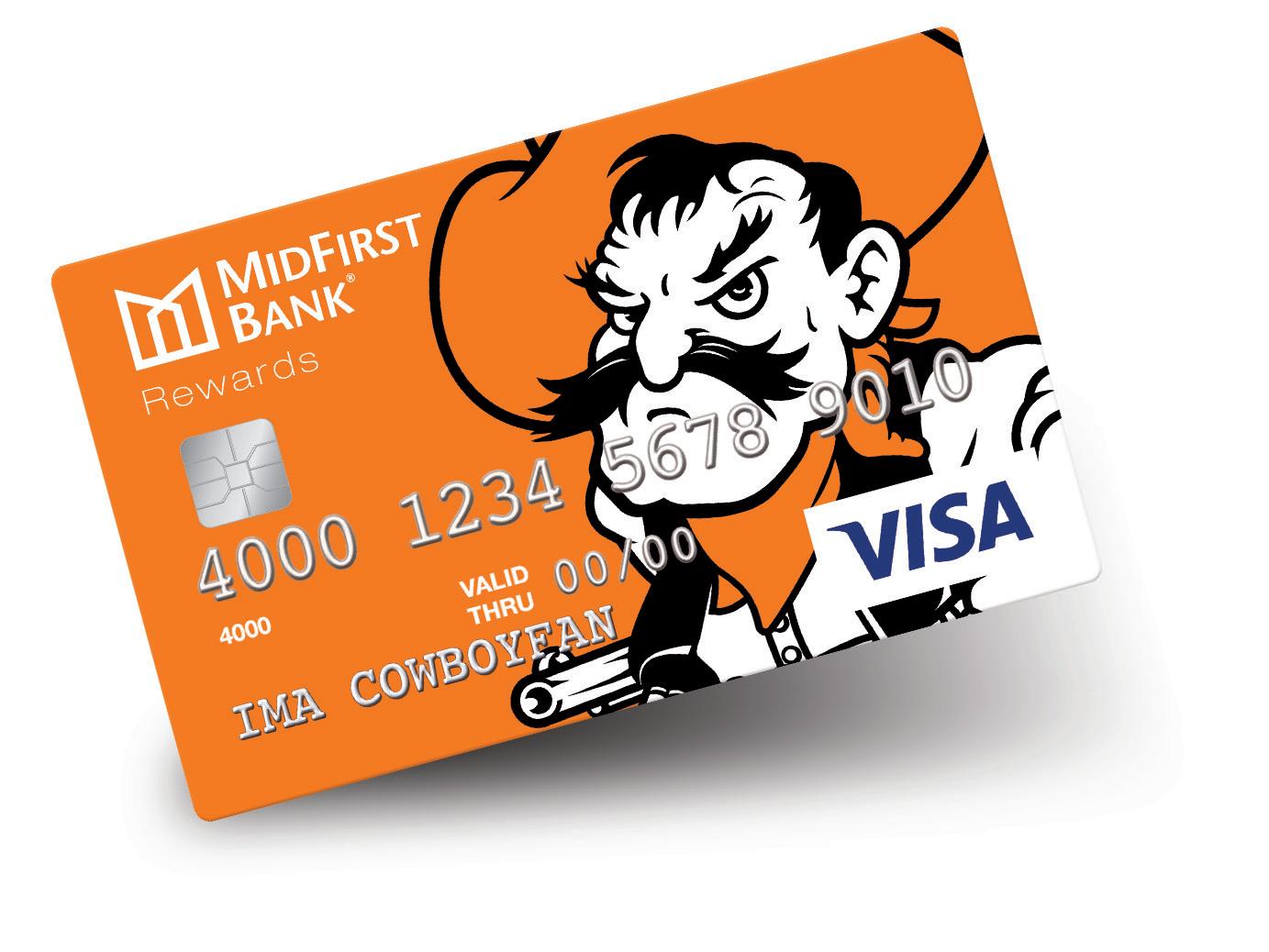

*Subject to credit approval Get your Pistol Pete Credit Card* today. midfirst.com /cowboys The diehard Card. For real Cowboys.
 MORGAN HOFFMANN LORYN GOODWIN GALLAGHER-IBA MIKE HOLDER ORANGE POWER STUDIOS
MORGAN HOFFMANN LORYN GOODWIN GALLAGHER-IBA MIKE HOLDER ORANGE POWER STUDIOS


















































 STORY BY RYAN CAMERON
STORY BY RYAN CAMERON



























































































 STORY BY JOHN HELSLEY
PHOTOGRAPHY BY BRUCE WATERFIELD
STORY BY JOHN HELSLEY
PHOTOGRAPHY BY BRUCE WATERFIELD
























 Management & Marketing
Kyle Wray OSU @KyleWrayOSU
Management & Marketing
Kyle Wray OSU @KyleWrayOSU



